Datalogic ADC PWRSCAN-BS Powerscan RF Base Station User Manual
Datalogic ADC, Inc. Powerscan RF Base Station
R44 114 manual
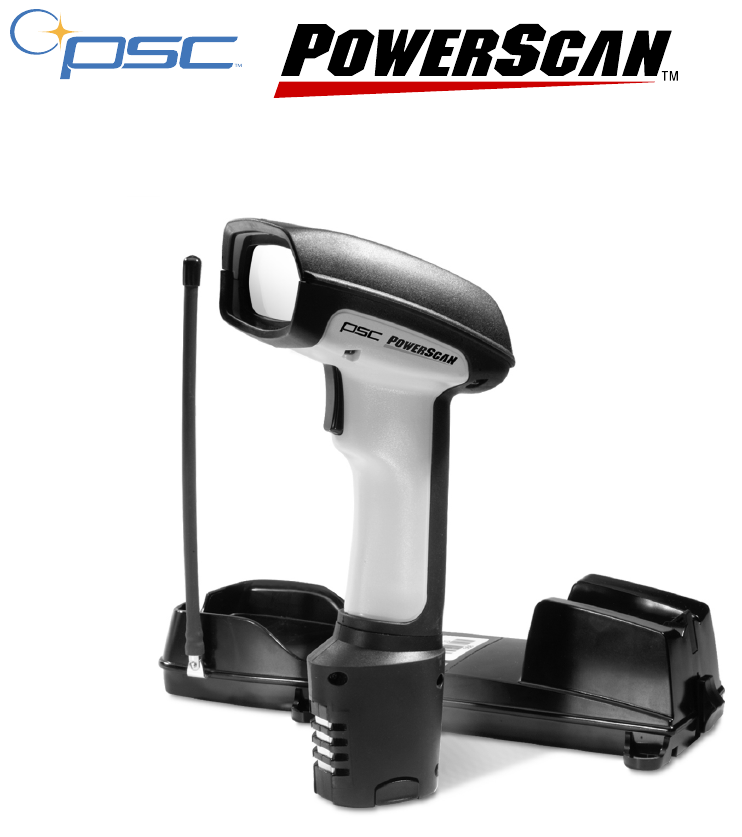
Systems Manual
RF

PSC Scanning, Inc.
959 Terry Street
Eugene, Oregon 97402
Telephone: (541) 683-5700
Telefax: (541) 345-7140
PSC, the PSC logo, Quadralogic and PowerScan are registered trademarks of PSC Inc. All
other trademarks and trade names referred to herein are property of their respective owners.
All rights reserved. No part of the contents of this documentation or the procedures described
therein may be reproduced or transmitted in any form or by any means without prior written
permission of PSC Inc. Owners of PSC Inc.’s products are hereby granted non-exclusive,
revocable license to reproduce and transmit this documentation for the purchaser’s own inter-
nal business purposes. Purchaser shall not remove or alter any proprietary notices, including
copyright notices, contained on this documentation and shall ensure that all notices appear on
any reproductions of the documentation.
Should future revisions of this manual be published, you can acquire printed versions by con-
tacting PSC Customer Administration. Electronic versions will either be downloadable from the
PSC web site (www.pscnet.com) or provided on appropriate media. If you visit our web site
and would like to make comments or suggestions about this or other PSC publications, please
let us know via the “Contact PSC” page.
Disclaimer
Reasonable measures have been taken to ensure that the information included in this
manual is complete and accurate. However, PSC reserves the right to change any
specification at any time without prior notice.

Systems Manual i
TABLE OF CONTENTS
Introduction................................................................................................................................1
About This Manual ..................................................................................................1
References ..............................................................................................................1
Product Description .................................................................................................2
Laser Cautions ..............................................................................................................4
Radio Frequency Interference .......................................................................................5
Quick Start Instructions ............................................................................................................6
Unpacking and Inspecting the Base Station ...........................................................6
Installation Procedures ...........................................................................................6
Installing the Battery ......................................................................................................7
Verifying Scanner Operation .........................................................................................8
Connecting the Base Station to the Host Terminal ........................................................8
Linking the Scanner to a Base Station ........................................................................10
Verifying Scanner-to-Base Station Communications ............................................10
Using the PowerScan RF System ..........................................................................................11
Battery Charging and Maintenance .............................................................................11
Tips for Extending Battery Life ..............................................................................12
Disposing of Batteries ...........................................................................................13
Four Station Charger ............................................................................................13
How to Scan ................................................................................................................15
Depth of Field ........................................................................................................16
Active Symbologies ...............................................................................................20
Enhanced Scanning for Hard-to-Read Bar Codes ................................................20
LED and Beeper Indications ........................................................................................21
Maximizing Signal Range ............................................................................................25
Three-Position Lock ..............................................................................................26
Mounting the Base Station .....................................................................................................27
Horizontal (Table or Countertop) Mounting ...........................................................27
Vertical (Wall) Mounting ........................................................................................29
Post or Forklift Mounting .......................................................................................30
RF Programmable Features....................................................................................................31
Programming Overview ........................................................................................32
What Is Programming Mode? ...............................................................................33
The Programming Session ...................................................................................34
Programming Sequence .......................................................................................36

ii PowerScan™ RF Scanner
Scanner vs. Base Station Features ...................................................................... 38
Interface (I/F) Selection ........................................................................................ 39
Universal Keyboard Wedge I/F Selection ............................................................. 42
Terminal/Keyboard Settings ................................................................................. 43
RF Beeper Settings ..............................................................................................44
RF When to Beep ................................................................................................. 45
RF When to Beep Options (continued) ................................................................. 46
Radio Transmit Power .......................................................................................... 50
RF Channel Selection ........................................................................................... 51
Transmission Retries Before Message Time-out ................................................. 53
Wait Time for ACK ................................................................................................ 56
Wait Time For Scanner Power Shutdown ............................................................ 57
Wait Time Between Retries of Failed Transmission .............................................58
HACK Transmit Options ....................................................................................... 60
Wait Time For HACK From Host .......................................................................... 62
Drop Links on Reset Option ................................................................................. 63
Drop Oldest Links Option .....................................................................................64
Common Configuration ......................................................................................... 65
Set Maximum Linked Scanners ............................................................................ 67
Source-Radio Identification (ID) ...........................................................................69
Low Battery LED Indication .................................................................................. 71
Maintenance and Troubleshooting........................................................................................ 72
Scanner Maintenance ........................................................................................... 72
Base Station Maintenance .................................................................................... 72
Four Station Charger Maintenance ......................................................................72
Troubleshooting .......................................................................................................... 73
If the Scanner Fails to Link with the Base Station ................................................ 74
Standard Warranty .................................................................................................................. 78
Exclusions ...................................................................................................................78
Limitations of Liability ..................................................................................................78
Assignment ................................................................................................................. 78
Risk of Loss .................................................................................................................78
Appendix A: Sample Bar Codes ......................................................................................... A-1
Appendix B: Number Pad .................................................................................................... B-1

Systems Manual 1
Introduction
About This
Manual
This systems manual provides information and instructions to connect
and configure your PowerScan™ RF system. The following sections are
included in the manual:
•Introduction presents general information about the contents of
this manual and about the system.
•Quick Start Instructions provide easy to follow procedures for
installing your system quickly.
•Using the PowerScan RF System provides details about scanning
basics, system controls and indicators.
•Mounting the Base Station demonstrates ways to securely attach
the Base Station to various work surfaces.
•RF Programmable Features is a set of procedures detailing sys-
tem configuration that is unique to the RF system.
•Maintenance and Troubleshooting provides solutions for prob-
lems that may be encountered during installation and use of
the system.
• is a statement describing the warranty policy covering the sys-
tem.
References Other manuals are available for this product. Printed copies can be
ordered through your distributor. Some manuals can be downloaded at
our website address listed on the back cover of this manual. Read the
terms of use and instructions at the site to download, save, view or
print the most current manual(s) from the internet.
Configurator Express™ On-Screen Programming offers a convenient way
to program your scanner using your PC. Information about ordering a
kit (includes software, adapter and cable) for your RF scanner can also
be accessed from our website (see the back cover of this manual).
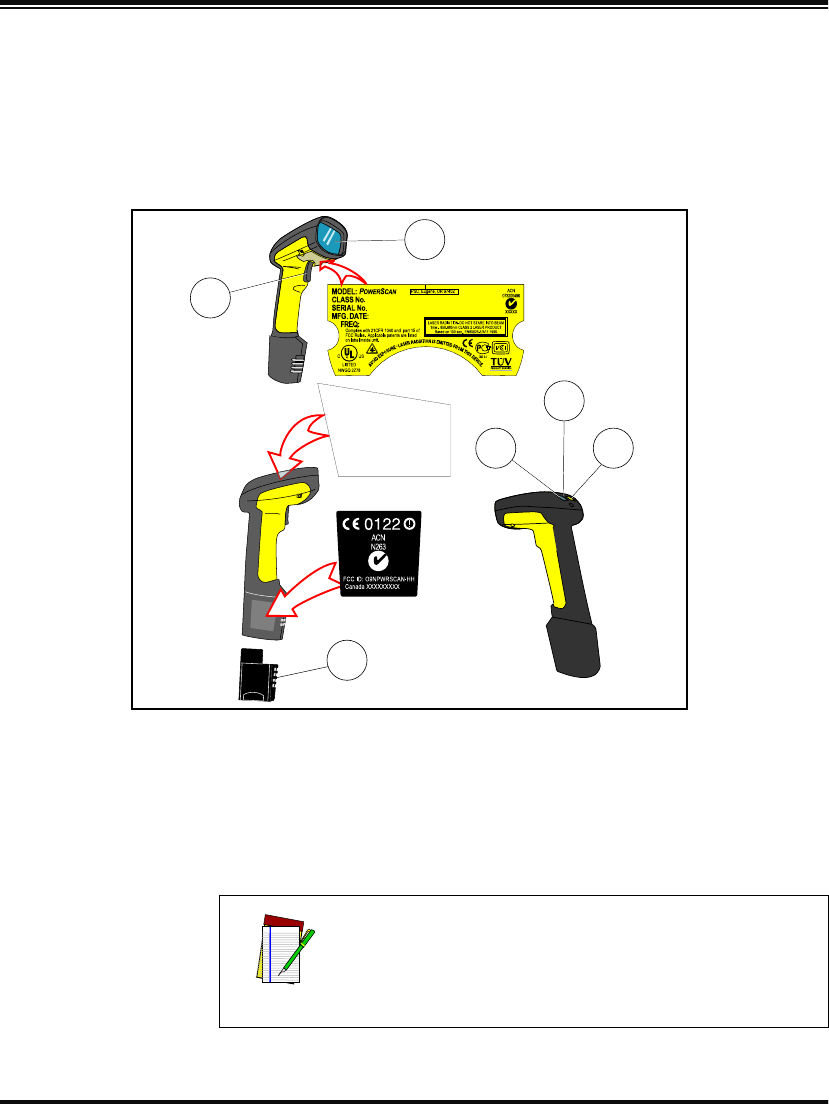
2PowerScan™ RF Scanner
Product
Description
The PowerScan™ RF scanner is designed for durability, with high
impact-resistant material and protective rubber cushioning at every
point of impact, and it also provides the unleashed freedom of Radio
Frequency (RF) communication with your host system. Scanner and
Base Station nomenclature and labeling are shown in Figure 1 and
Figure 2 below.
Figure 1. Scanner Labels and Nomenclature
1. Trigger 4. Tether Hook
2. Scan Window 5. Yellow LED
3. Green LED 6. Battery
NOTE
Figure 1 and Figure 2 show label placement ONLY.
For actual regulatory, patent and other applicable
information, view the labels on the product itself, or
call your nearest sales or service representative.
CAUTION—LASER RADIATION WHEN OPEN. AVOID EXPOSURE TO BEAM.
COVERED
BY ONE OR MORE OF THE
FOLLOWING PATENTS:
4,387,297 • 4,409,470 • 4,460,120
4,593,186 • 4,652,750 • 4,673,805
4,736,095 • 4,816,660 • 4,845,350
4,861,972 • 4,866,257 • 4,879,456
5,179,270 • 5,180,904 • 5,237,161
5,247,161 • 5,247,162 • 5,258,604
5,260,554 • 5,298,728 • 5,311,000
5,330,370 • 5,468,949 • 5,475,206
5,481,098
Other patents pending
RF
1
2
3
4
6
5
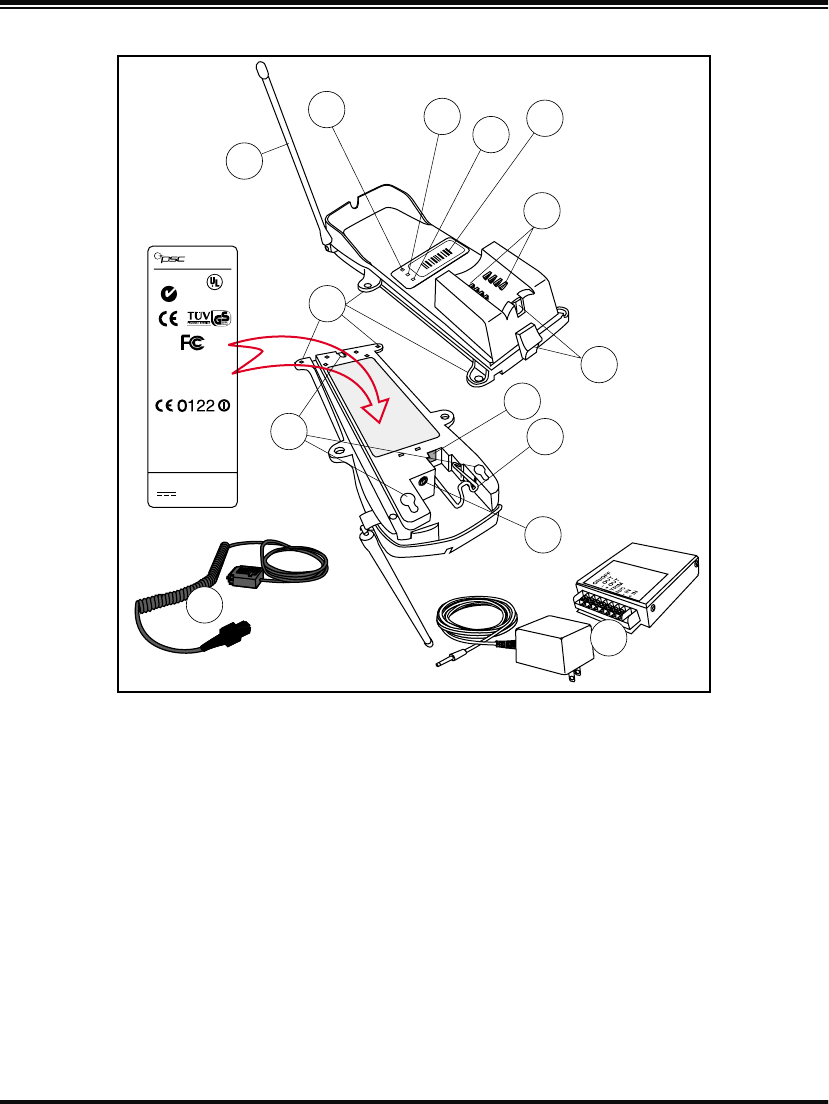
Systems Manual 3
Figure 2. Base Station Labels and Nomenclature
1. Antenna 8. Interface (I/F) Connector
2. Transmit/Receive
(TX/RX)/ Diagnostics LED
9. Cable Retainer
3. Charge LED 10 Power Connector
4. Power LED 11. Power Supply - (a) AC Adapter or
(b) Forklift DC Converter
5. Base ID Bar Code 12. Interface (I/F) Cable
6. Charging Pins 13. Mounting Key Slots (3)
7. 3-Position Lock 14. Mounting Flanges (4)
BASE ID
TX/RX
CHARGE
POWER
1
23
45
6
7
13
8
9
10
14
12
11
a
b
PSC
INC.
959 Terry Street
Eugene, OR 97402 U.S.A.
MODEL: PowerScan RF Base Station
CLASS No.
SERIAL No.
FREQ:
ACN
N263
Use ONLY PSC
AC/DC Power Supply
Input: +6.5V to +14V
Power: 13.9 Watts (max)
CUS
LISTED
NWGQ 2Z78
FCC ID: O9NPWRSCAN-BS
CanadaXXXXXXXXX
This device complies with Part 15 of the FCC Rules.
Operation is subject to the following two conditions:
1. This device may not cause harmful interference.
2. This device must accept any interference, including
interference that may cause undesired operation.
Applicable patents are listed on label inside handheld unit.
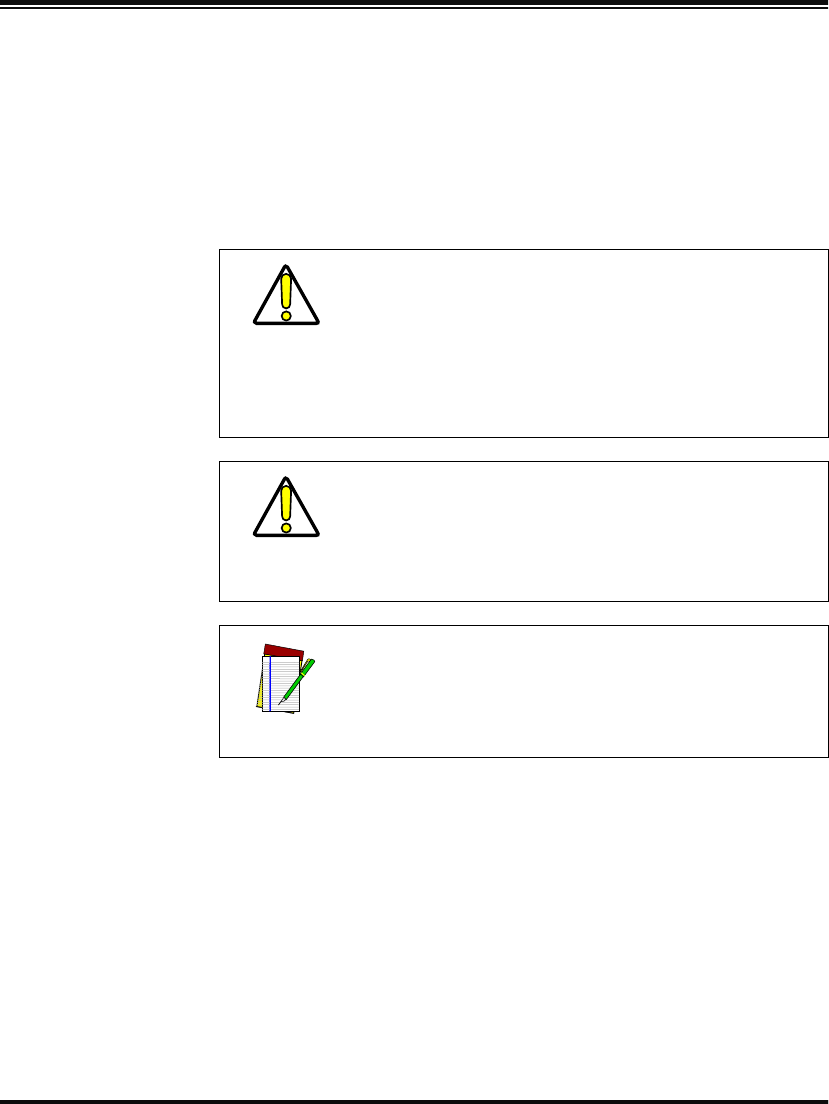
4PowerScan™ RF Scanner
Laser Cautions
The PowerScan RF bar code scanner is certified in the U.S. to conform
to the requirements of DHHS/CDRH 21CFR Subchapter J for Class II laser
products. Class II products are not considered to be hazardous. The
scanner contains a Visible Laser Diode (VLD) at a wavelength of 650-
670 nanometers and is designed so that there can be no human access
to harmful levels of laser light during normal operation, user mainte-
nance, or during prescribed service operations.
CAUTION
In the unlikely event that a bright laser spot is expe-
rienced rather than a scan line, do not stare into the
beam or attempt to repair the unit. Discontinue
operation and return the unit to your dealer. Note
that when using Marker Beam Mode, a single aim-
ing dot is projected momentarily preceding a scan
line and is not considered a malfunction.
CAUTION
Do not open or otherwise service any components
in the optics cavity. Opening or servicing any part
of the optics cavity by unauthorized personnel may
violate laser safety regulations. The optics system
is a factory only repair item.
NOTE
The PowerScan™ RF scanner is required to be used
in conjunction with the PSC Base Station, Model:
PowerScan RF Base Station.

Systems Manual 5
Radio Frequency Interference
This device complies with Part 15 of the FCC Rules. Operation is sub-
ject to the following two conditions:
1. This device may not cause harmful interference, and
2. This device must accept any interference received, including
interference that may cause undesired operation.
This Class B digital apparatus meets all requirements of the Canadian
Interference-Causing Equipment Regulations.
Cet appareil numerique de la classe B respecte toutes les exigences du
Reglement sur le material broilleur du Canada.
This equipment has been tested and found to comply with the limits
for a Class B digital device, pursuant to Part 15 of the FCC Rules. These
limits are designed to provide reasonable protection against harmful
interference in a residential installation. This equipment generates,
uses and can radiate radio frequency energy and, if not installed and
used in accordance with these instructions, may cause harmful interfer-
ence to radio communications. However, there is no guarantee that
interference will not occur in a particular installation. If this equipment
does cause harmful interference to radio or television reception, which
can be dertermined by turning the equipment off and on, the user is
encouraged to try to correct the interference by one or more of the fol-
lowing measures:
•Reorient or relocate the receiving antenna.
•Increase the separation between the equipment and receiver.
•Connect the equipment into an outlet on a circuit different
from that to which the receiver is connected.
•Consult the dealer or an experienced radio/TV technician for
help.
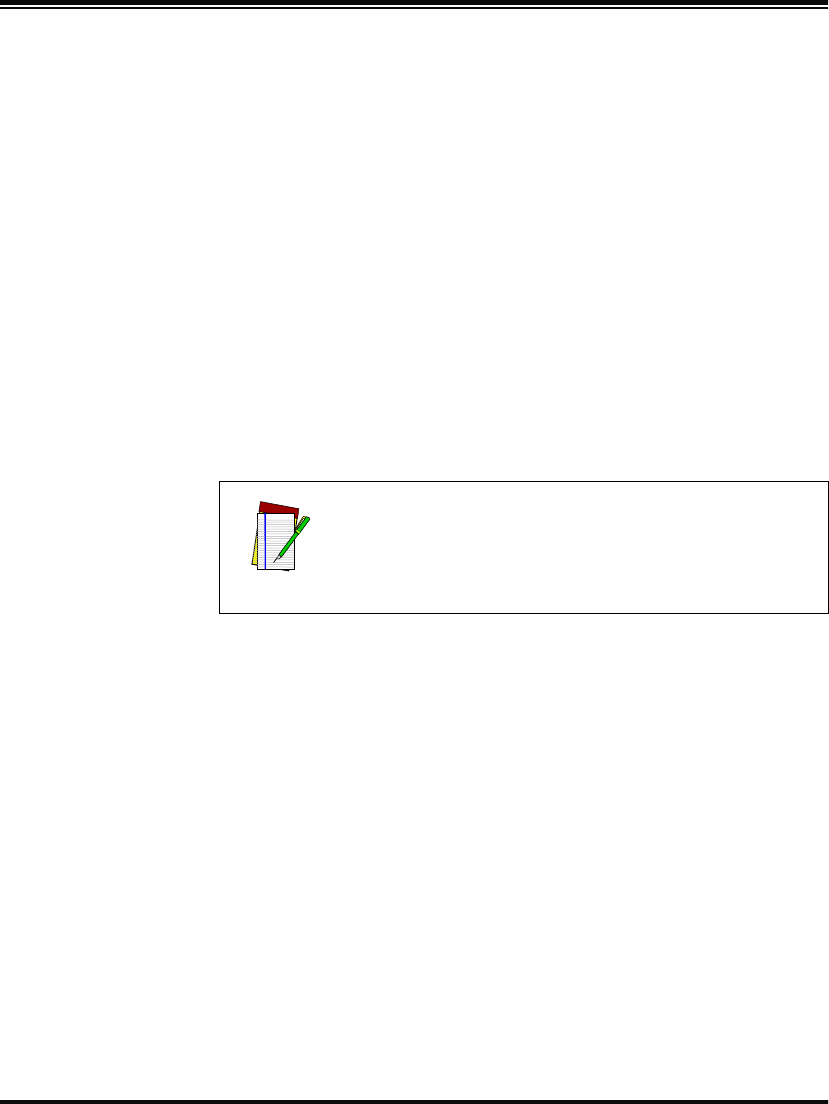
6PowerScan™ RF Scanner
Quick Start Instructions
Unpacking and
Inspecting the
Base Station
After unpacking your new Base Station, check the contents of the ship-
ping carton to ensure all the items you ordered are included:
•PowerScan™ Scanner Base Station
•Interface Cable
•Power Supply (AC Adapter or Forklift DC Converter)
•Systems Manual (this manual)
•Programming Guide
•Optional Accessories that you ordered. (The Base Station can
be purchased with or without accessory kits.)
If your package contains wrong or missing components, contact your
place of purchase. If there are damaged components, immediately file a
claim with the carrier. You may want to save your packing material in
case you need to ship the scanner at some later time.
Installation
Procedures
The basic steps below must be performed to set up the RF scanner.
Each of these steps is detailed in this section.
•Installing the Battery
•Verifying Scanner Operation
•Connecting the Base Station to the Host Terminal
•Linking the Scanner to a Base Station
•Verifying Scanner-to-Base Station Communications
•Using the PowerScan RF System
NOTE
Other manuals for this product are available on our
internet website. See the back cover for our internet
address.
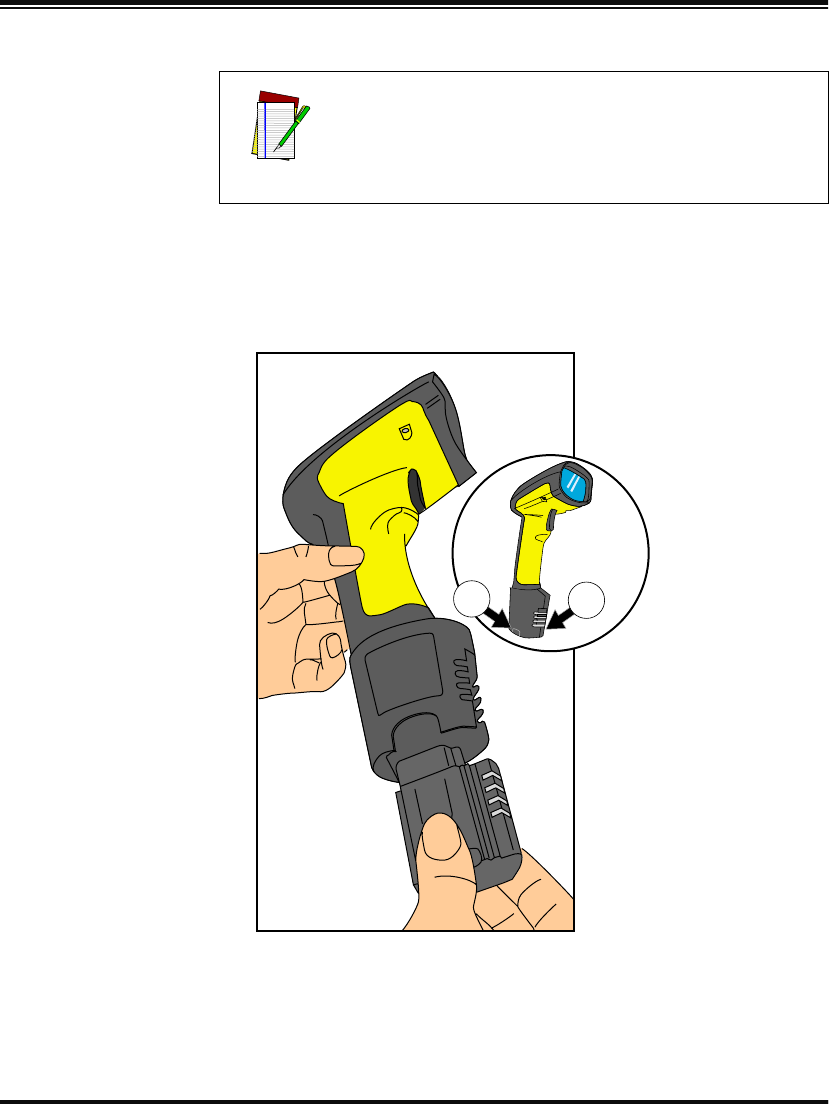
Systems Manual 7
Installing the Battery
Orient the battery as shown in Figure 3, then push it into the scanner
until it snaps in place. To remove the battery, push in on the release tabs
on both sides of the battery’s base and pull it straight out of the scan-
ner.
Figure 3. Installing the Battery
NOTE
To assure maximum usage, batteries should always
be fully charged before their initial use. (See Battery
Charging and Maintenance on page 12.)
1. Battery Release Tabs
1
1
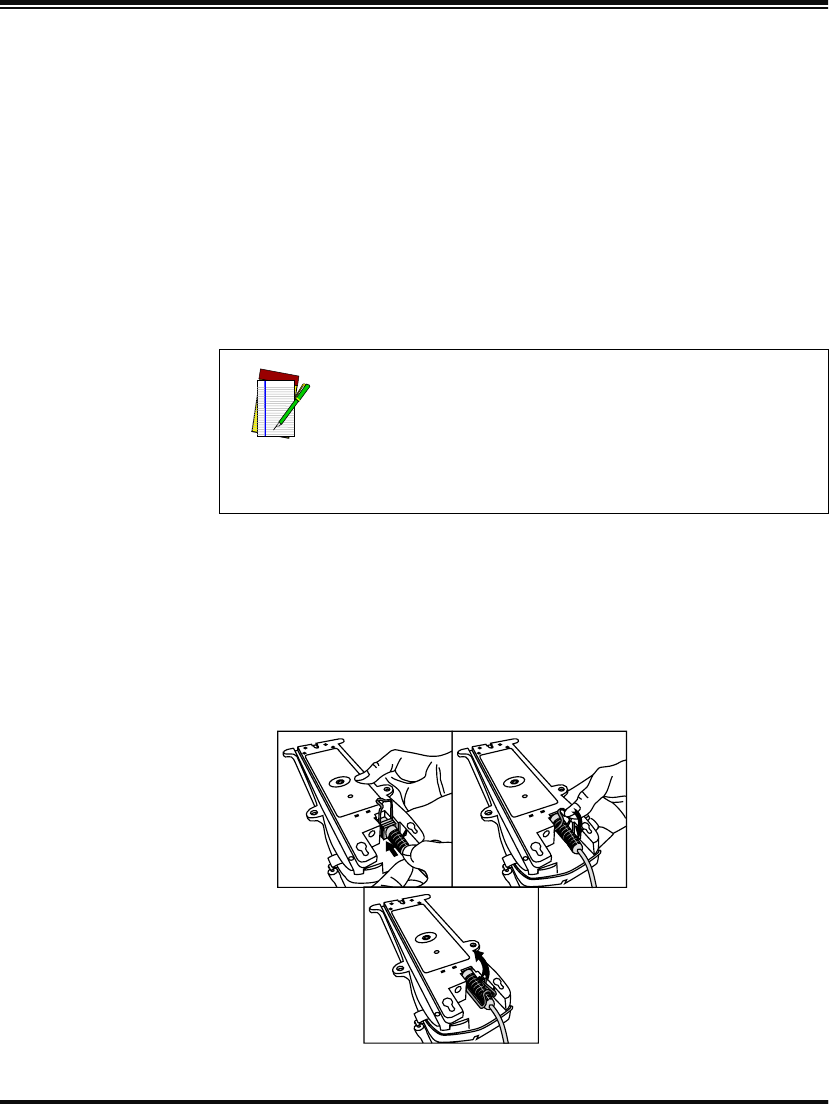
8PowerScan™ RF Scanner
Verifying Scanner Operation
Once a charged battery has been installed in the scanner, scan the sam-
ple bar codes in Appendix A that correspond to the symbologies your
scanner is programmed to read. If unsure how to do this, see the sec-
tion on How to Scan in this manual. The system may signal with one or
a combination of indicators depending upon how the scanner and Base
Station are programmed to respond (see LED and Beeper Indications for
details). If your scanner fails to read a sample bar code of a symbology
it’s programmed to read, turn to the section titled, Maintenance and
Troubleshooting.
Connecting the Base Station to the Host Terminal
1. Connect the I/F cable to the Base Station (see Figure 4A). The
I/F cable is inserted into the connector and the cable retainer
clip is rotated over the cable overmold until the retainer snaps
in place (see Figure 4B). To disconnect the cable, push in on the
retainer (away from the catch on the plastic wall) to release it
and enable it to swing upward, allowing the cable to be pulled
free (see Figure 4C).
Figure 4. Connecting/Disconnecting the Interface (I/F) Cable
NOTE
It is important that the interface (I/F) cable be con-
nected to the Base Station prior to applying power
to the system. This is because the interface type
(RS-232, IBM, Keyboard Wedge, etc.) is selected by
the Base Station subject to the I/F cable it is con-
nected to at the time of power-up.
ab
c
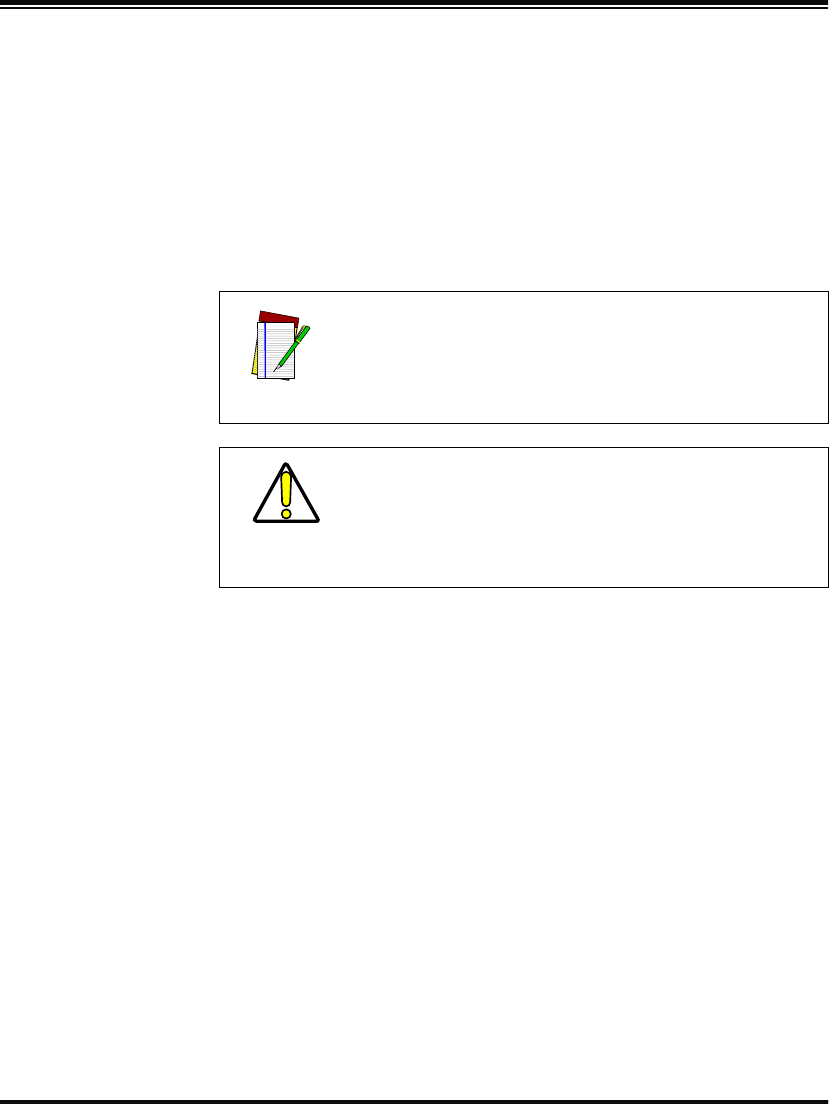
Systems Manual 9
2. Consult your Host Terminal manual to determine the required
communication parameters for the Host Terminal (e.g., baud
rate, parity, etc.) and, if necessary, modify the programmed
parameters to be compatible with those requirements. Scanner
and Base Station programming is performed using one of the
following:
- Configurator Express™ Programming Software
- PowerScan™ Bar Code Scanner Programming Guide
3. Connect the I/F cable to the proper port on the Host Terminal
(check your Host Terminal manual to determine hardware
requirements).
4. Connect the AC Adapter’s power cord at the Base Station and
plug the AC/DC adapter in at the wall outlet (see Figure 5).
The Base Station’s POWER LED should be illuminated when
the unit is properly connected to power.
NOTE
See References for more information about how to
obtain software and manuals for this product.
CAUTION
The Host Terminal manual should also be consulted
as to whether power must be turned off before con-
necting peripheral devices. Ensure that the correct
procedure is followed to avoid damage to equip-
ment or interruption of system functions.
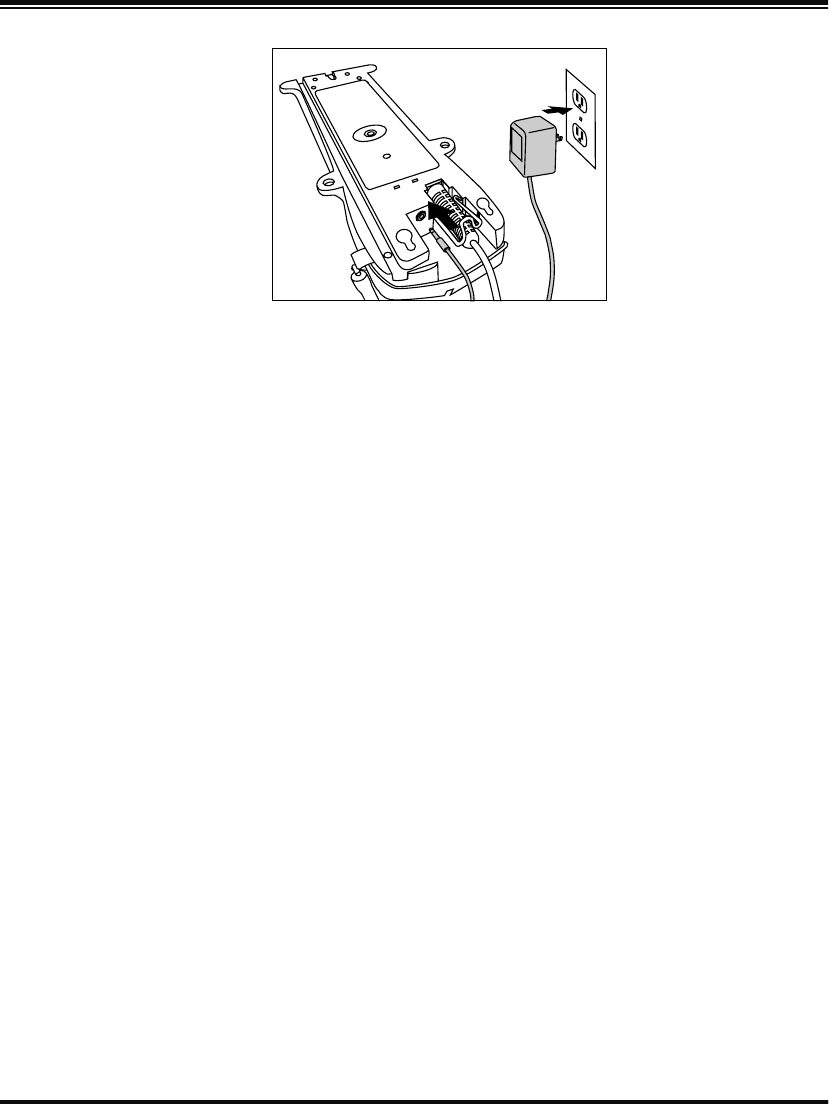
10 PowerScan™ RF Scanner
Figure 5. Connecting Power to the Base Station
5. Apply power to the Host Terminal.
6. Verify communication with the Host Terminal by aiming the
linked scanner at a sample bar code from Appendix A, and
pulling the trigger (see How to Scan for tips about scanning bar
codes). Confirm that the scanner/Base Station sent the data to
the host terminal. If not, see the section, Maintenance and Trou-
bleshooting. Once all communications are verified, the system is
ready for use.
Linking the Scanner to a Base Station
To link a scanner to a Base Station, simply scan the Base Station ID bar
code located on the top of the desired Base Station (see Figure 2). As the
scanner searches for the Base Station, a short beep is heard as it seeks
for the correct channel. When the Base Station responds to the request,
the scanner’s beeper will either sound a "Link Granted," or "Link
Denied" signal (see the section, LED and Beeper Indications for more
information).
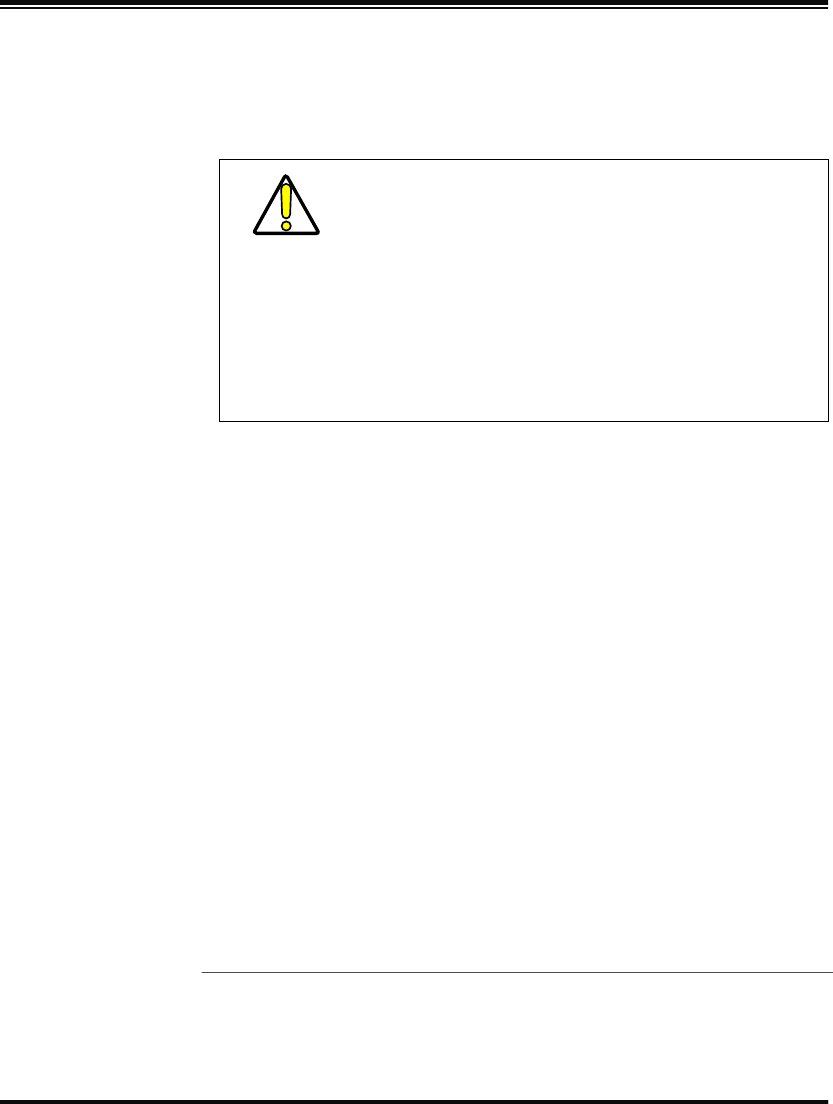
Systems Manual 11
The existing Base Station system configuration can be automatically
downloaded to the scanner. This automatic download feature is config-
urable and can be disabled. See the section, Common Configuration for
more information about this feature. If downloading occurs, a slight
delay with link verification announcement will occur.
Verifying
Scanner-to-Base
Station
Communications
Point the linked scanner at a sample bar code from Appendix A, and
pull the trigger (see How to Scan for tips on scanning bar codes). Watch
the TX/RX (transmit/receive) indicator LED on the Base Station and/
or scanner green LED while scanning the bar code. The LEDs should
flash momentarily as the two devices communicate. If no communica-
tion is indicated, see the section titled, If the Scanner Fails to Link with the
Base Station.
When the scanner is programmed to do so, communication can also be
indicated by a second "acknowledgement" tone1 that is sounded after a
"good read" tone. If a transmission error beep (warble) is heard follow-
ing a "good read" tone instead of the single acknowledgement tone,
communication between the devices may have failed2. Refer to the sec-
tions Using the PowerScan RF System, and Maintenance and Troubleshoot-
ing for possible remedies, should this occur.
Using the PowerScan RF System
This section covers the following topics:
•Battery Charging and Maintenance
•How to Scan
CAUTION
Since a new/replacement scanner may have been
shipped with a custom configuration or may have
been modified with other special programming, it
may not be desirable to download a potentially
older configuration from an existing Base Station.
In this case, reference the RF Programmable Fea-
tures section of this manual, or the Configurator
Express™ On Screen Programming Software and
consider uploading the scanner’s newer configura-
tion to the Base Station prior to linking.
1. See LED and Beeper Indications for more details about beeper signals.
2. Other reasons for a "warble" are that the Base Station may be configured differently than the scan-
ner, or that the system’s interface doesn’t support the symbology (bar code type) you’re trying to
scan.
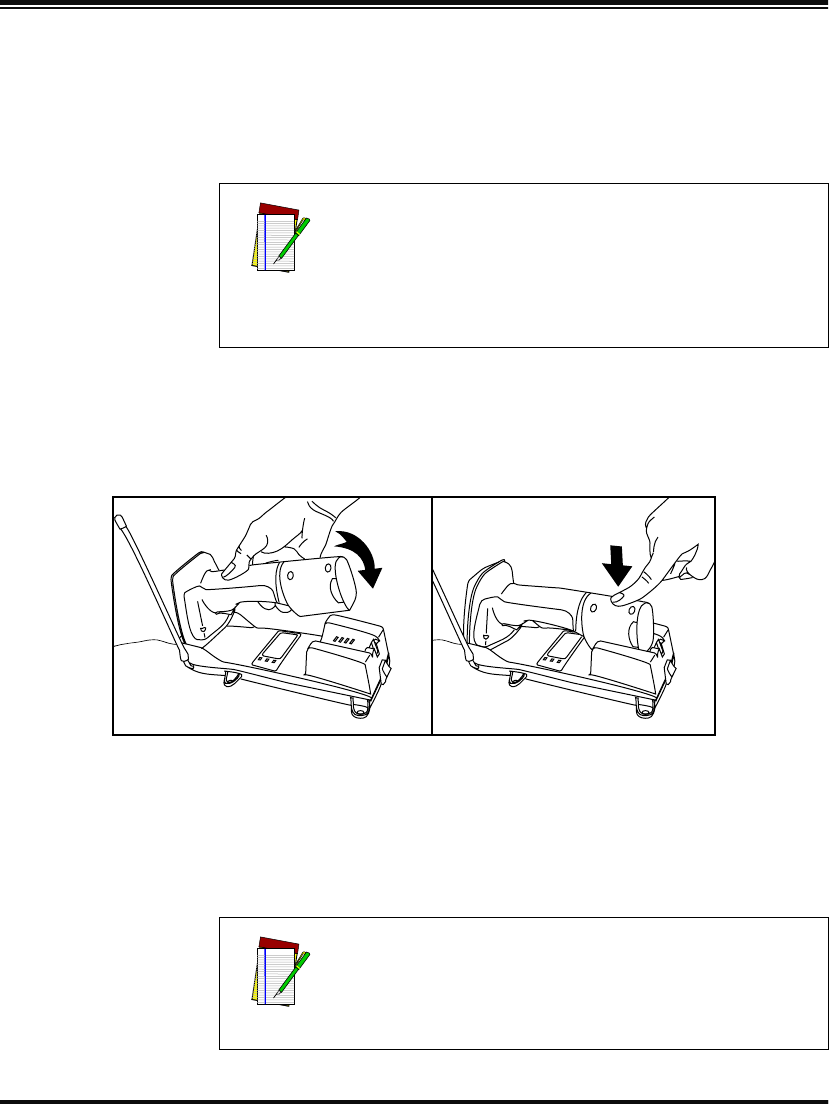
12 PowerScan™ RF Scanner
•LED and Beeper Indications
•Maximizing Signal Range
•Three-Position Lock
Battery Charging and Maintenance
Seat the scanner in the Base Station as shown in Figure 6, ensuring that
the battery fully engages the station’s metal contacts. The CHARGE
LED on the Base Station should flash, indicating the battery is charg-
ing.
Figure 6. Charging the Battery
Rapid flashing indicates that charging is taking place. Rapid charging
occurs when the battery temperature is between 10°C (50°F) and 46°C
(115°F), and/or voltage of the battery is between 2.0 and 3.2V. Charge
time is less than 4.2 hours. Rapid charge ends with the battery at
approximately 90 to 95% capacity. The CHARGE LED remains on
steady when trickle charging or after the charge cycle is complete.
NOTE
When the scanner is in use, a low battery condition
is indicated by a repeated two-flash signal from the
scanner’s green LED every time the trigger is pulled
before the laser is enabled. This indicator may have
been disabled via custom programming. See LED
and Beeper Indications for more information.
NOTE
A scanner may be charged simultaneously while
other scanners are in use with the Base Station.
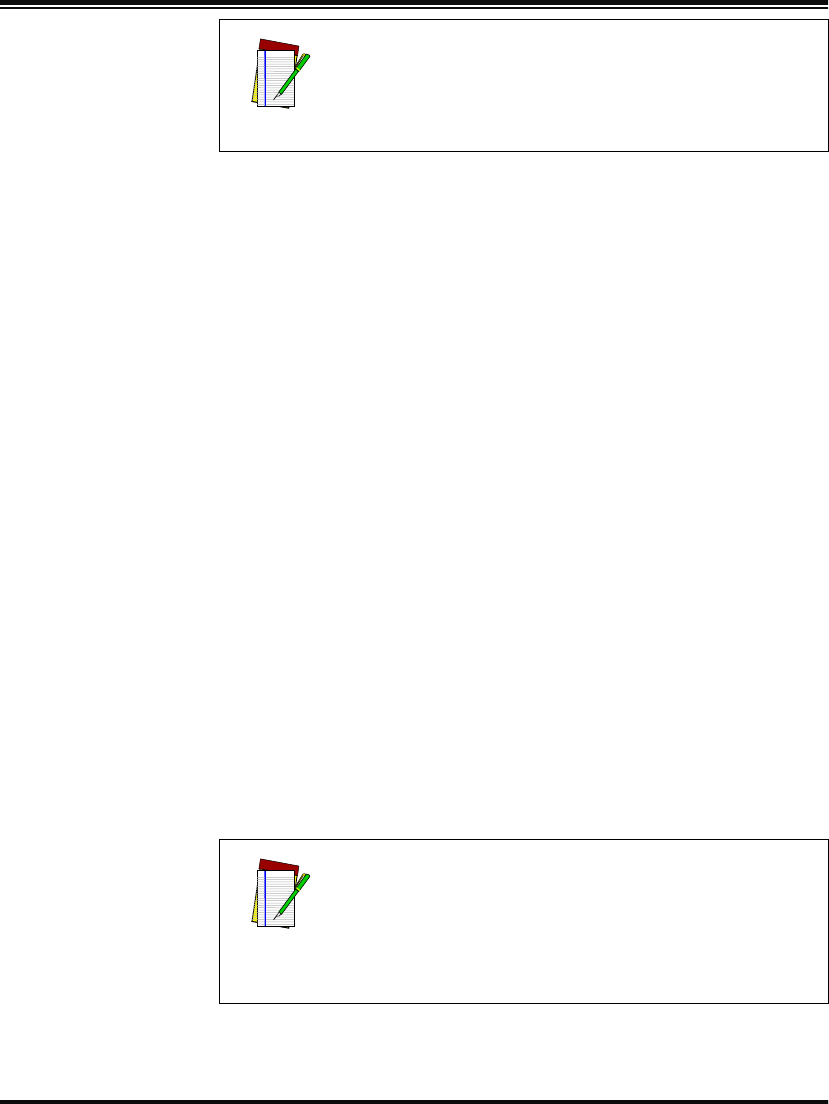
Systems Manual 13
Tips for
Extending
Battery Life
Nickel Metal Hydride (NiMH) batteries will better hold a charge if
allowed to discharge at least once a week. The chemical reactions that
correspond to charge and discharge in a rechargeable battery should
occur to obtain the maximum number of charge/discharge cycles in
the battery. If a battery is removed from the scanner and stored, it
should be fully charged when stored. Batteries will lose the ability to
hold a charge when stored for long periods of time (weeks, months, or
longer).
Batteries will typically have about 30% charge capacity when shipped.
To assure maximum usage, the battery should be fully charged before
use.
Store your battery in a cool dry place. Do not leave your battery
exposed to direct sunlight or temperatures below 0°C (30°F) and above
38°C (100°F).
Disposing of
Batteries
There presently are no US, North America or World disposal require-
ments for NiMH batteries, so when they won't hold a charge anymore,
the batteries can be disposed of, preferably through a recycling center.
Four Station
Charger
If you have a Four Station Charger, batteries are inserted for charging
as shown in Figure 7. A 90% rapid charge can be achieved in only two
hours when using this optional accessory; half the time than when a
Base Station is used for charging. The LEDs at each battery station
operate the same as the CHARGE LED on the Base Station, with rapid
flashing indicating that rapid charging is taking place and on steady
during trickle charging or when the rapid charge cycle is finished.
NOTE
Batteries will not charge if their temperature is
below 0°C (30°F). If a battery that is too cold is
inserted into the Base Station, the Charge LED will
not illuminate.
NOTE
If you insert a battery into the Four Station Charger
and no LEDs illuminate, the battery may be too
cold. Batteries must be at 0°C or higher to charge.
Do not attempt to charge cold batteries, since plac-
ing them in the charger will curtail the charging of
other batteries already present in the unit.
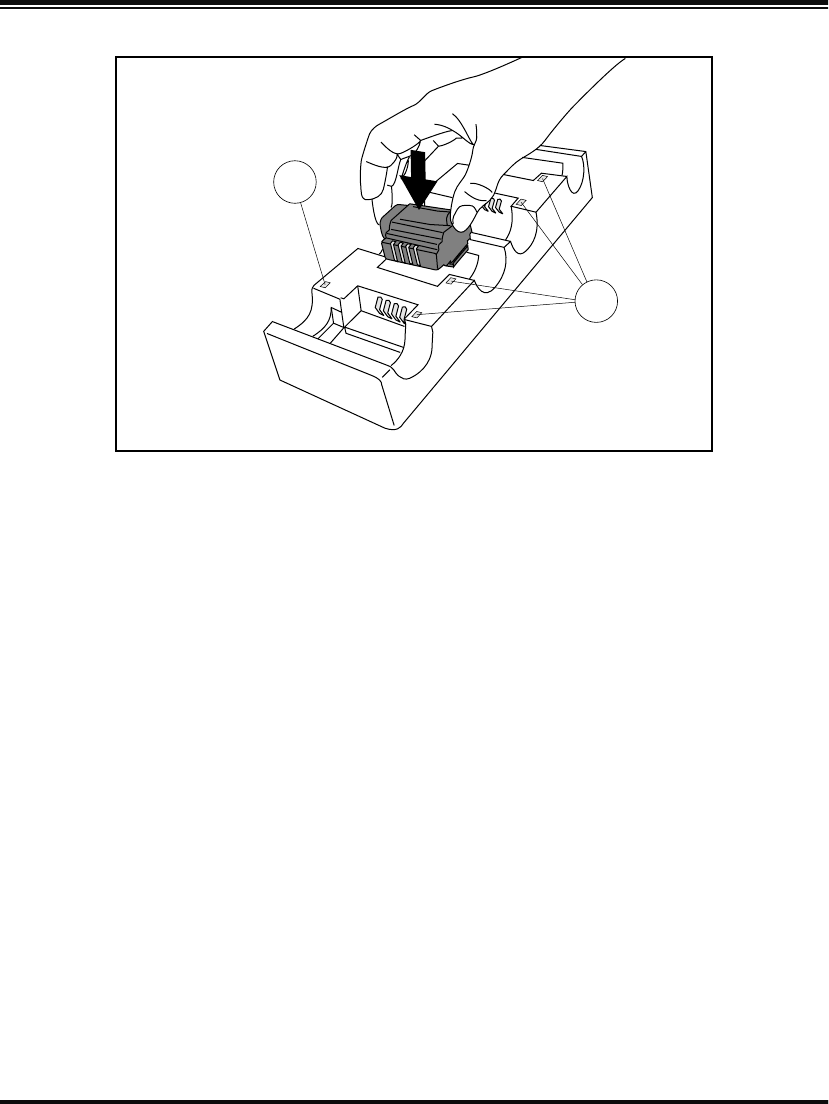
14 PowerScan™ RF Scanner
Figure 7. Using the Four Station Charger Accessory
1. Device Power LED 2. Station Charge LEDs
1
2
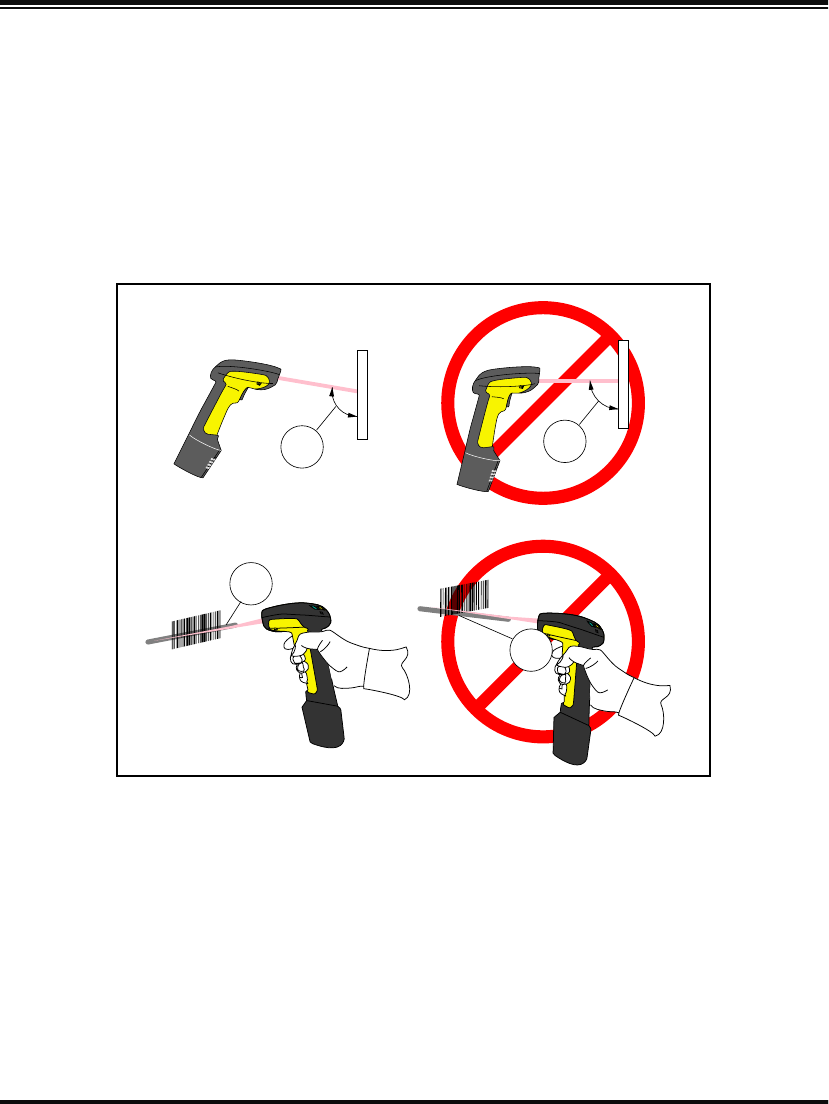
Systems Manual 15
How to Scan
Figure 8 illustrates some tips to help get the best scanning results:
1. The scanner must be pointed at a slight angle to the bar code.
Do not hold the scanner perpendicular to the bar code.
2. The laser beam must cross the entire bar code. The scanner
cannot correctly read if the entire bar code is not scanned.
Figure 8. Scanning Tips
2
1
1
2
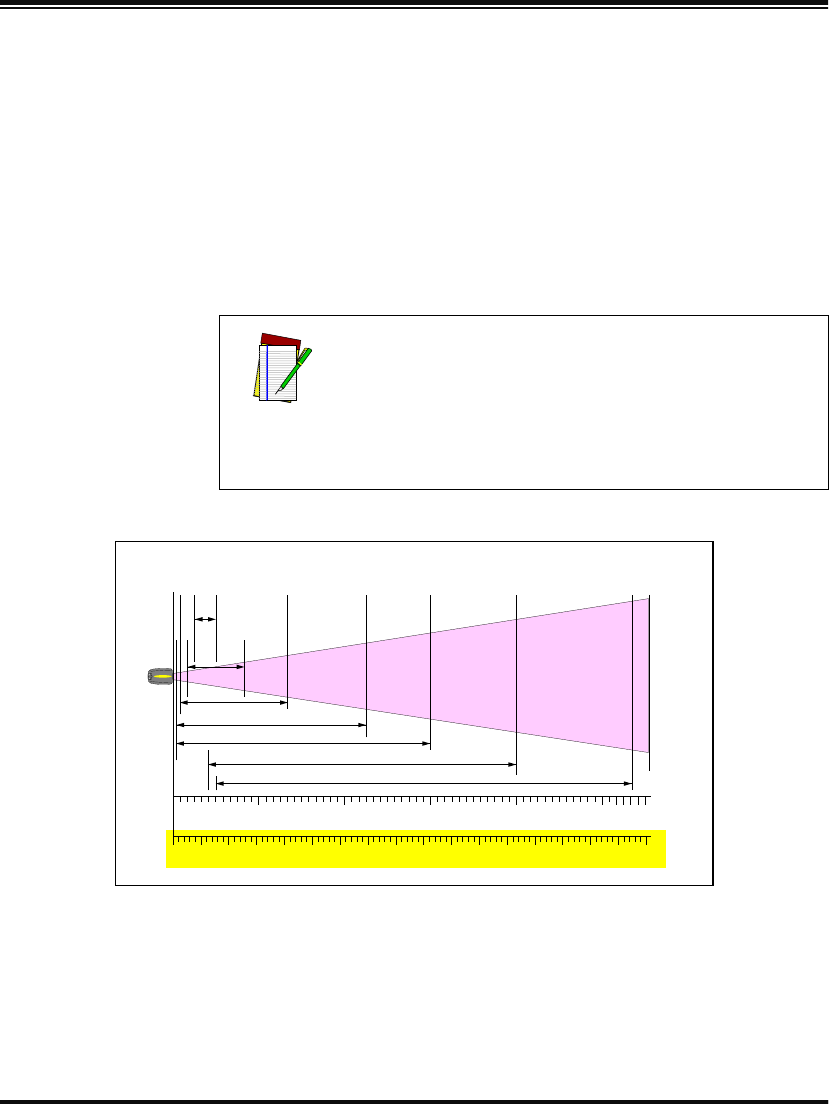
16 PowerScan™ RF Scanner
Depth of Field There are currently four different range models for the RF scanner.
Depending upon the model type of your scanner, you’ll need to hold
the unit at a given distance from the bar code to achieve optimum scan-
ning results. The following diagrams provide depth of field informa-
tion for each of the models when scanning grade A, Code 39 bar codes:
Standard Range (SR), High Density (HD), Long Range (LR) and Extra
Long Range (XLR).
Definition of
a "mil"
A "mil" is equal to 0.001 inches. In the context of the illustrations in this
section, a mil represents the minimum bar code element width. Thus a
5 mil bar code would have a minimum element width of 5 mils (or
0.005 inches).
Figure 9. Depth of Field (SR)
NOTE
Measurements are based on SR models set with the
standard 28° scan width (as opposed to the Half
Angle setting of 14°). Reference the Programming
Manual for more information about the Half Angle
feature.
Specifications are subject to change without notice.
Depth of Field
Paper Labels (SR decoded model, Code 39)
0
20 mil
15 mil
10 mil
5 mil
CENTIMETERS
FEET
FRONT OF SCANNER
10
12345
20 30 40 50 60 70 80 90 100 110 120 130 140 150 160 170
40 mil
7.5 mil
55 mil
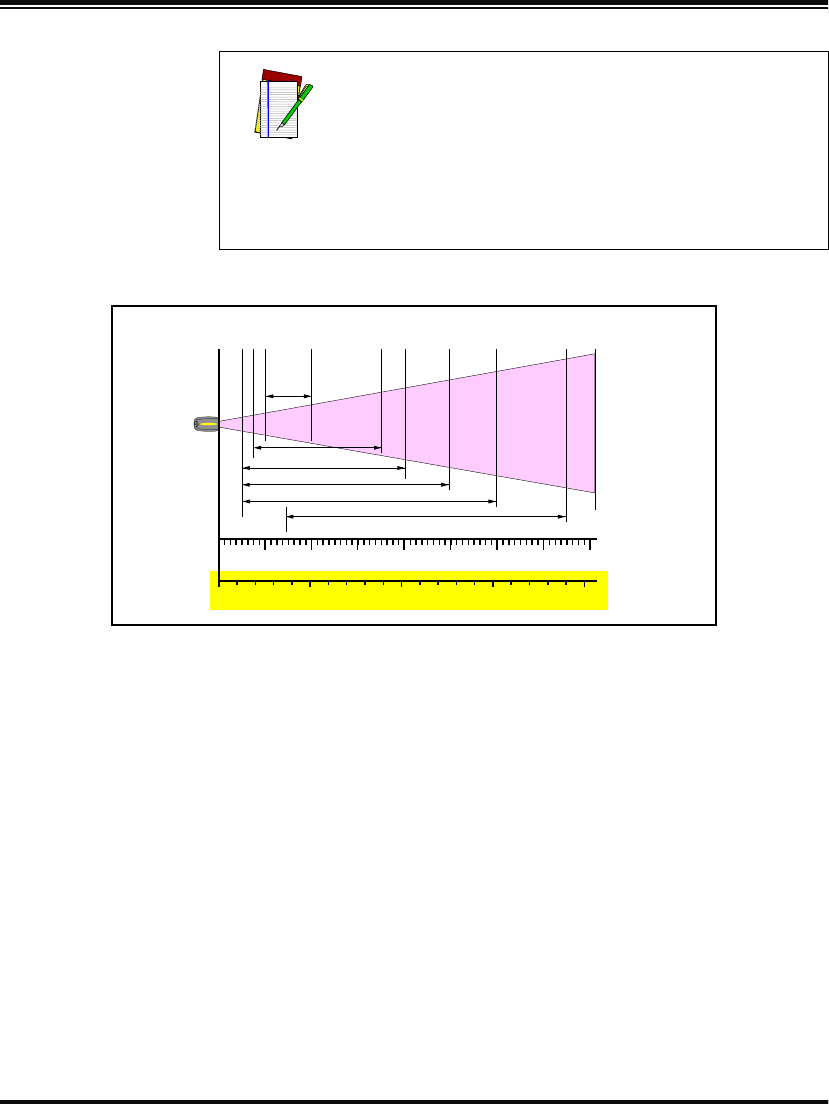
Systems Manual 17
Figure 10. Depth of Field (HD)
NOTE
See the section titled, Definition of a "mil" for more
information about reading this chart. Measurements
are based on HD models set with the standard 28°
scan width (as opposed to the Half Angle setting of
14°). Reference the Programming Manual for more
information about the Half Angle feature.
Specifications are subject to change without notice.
Depth of Field
Paper Labels (HD decoded model, Code 39)
7.5 mil
5 mil
4 mil
3 mil
INCHES
FRONT OF SCANNER
0
CENTIMETERS
5
1 234 5678
10 15 20
10 mil
20 mil
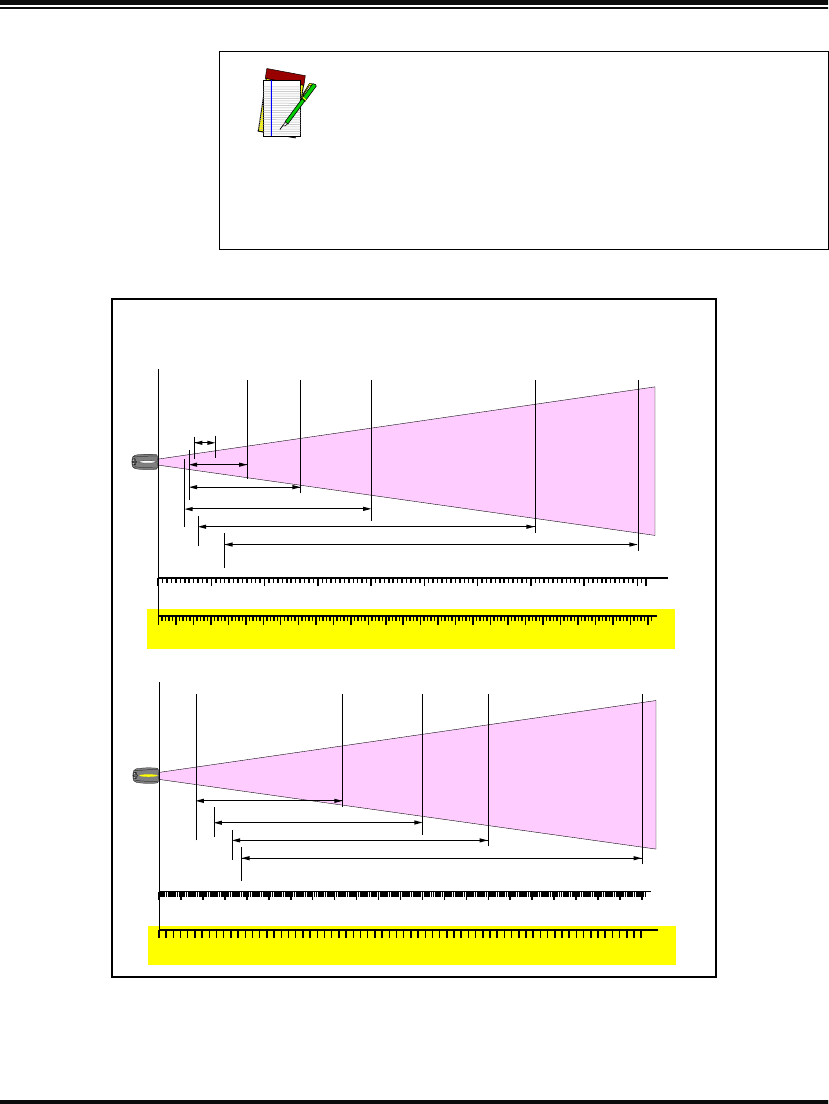
18 PowerScan™ RF Scanner
Figure 11. Depth of Field (LR)
NOTE
See the section titled, Definition of a "mil" for more
information about reading this chart. Measurements
are based on LR models set with the a 14° scan
width (as opposed to the alternate Full Angle set-
ting of 28°). Reference the Programming Manual for
more information about the Half Angle feature.
Specifications are subject to change without notice.
Depth of Field
Paper Labels (LR decoded model, Code 39)
0
40 mil
20 mil
15 mil
7.5 mil
CENTIMETERS
FEET
FRONT OF SCANNER
10
12345
20 30 40 50 60 70 80 90 100 110 120 130 140 150 160
6789
170 180 190 200 210 220 230 240 250 260 270 280
10 mil
55 mil
Reflective Labels (LR decoded model, Code 39)
70 mil
55 mil
40 mil
CENTIMETERS
FEET
FRONT OF SCANNER
6706506306105905705505305104904704504304103903703503303102902702502302101901701501301109070503010
1
0
2345678910 11 12 13 14 15 16 17 18 19 20 21 22
100 mil
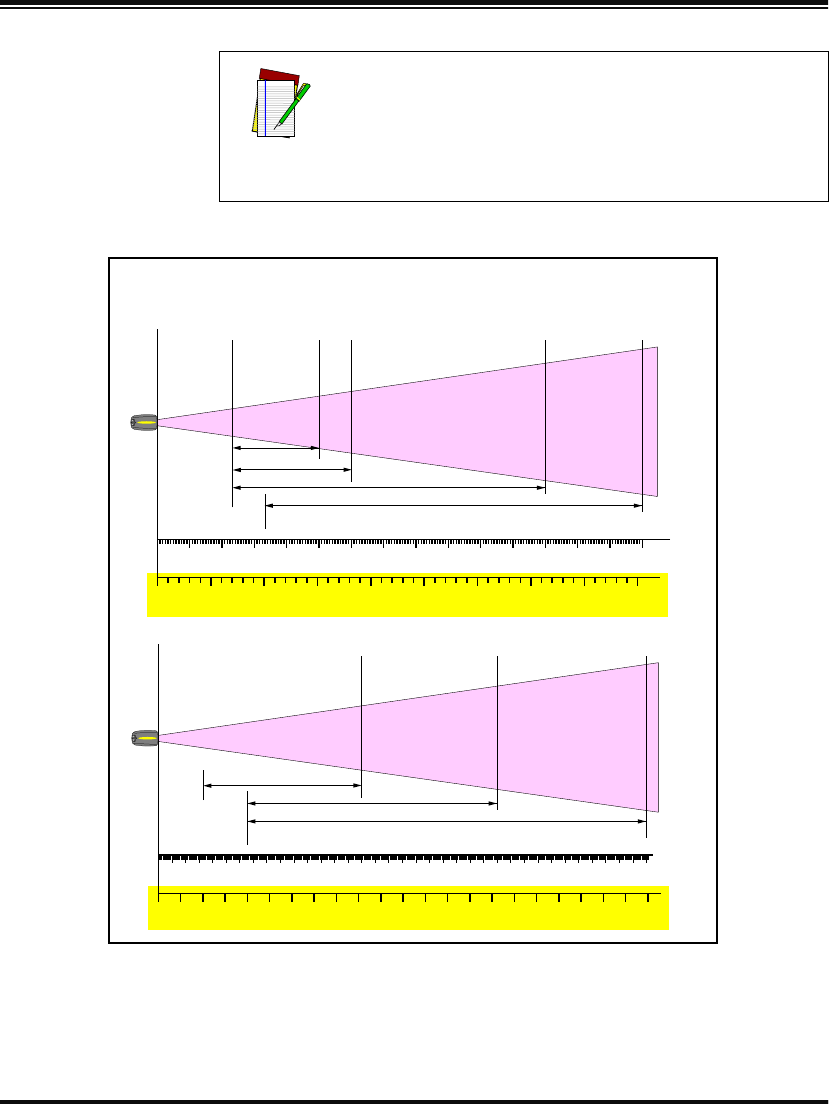
Systems Manual 19
Figure 12. Depth of Field (XLR)
NOTE
See the section titled, Definition of a "mil" for more
information about reading this chart. Measurements
are based on XLR models set with a 10° scan angle
width.
Specifications are subject to change without notice.
Depth of Field
Paper Labels (XLR decoded model, Code 39)
0
40 mil
20 mil
15 mil
CENTIMETERS
FEET
FRONT OF SCANNER
12345678910 11 12 13 14 15
45040035030025020015010050
55 mil
Reflective Labels (XLR decoded model, Code 39)
70 mil
40 mil
CENTIMETERS
FEET
FRONT OF SCANNER
11001050100095090085080075070065060055050045040035030025020015010050
1
0
2345678910 11 12 13 14 15 16 17 18 19 20 21 22 23 24 25 26 27 28 29 30 31 32 33 34 35 36
100 mil
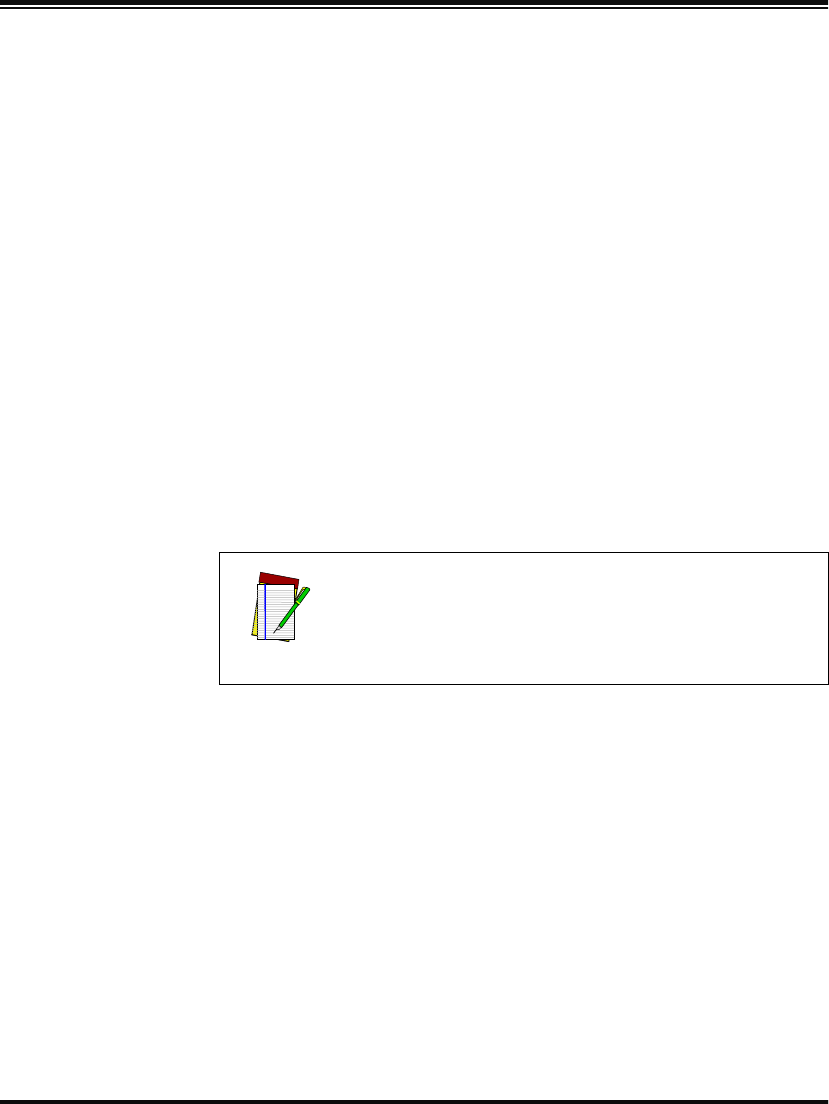
20 PowerScan™ RF Scanner
Active
Symbologies
The active (enabled) bar code symbologies in the standard factory
defaults are:
•Code 39 (C39)
•Code 128 (C128)
•Interleaved 2 of 5 (I 2 of 5)
Your scanner should be pre-programmed with these standard factory
default settings, unless...
...it was shipped to you programmed with unique, customer con-
figuration settings.
...you or another user have made changes to scanner program-
ming.
Enhanced
Scanning for
Hard-to-Read
Bar Codes
Decoded scanners can be programmed to decode extremely poor qual-
ity bar codes by activating advanced Quadralogic™ Decoding. To
select this feature, see the Programming Guide.
Scanner programming can also be performed using your PC and the
Configurator Express™ On-Screen Programming Kit.
NOTE
Information about manuals, kits and programming
software for this product are available at our web-
site. See the back cover for our web address.
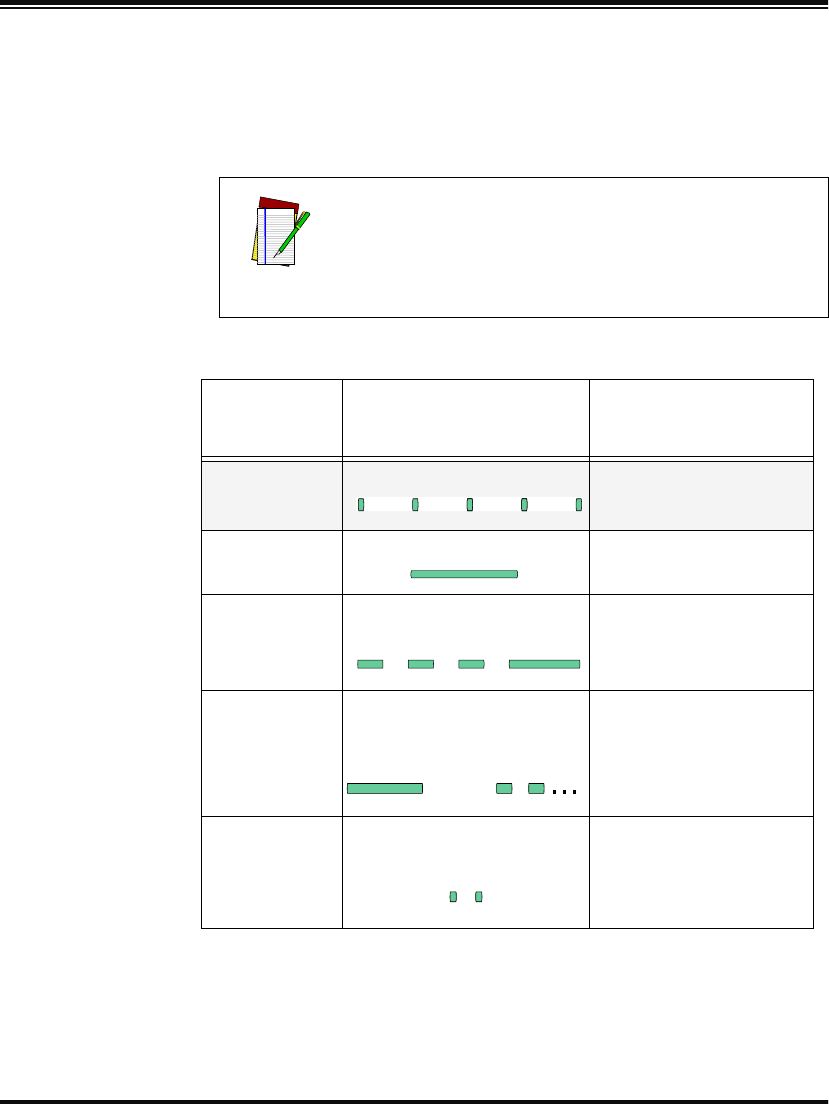
Systems Manual 21
LED and Beeper Indications
The Base Station LED indicators and the scanner’s LEDs and beeper
are used to announce system status and perform other useful signals.
The tables below list the default function of each of the various indica-
tors.
Table 1. Scanner GREEN LED Functions
NOTE
Some LED and beeper indications can be disabled
or modified via scanner programming. The tables
indicate the default behavior of the indicators, with
shaded rows representing features that are pro-
grammable.
LED
INDICATION DURATION COMMENT
Disable
Indication
100ms on, 900 ms off Indicates the scanner has
been disabled.
Good Read
Indication
500 ms on Indicates a bar code has
been read and decoded.
Program Mode
Indication
500 ms on, 500 ms off
Continuous flashing Indicates the scanner is in
Programming Mode.
Field Replace-
able Unit (FRU)
Indications
Varies. Consists of a long flash
followed by multiple short
flashes.
Enables service techni-
cians to identify Field
Replaceable Unit (FRU)
errors.
Low Battery
Indication
Two flashes at 100 ms on, 350
ms off.
Occurs at trigger pull before
the laser is enabled. Indi-
cates the battery is in need
of recharging.
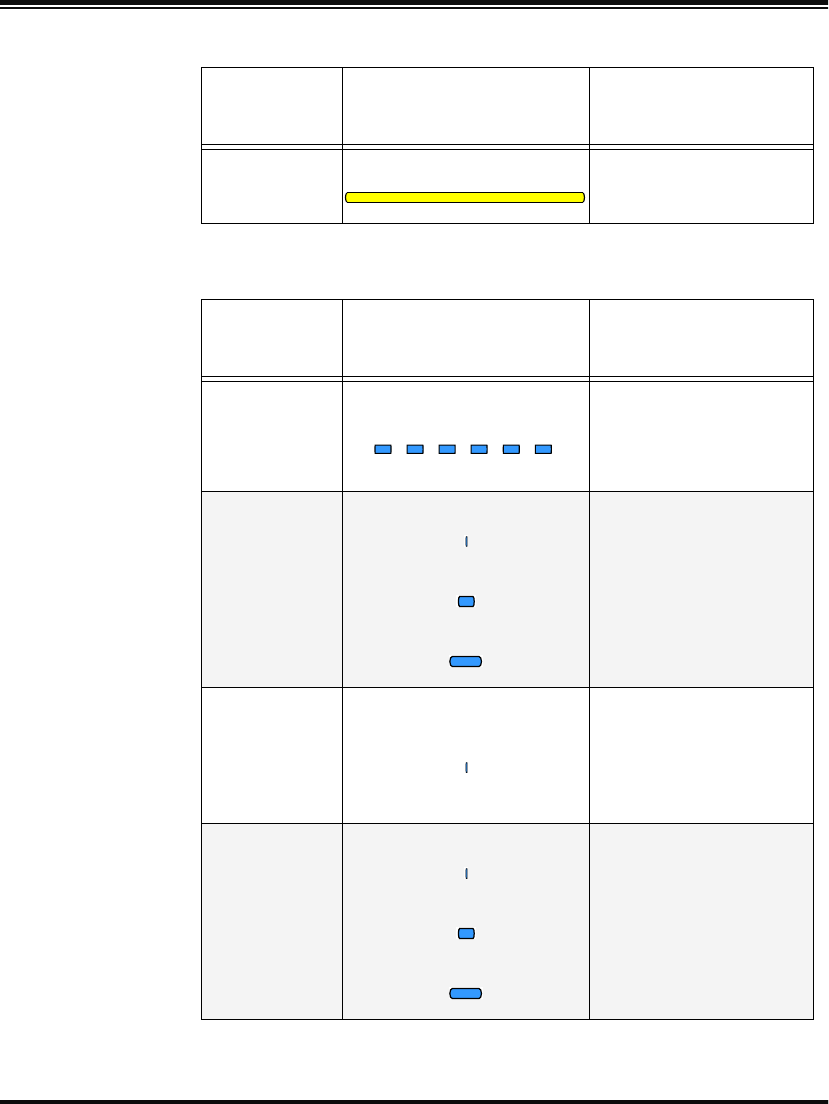
22 PowerScan™ RF Scanner
Table 2. Scanner YELLOW LED Functions
Table 3. Scanner BEEPER Functions
LED
INDICATION DURATION COMMENT
Laser on indica-
tion
On Steady The yellow LED illuminates
whenever the laser is on.
SPEAKER
INDICATION DURATION COMMENT
Scanner Not
Currently
Linked
Six beeps consisting of 20 ms
on, 20 ms off
Indicates a bar code was
read before the scanner
was linked to a Base Sta-
tion.
Good Read
Beep
100 ms on (short)
250 ms on (medium)
500 ms on (long)
Three programmable func-
tions are available. This
indicates a bar code has
been read and decoded.
Partial Read
Bip
20 ms on
A very short beep ("bip") is
sounded when one bar
code of a two-bar code pair
has been successfully
decoded.
Base Station
Acknowledge-
ment Beep
100 ms on (short)
250 ms on (medium)
500 ms on (long)
Indicates a successful bar
code transmission to the
host (configurable), a suc-
cessful change of channel,
or a successful transmis-
sion of a new configuration
to the host.
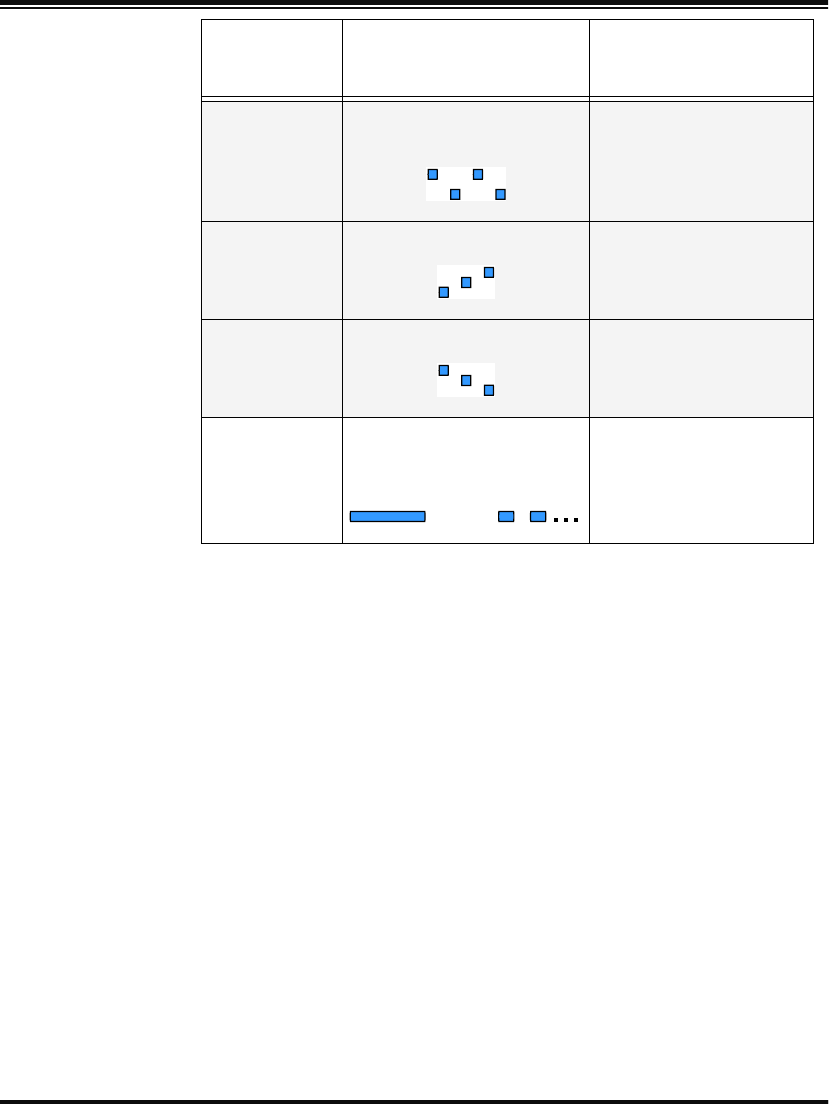
Systems Manual 23
Transmission
Error Beep
High, then low, then high, then
low. Indicates unsuccessful
transmission to the host.
Link Beep
Low, then medium, then high. Indicates a scanner has
been successfully linked to
a base station.
Unlink Beep
High, then medium, then low. Indicates a scanner has
been successfully unlinked
from a base station.
Field Replace-
able Unit (FRU)
Indications
Varies. Consists of a long tone
followed by multiple short
tones.
Enables service techni-
cians to identify Field
Replaceable Unit (FRU)
errors.
SPEAKER
INDICATION DURATION COMMENT
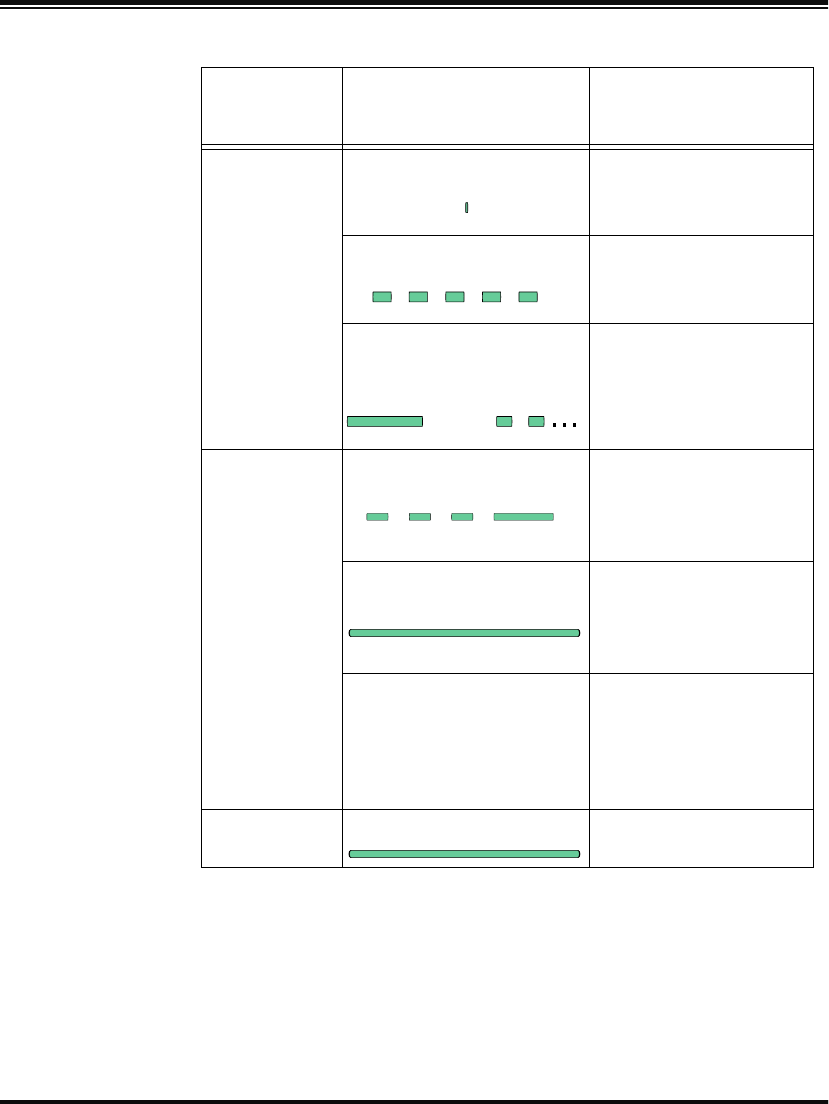
24 PowerScan™ RF Scanner
Table 4. Base Station LED Functions
LED
INDICATION DURATION COMMENT
TX/RX (Trans-
mit/Receive)
Lit for variable timea
a. The LED remains on while the unit is actively processing code which
requires a TX/RX to occur. The duration of the LED is dependent upon
the length of the message.
Indicates communications
activity to or from the Base
Station.
Continuous rapid
flashing at power-up Indicates a broken radio.
Varies. Consists of a long flash
followed by multiple short
flashes.
Enables service techni-
cians to identify Field
Replaceable Unit (FRU)
errors.
Charge
(Battery)
Continuous flashing
When a scanner is nested
in the station, this indicates
its battery is being quick
charged.
Lit Constantly
When a scanner is nested
in the station, this indicates
its battery is at or near full
charge.
Not Lit
A scanner is not present or
incorrectly inserted into the
station. It can also mean
the battery is below 0°C
(too cold for charge)
Power Lit Constantly Indicates that power is on.

Systems Manual 25
Maximizing Signal Range
Here are a few tips about how you can optimize your system installa-
tion to allow the scanner greater roving distance from its linked Base
Station while maintaining clear communication between the devices.
•Minimize obstructions between the scanner and its Base Sta-
tion. While the system is capable of communicating through
walls, a clean line of sight will always increase the scanner’s
signal range from the Base Station.
•Never place or install the Base Station in a metal-lined area or
enclosure, or near large metal objects.
•Position the Base Station and experiment at various elevations,
orientations, etc. to achieve better communications between
devices. The system usually works best at heights of one meter
or more off the ground. Usually the scanner and Base Station
work optimally when operating at about the same height.
•Ensure that programmable features are set to maximize radio
transmission. For example, if the feature Radio Transmit Power
is set to low, set it to high. Selecting a different channel using
the options under RF Channel Selection might also help. See the
section titled, RF Programmable Features, for more information
about these features.
•Consider using a Four Station Charger accessory to charge bat-
teries as opposed to using the Base Station for this function. It
offers faster charging (about half the time to a 90% charge as
Base Station charging).
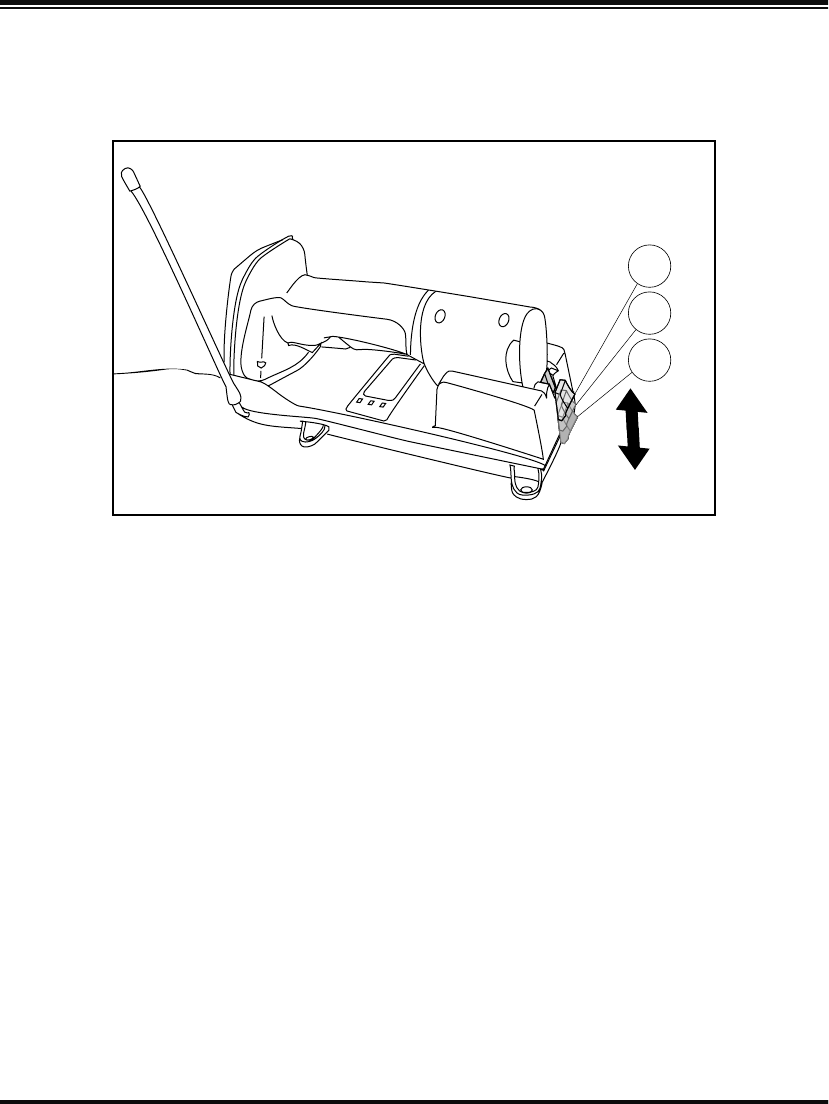
26 PowerScan™ RF Scanner
Three-Position
Lock
The Base Station is equipped with a three-position lock to allow a scan-
ner to be secured in the Base Station in horizontal, vertical, and forklift
installations.
Figure 13. Using the Three-Position Lock
1. Top position:
Vertical Forklift Mount Lock
3. Bottom position:
Unlocked
2. Middle position:
Vertical (Wall) Mount Lock
1
2
3

Systems Manual 27
Mounting the Base Station
The Base Station can be secured to varying surfaces to ensure a perma-
nent, stable installation. Several options are available.
Horizontal
(Table or
Countertop)
Mounting
Using Key
Slots
Refer to Figure 14 and follow these steps:
1. Once you have identified the desired area for permanent Base
Station installation, use the mounting template included with
this manual to mark the position of its "key slot" mounting
screws.
2. Install three #8 x 1" (4.1mm x 25.4mm) pan head, self-tapping
screws in the marked positions until completely threaded into
the mounting surface, then back the screws off two to three full
turns.
3. Ensure that power and interface cables are securely connected
and routed in the channels provided in the bottom of the Base
Station.
4. Align the Base Station key slots (wide end) with the screws,
then slide the Base Station to position the screws in the smaller
ends of the key slots. Adjust the height of the mounting screws
if needed for a secure fit. The Base Station is now secured to the
table or countertop.
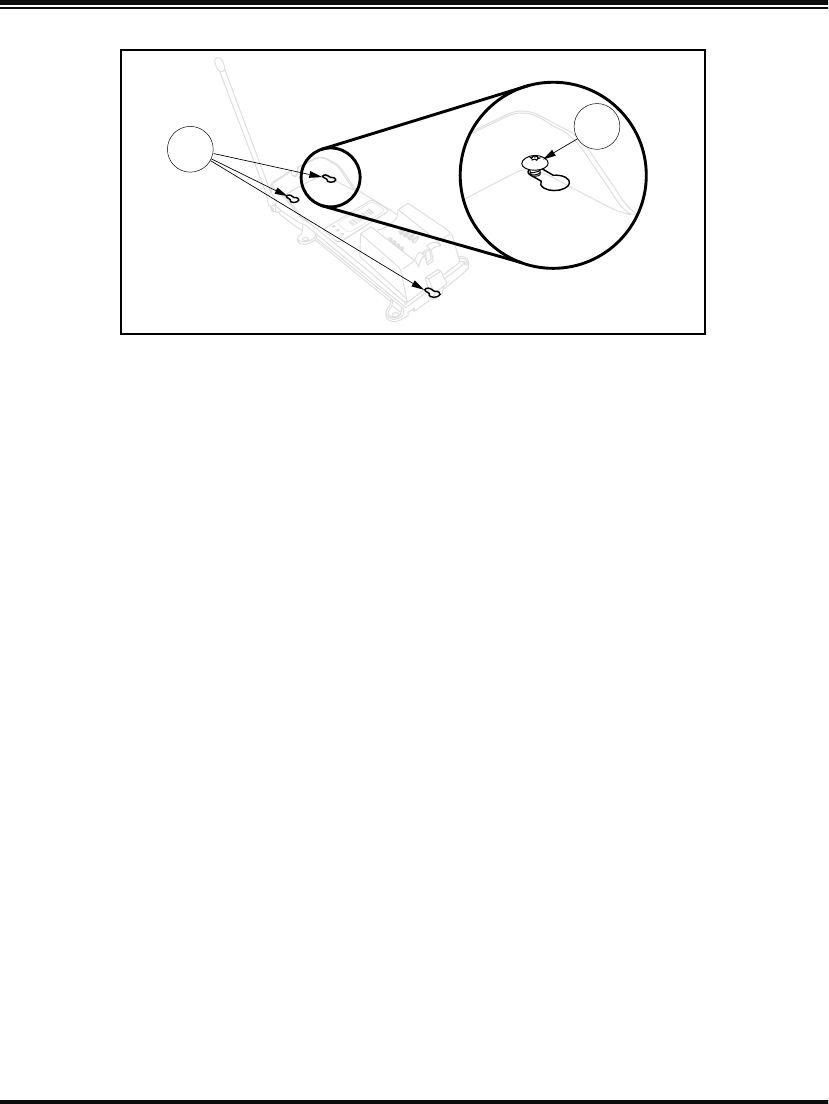
28 PowerScan™ RF Scanner
Figure 14. Mounting Using Key Slots
Using
Mounting
Flanges
Refer to Figure 15a and follow these steps:
1. Once you have identified the desired area for permanent Base
Station installation, hold the unit in place and mark the posi-
tion of screws using the "mounting flanges."
2. Start and remove four screws (provided) at the marked posi-
tions in the mounting surface.
3. Ensure that power and interface cables are securely connected
and routed in the channels provided in the bottom of the Base
Station.
4. Secure the Base Station to the surface by installing the four
screws into the mounting flanges. Base Station attachment is
now complete.
1. Key Slots 2. #8 x 1" (4.1mm x 25.4mm) Pan
Head Screw
BASE ID
TX/RX
CHARGE
POWER
12
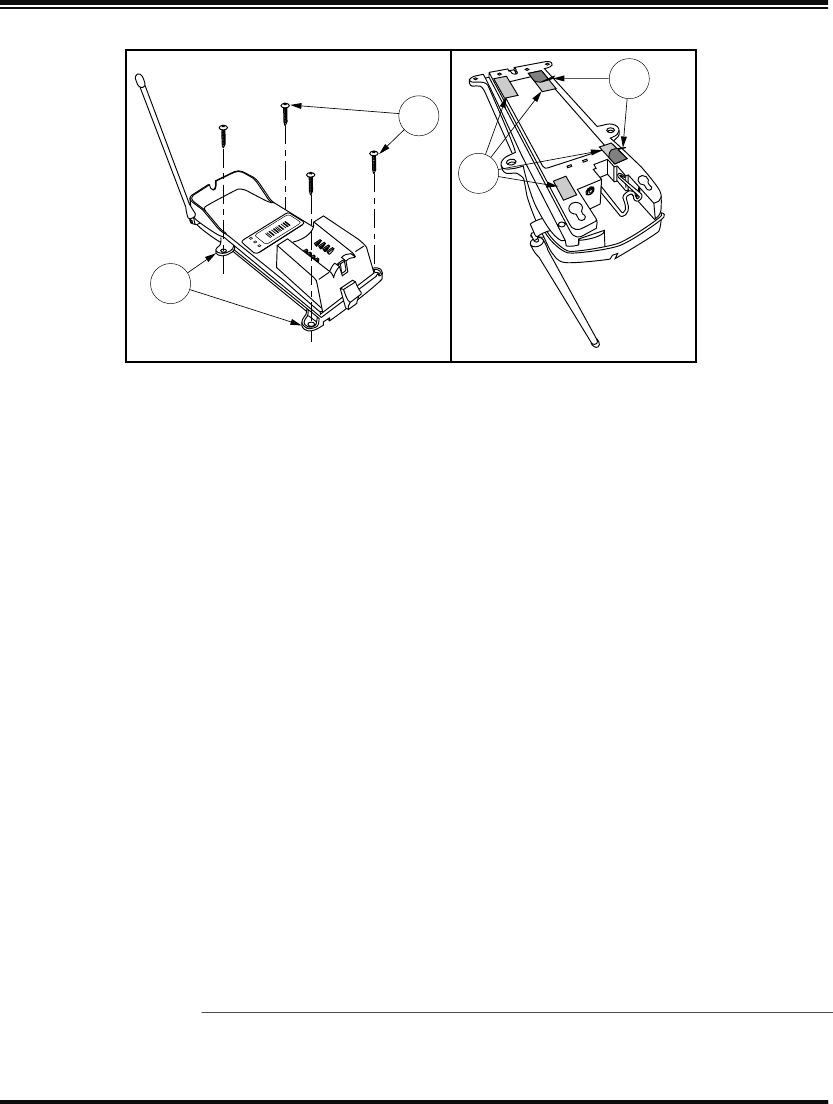
Systems Manual 29
Figure 15. Mounting Using Flanges or Two-sided Tape
Mounting
Using Two-
Sided Tape
You can also affix the Base Station to a surface using the two-sided tape
strips provided with the unit. Simply remove the backing from one
side of the strips and apply them to the bottom of the Base Station as
shown in Figure 15b. Remove the remaining backing from the tape,
then position and firmly press the unit against a smooth, clean surface
in the orientation desired.
Vertical (Wall)
Mounting
The Base Station can be mounted vertically using the same methods as
horizontal mounting (see previous section):
•Using Key Slots
•Using Mounting Flanges
•Mounting Using Two-Sided Tape 1
1. Mounting Flanges (4) 3. Two-sided Tape Strips
2. 4 Screws (provided) 4. Backing
BASE ID
TX/RX
CHARGE
POWER
1
2
3
4
ab
1. Since mounting using this method offers less secure attachment, verify that your tape installation
is robust enough for your application.
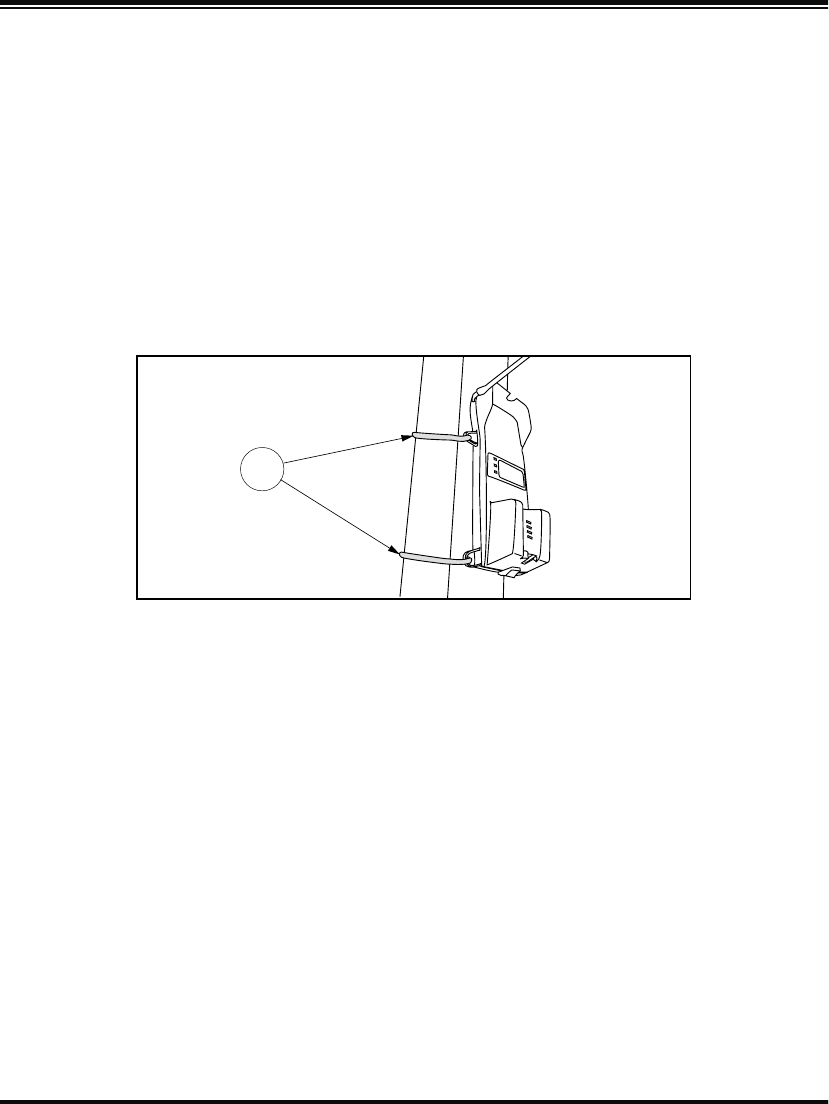
30 PowerScan™ RF Scanner
Post or Forklift
Mounting
To secure the Base Station to a post or forklift frame, refer to Figure 16
and follow these steps:
1. Verify that the desired mounting area offers sufficient space for
safe forklift operation and will not present a hazard for opera-
tors or potentially damage the mounted device(s).
2. Ensure that power and interface cables are securely connected
and routed in the channels provided in the back of the Base
Station.
3. Using tie-wraps or a similar strapping material, secure the
Base Station (through the mounting flanges) to a post or frame.
Tighten and adjust as needed to assure a secure installation.
Figure 16. Post or Forklift Mounting
1. Tie Wraps
1
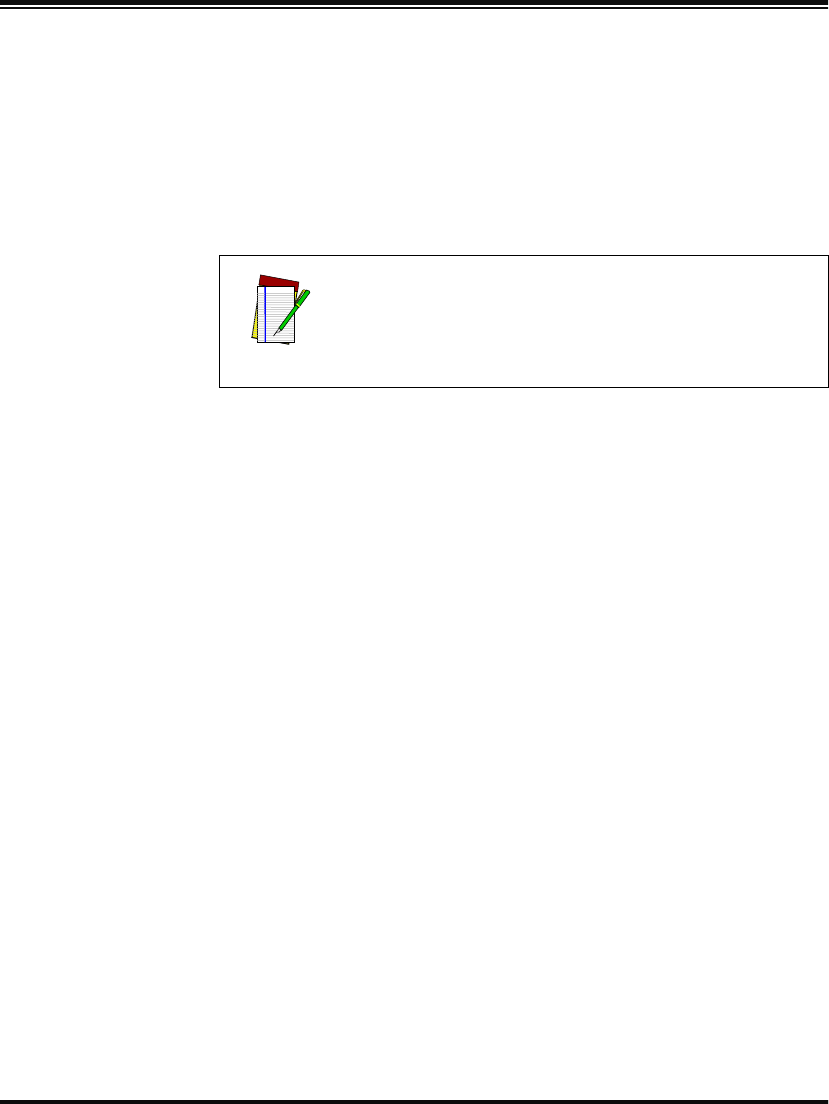
Systems Manual 31
RF Programmable Features
Use the special programming bar codes contained in this section to set
features that are unique to RF models of PowerScan™ bar code scan-
ners. To program other features that are common to all models, use one
of the following:
- Configurator Express™ On-Screen Programming Kit
- PowerScan™ Programming Guide
Programming features included in this manual are:
•RF Beeper Settings
•Radio Transmit Power
•RF Channel Selection
•Transmission Retries Before Message Time-out
•Wait Time for ACK
•Wait Time For Scanner Power Shutdown
•Wait Time Between Retries of Failed Transmission
•HACK Transmit Options
•Wait Time For HACK From Host
•Drop Links on Reset Option
•Drop Oldest Links Option
•Common Configuration
•Set Maximum Linked Scanners
•Source-Radio Identification (ID)
•Low Battery LED Indication
NOTE
See References on page 1 for more information
about how to obtain kits, software and manuals for
this product.
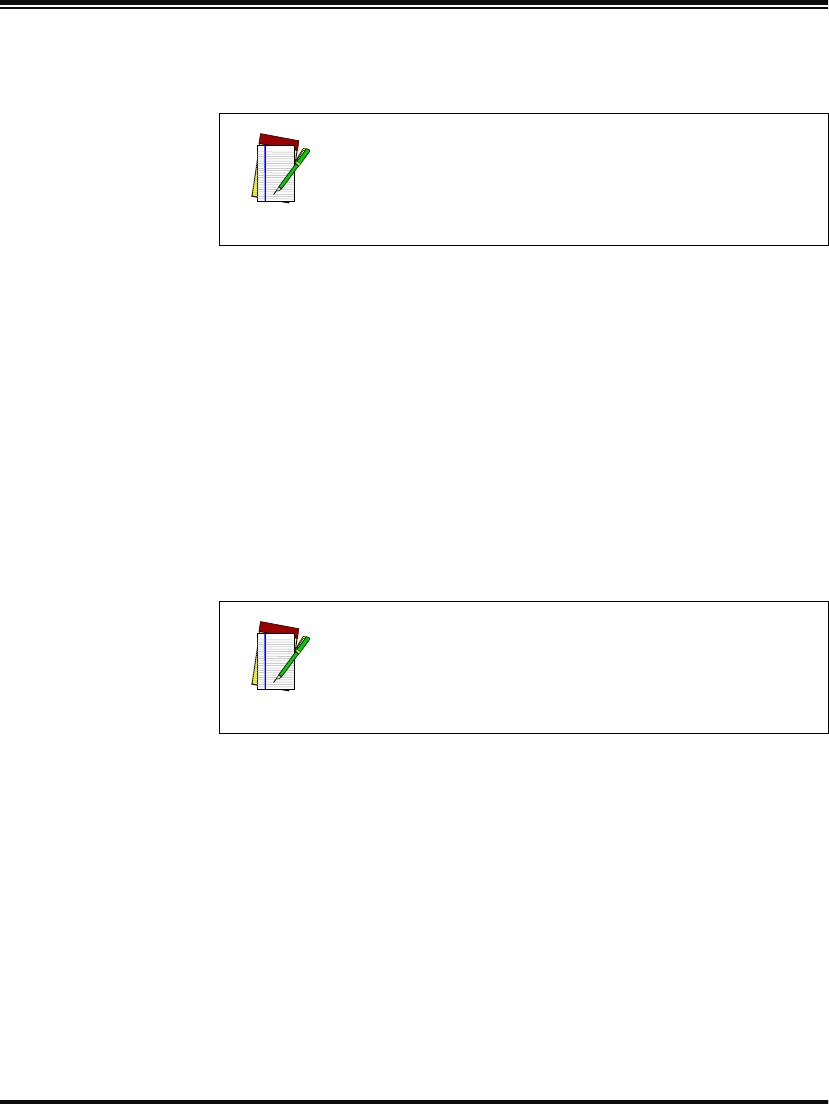
32 PowerScan™ RF Scanner
Programming
Overview
The RF system’s programmable feature settings can be modified to
accommodate your unique requirements. Listed below are the various
methods to configure scanner and Base Station units:
Scanner
1. The Base Station’s configuration files can be automatically
downloaded to the scanner at the time of linking. See the sec-
tions, Linking the Scanner to a Base Station and Common Configu-
ration for more details.
2. The easiest, most comprehensive way to program the scanner
is to use the Configurator Express™ On-Screen Programming
Kit. See References for more information about this product.
3. The scanner can be configured using special programming bar
codes like those contained in this section. For the most part, the
programming instructions and bar codes on the following
pages address this method of scanner configuration.
NOTE
Base Stations and the scanners linked to them must
possess compatible configuration files.
NOTE
If you program the scanner using any of the
methods above, the scanner will store the changes
until reprogrammed or returned to factory defaults.
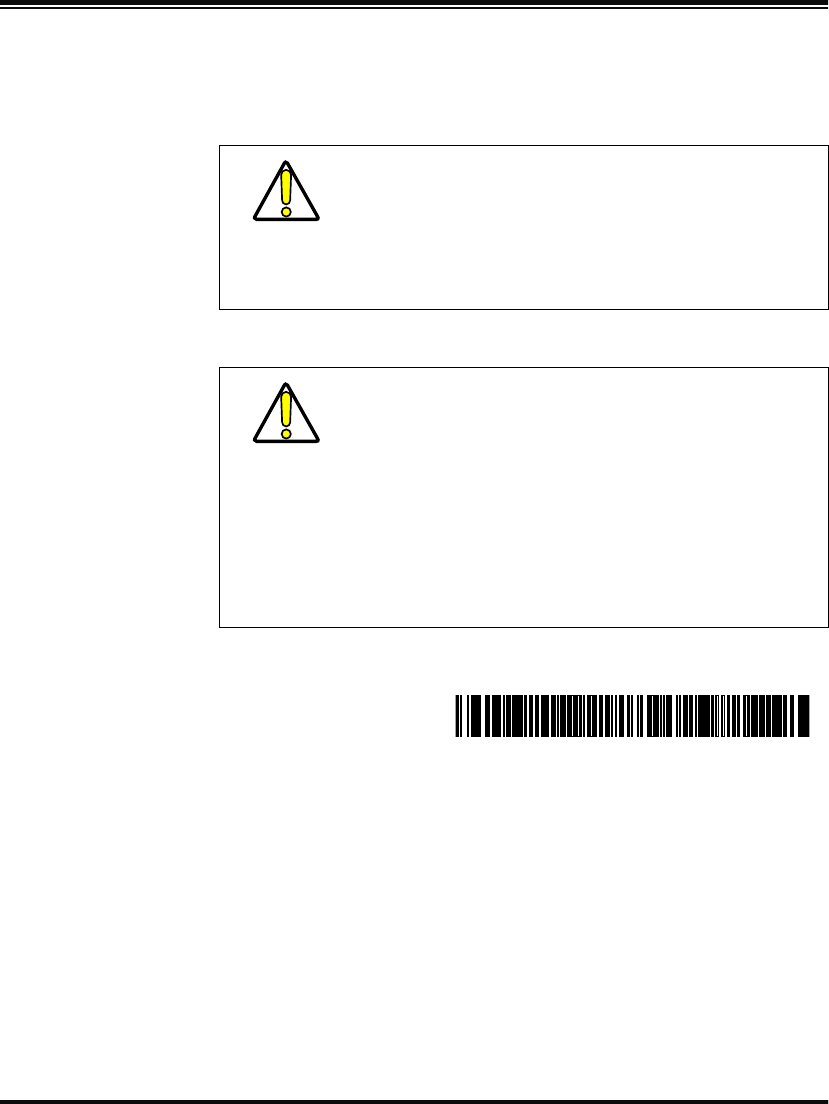
Systems Manual 33
Base Station
Base Station configuration is primarily performed by first program-
ming a scanner with the desired options, then downloading the config-
uration to the Base Station from that scanner.
Use the bar code below to overwrite a Base Station’s configuration file.
What Is
Programming
Mode?
The scanner must be placed into the Programming Mode state in order
to accept programming commands. When programming using the bar
code labels in this manual, the scanner is placed in Programming Mode
by scanning the "SET" label at the top of most programming feature
pages.
While in Programming Mode, the scanner only recognizes special pro-
gramming bar codes. See the section, LED and Beeper Indications for
information about scanner indications while in Programming Mode.
CAUTION
Verify that the scanner and Base Station host inter-
face types (RS-232, Keyboard Wedge, etc.) are
matched before attempting to download any config-
uration files or perform any custom programming
sessions. Go to Interface (I/F) selection on page x
and set the scanner to the Base Station’s I/F type.
CAUTION
After the Base Station receives the entire configura-
tion, it will drop all links to scanners other than the
scanner transmitting the new configuration. This
will require the user to relink all other scanners (see
Linking the Scanner to a Base Station). Prior to the
time of relinking, it is advisable to consider
enabling the feature, Common Configuration,
ensuring that the Base Station will attempt to share
the new configuration with scanners as they are
linked.
Transmit Scanner
Configuration to Base
Station ---------
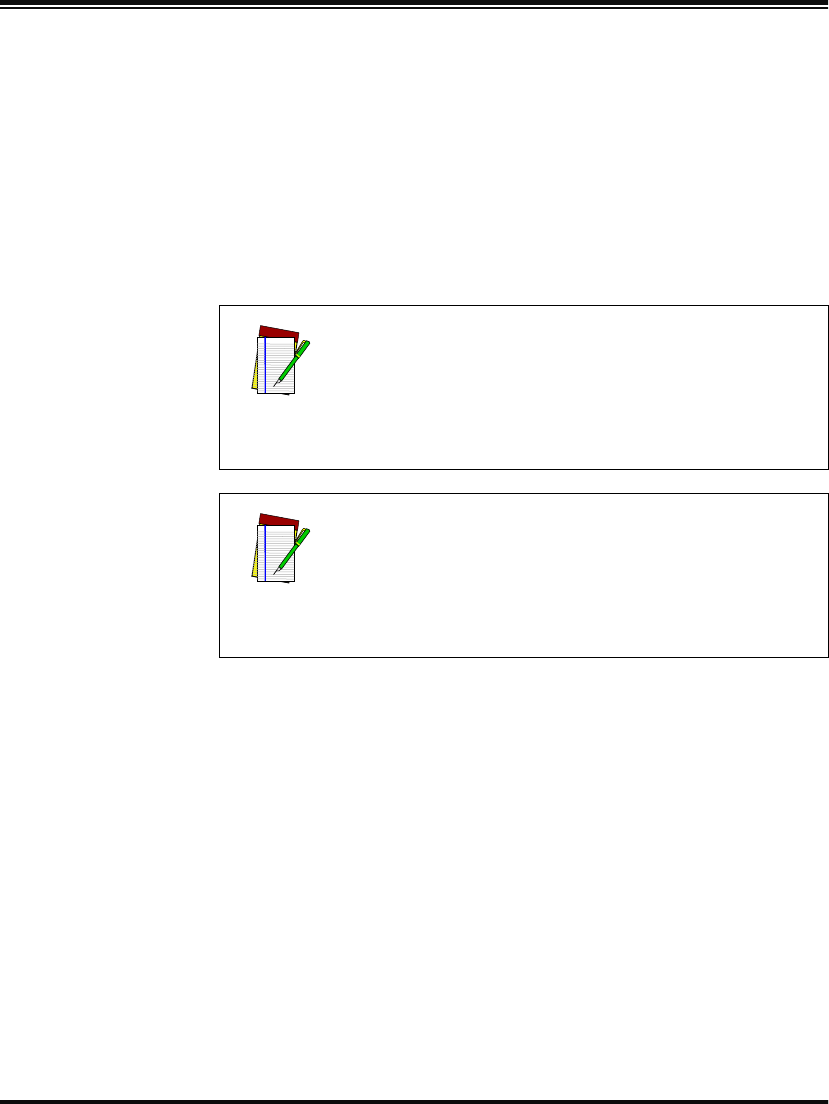
34 PowerScan™ RF Scanner
The
Programming
Session
Scanner programming allows you to customize the scanner’s configu-
ration to match your specific needs. A typical programming session is
conducted as follows:
1. Scan the SET bar code at the top of the page. The scanner will
emit one beep, indicating it has read the bar code and the green
LED will flash on and off slowly while the scanner remains in
Programming Mode. Normal scanning functions are disabled.
2. Scan the programming bar codes(s) to make the desired
changes. With few exceptions, the scanner will emit a triple
beep each time you scan a valid programming bar code..
3. Scan the END label at the bottom of the page to save any new
settings and exit Programming Mode. The scanner will sound
a beep and reset upon exiting Programming Mode, and the
green LED will return to its usual state (on steady or off).
The scanner will not exit Programming Mode unless the END
bar code is scanned or the scanner’s battery is removed.
Removing power during Programming Mode, before scanning
the END label, will cause all new settings to be ignored. On
power-up, the scanner will return to previous settings.
NOTE
Not all features are available for all interfaces. The
scanner will sound an error tone when scanning
programming bar codes for features that cannot be
used with the currently active interface. Only fea-
tures supported by the currently active interface
will be implemented.
NOTE
If you are enabling a different interface (I/F), we sug-
gest/recommend that you change the I/F designa-
tion first and then proceed with other changes.
Once a bar code is scanned that changes the scan-
ner’s I/F, all previous I/F configuration items
scanned in the programming session are lost.

Systems Manual 35
4. Maintain a record of all changes made to ensure that you
know if the original factory settings have been changed. Use
the following table to log your custom configuration changes.
RF
Programmable
Feature
Factory
Default
Setting
Your
Setting Comment
RF When to Beep Option 7
RF Beeper Volume Vol 3
RF Beeper Frequency High
RF Beep Duration 50ms
Radio Transmit Power High
RF Channel Selection Channel 1
Transmission Retries
Before Message Time-
out
3 Retries
Wait Time for ACK 200ms
Wait Time for Scanner
Power Shutdown 1 Second
Wait Time Between
Retries of Failed Trans-
mission
90ms
HACK Transmit Options
HACK upon
Base Station
transmission to
host
Wait Time for HACK
From Host 1 Second
Drop Links on Reset
Option Disable
Drop Oldest Links
Option Enable

36 PowerScan™ RF Scanner
Programming
Sequence
To modify a scanner feature (item), the programming bar codes con-
tained in this manual must be scanned in a given sequence depending
upon the feature being programmed (as shown in Table 5). There are
three possible programming sequences:
A. Programming sample A (the most commonly used format)
demonstrates how three bar codes are scanned in sequence to
do the following:
1. Place the scanner in Programming Mode (SET bar code).
2. Scan the Item Tag1 that will enable the new feature.
3. End the programming session and reset the scanner (END
bar code).
B. Sample B provides an example of a programming feature
requiring the entry of a range value. Like sample A, the scan-
ner is placed in Programming Mode and an Item Tag1 is
scanned. Then, a value must be entered before ending the pro-
gramming session. In the example, three digits must be
scanned from the number pad in Appendix B. This type of for-
mat, requiring a total of as many as six programming bar
codes, is necessary to allow flexible programming with larger
item value numeric ranges.
C. The programming sequence shown in example C requires
scanning of a single, extended length bar code. This special
programming bar code contains all the data necessary to enter
Programming Mode, set the Item Tag1 and Item Value, and exit
Programming Mode (all in one step).
Common Configuration Disable
Set Maximum Linked
Scanners 8
Source-Radio Identifi-
cation (ID) Don’t Include
Low Battery LED Indi-
cation Enable
1. An “Item Tag” is a term used to describe an assigned number, which is encoded in a programming
bar code, that toggles (selects, enables, disables, etc.) a specific programming feature.
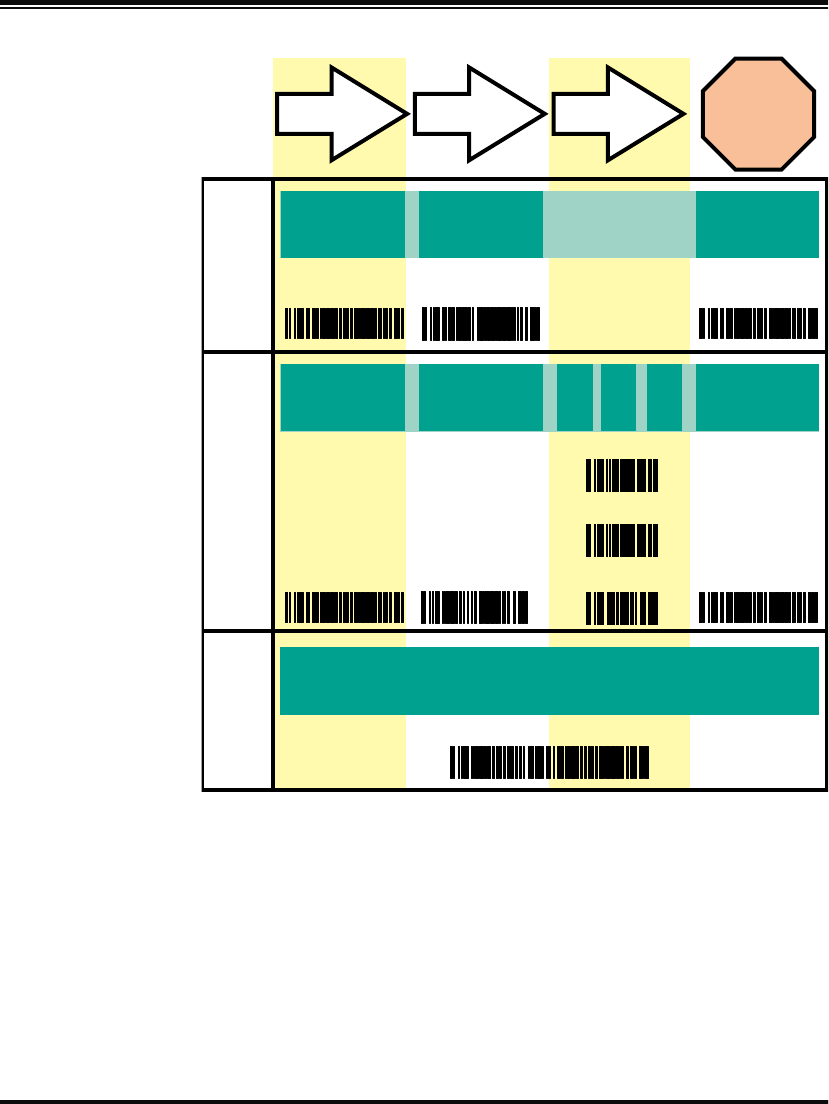
Systems Manual 37
Table 5. Programming Sequence
1
1
C
A
B
23
123456
SET
SET
ENABLE
NEW FEATURE
ENABLE NEW
FEATURE
USING THE
FOLLOWING
SETTINGS...
END
SET END
0
8
ITEM TAG ITEM VALUE END/RESET
0
ONE BAR CODE CONTAINS SET + ITEM TAG + ITEM VALUE + END
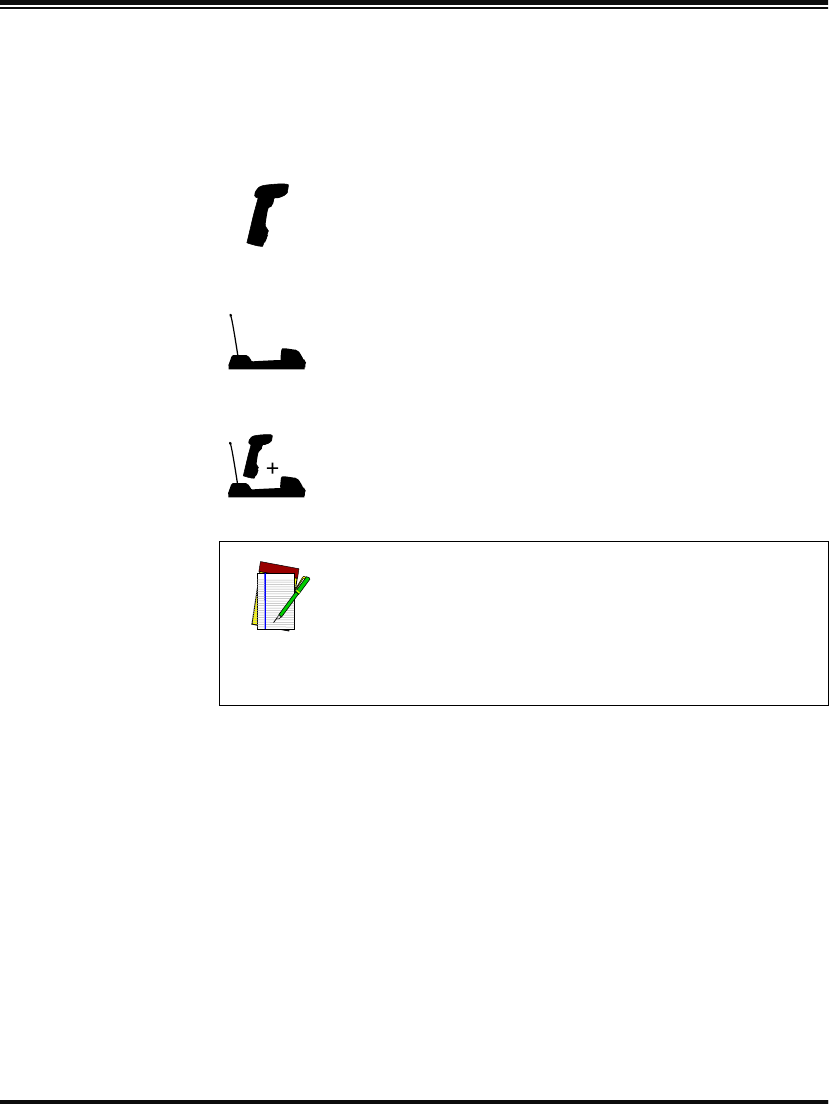
38 PowerScan™ RF Scanner
Scanner vs.
Base Station
Features
Some programming features are specific to either the scanner (hand-
held unit) or the Base Station, while others are applicable to both. Each
feature in this manual is marked with an indicator as to which unit(s) it
is applicable.
Feature is specific to scanner ONLY
Feature is specific to Base Station ONLY
Feature is applicable to scanner and Base Station.
NOTE
When programming using bar codes via the scan-
ner, it is important to remember that features affect-
ing the Base Station WILL NOT be enabled until the
new configuration is downloaded to the Base Sta-
tion using the feature Transmit Scanner Configura-
tion to Base Station on page 33.
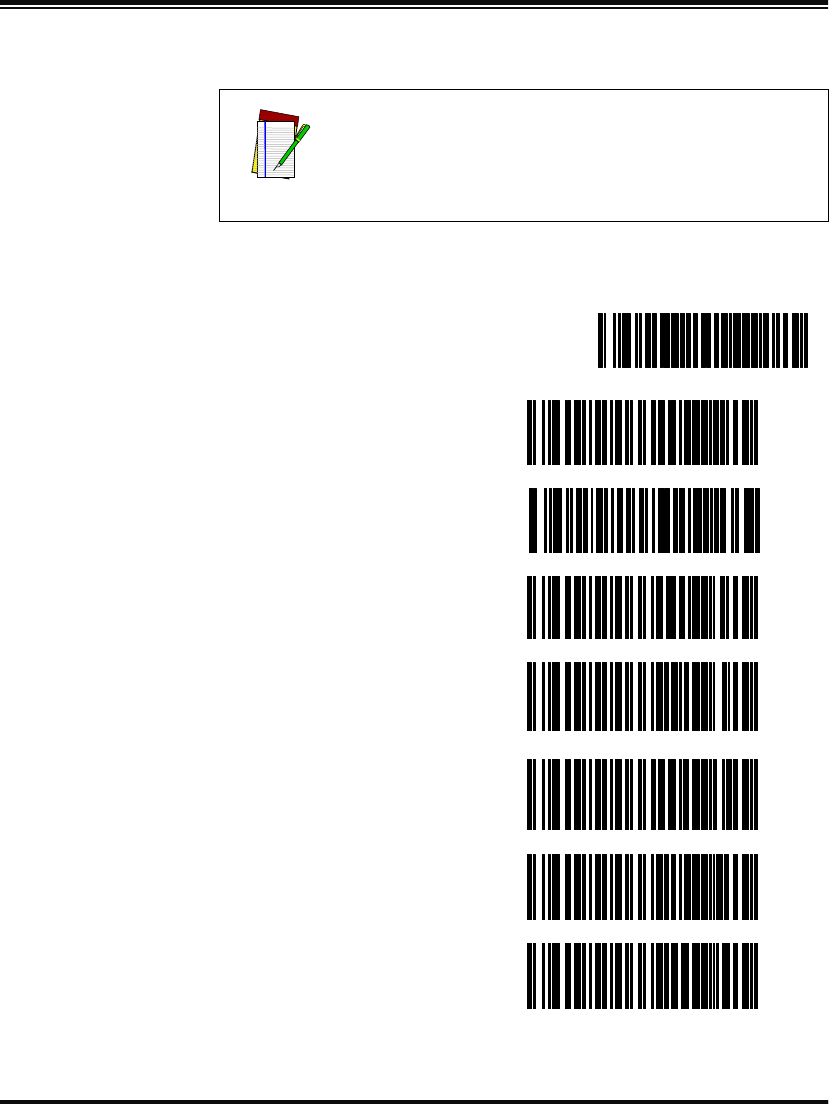
Systems Manual 39
Interface (I/F)
Selection
It is very important that the scanner and Base Station are each config-
ured to operate with the same interface (I/F) type as the host terminal.
NOTE
The Base Station uses a “smart” cable, which auto-
matically sets the Base Station to the correct I/F
upon power-up and connection to the appropriate
host.
SET -------------------------------------------
Enable Wand Emulation ---------
Enable Standard
RS-232 ---------
Enable Wincor Nixdorf
RS-232 ---------
Enable IBM Port 5B ---------
Enable IBM Port 9B ---------
Enable IBM Port 17 ---------
Enable IBM Port E ---------
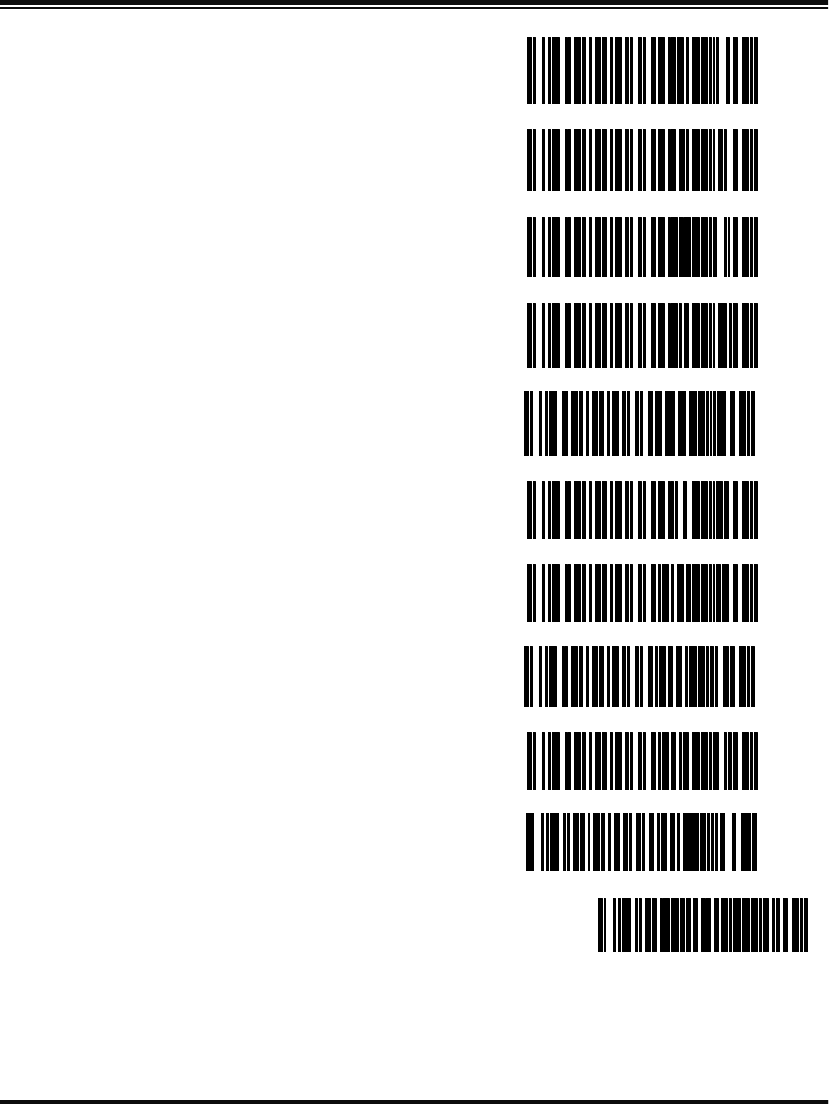
40 PowerScan™ RF Scanner
Enable Keyboard Wedge
Type Aa ---------
Enable Keyboard Wedge
Type B ---------
Enable Keyboard Wedge
Type C ---------
Enable Keyboard Wedge
Type D ---------
Enable Keyboard Wedge
Type E ---------
Enable Keyboard Wedge
Type F ---------
Enable Keyboard Wedge
Type G ---------
Enable Keyboard Wedge
Type H ---------
Enable Keyboard Wedge
Type I ---------
Enable Keyboard Wedge
Type J ---------
END ------------------------------------------
a. See Table 6 for the specific interfaces supported by each of the keyboard
types listed above. See the following section Universal Keyboard Wedge
I/F Selection to enable that interface type.
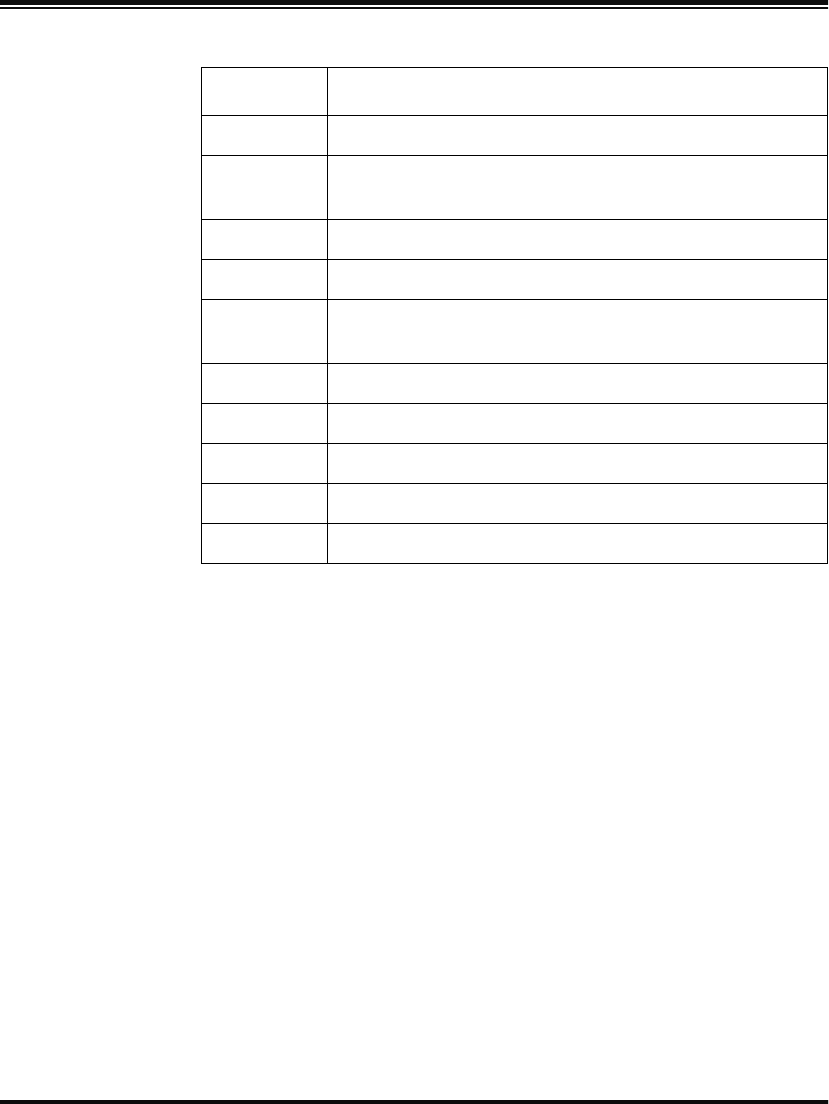
Systems Manual 41
Table 6. Keyboard Wedge I/F Selection
I/F Type PCs Supported
A PC/XT w/Alternate Key Encoding
BAT, PS/2 25-286, 30-286, 50, 50Z, 60, 70, 80, 90 & 95
w/Alternate Key Encoding
C PS/2 25 and 30 w/Alternate Key Encoding
D PC/XT w/Standard Key Encoding
EAT, PS/2 25-286, 30-286, 50, 50Z, 60, 70, 80, 90 & 95
w/Standard Key Encoding
F PS/2 25 and 30 w/Standard Key Encoding
G IBM 3xxx w/122 keyboard
H IBM 3xxx w/102 keyboard
I PS/55 5530T w/104 keyboard
J NEC 9801
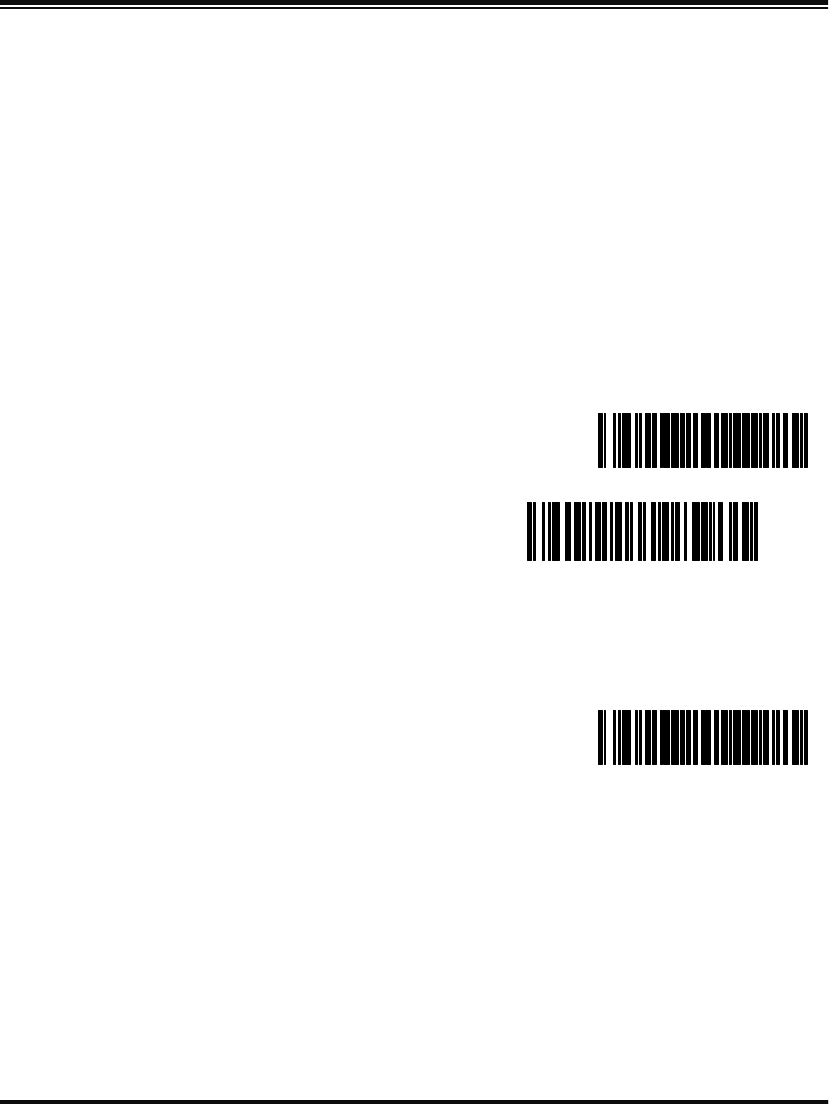
42 PowerScan™ RF Scanner
Universal
Keyboard
Wedge I/F
Selection
To activate the Universal Keyboard Wedge interface, follow these
instructions:
1. Scan the START bar code.
2. Determine the I.D. of the terminal/keyboard. This information
is available in the Universal Keyboard Wedge Connectivity
Guide (R44-2039), or refer to the Terminal/Keyboard Settings sec-
tion below for a listing of the most common keyboard I.D.s.
3. Scan the ACTIVATE UNIVERSAL KEYBOARD WEDGE
INTERFACE bar code on the following page.
4. Using the "number pad" in Appendix B, scan in the digits for
the keyboard I.D. number you determined in step 2.
5. Scan the END bar code.
SET -------------------------------------------
Activate Universal Keyboard
Wedge Interface ---------
Scan the digit(s) representing the desired keyboard interface type
using the Number Pad in Appendix B, then scan the END bar
code.
END ------------------------------------------
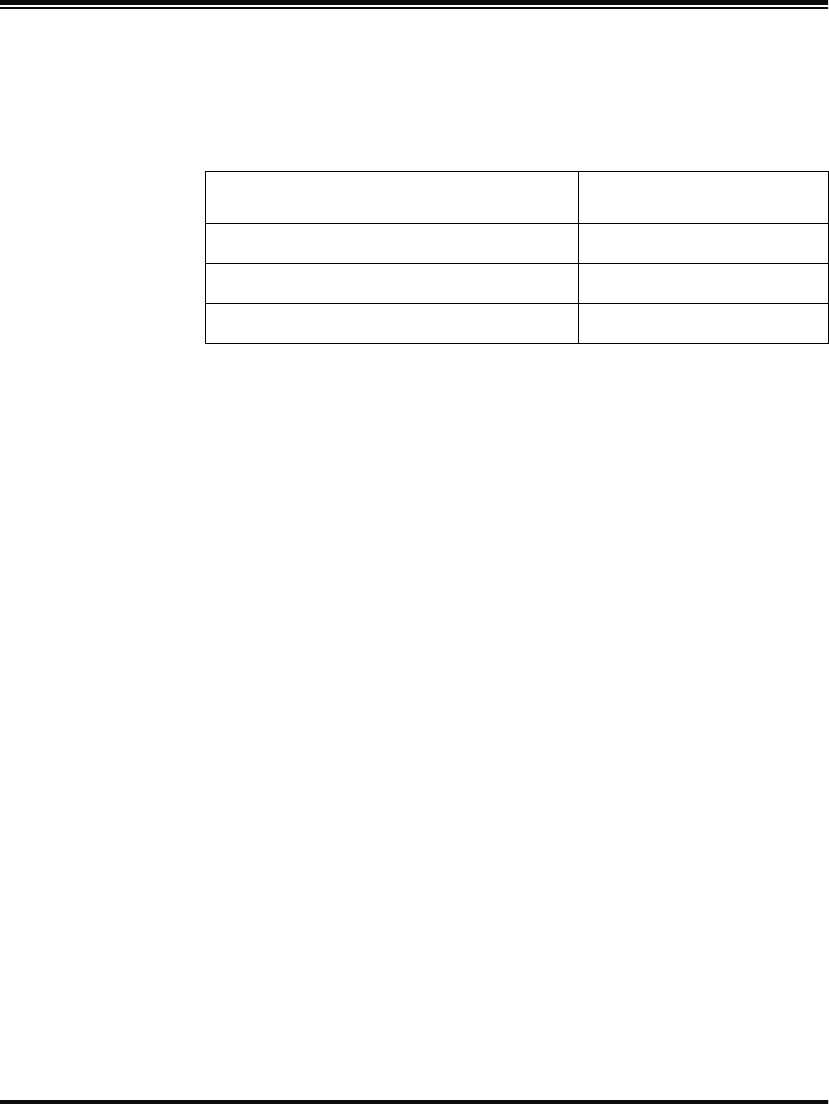
Systems Manual 43
Terminal/
Keyboard
Settings
The list below contains the most common terminal/keyboard types. If
your specific system is not listed below, consult the Keyboard Wedge
Connectivity Guide (P/N R44-2039) for a detailed listing of terminal/
keyboard types. A copy of the guide can be obtained from the internet
at www.pscnet.com, or call your dealer for customer support informa-
tion.
Keyboard Terminal I.D.
PC XT 10
PC AT, PS2 11
MAC 25
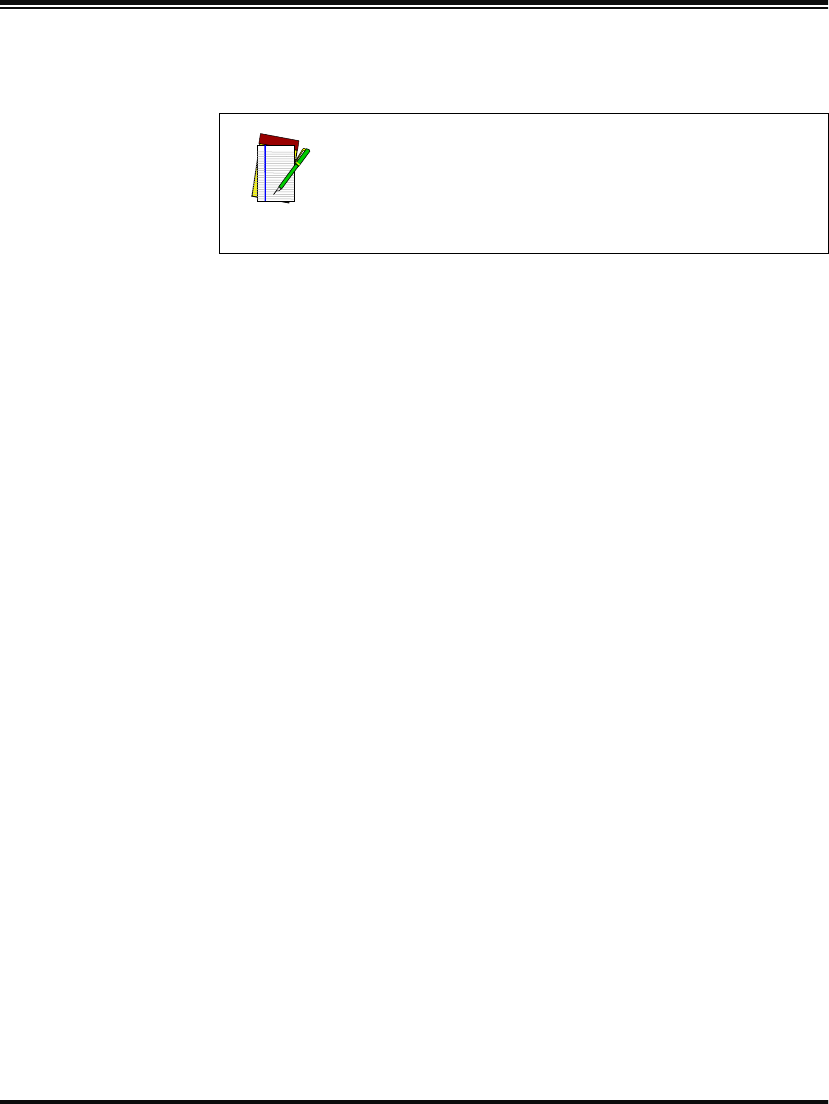
44 PowerScan™ RF Scanner
RF Beeper
Settings
The RF version of the scanner exhibits different beeper behavior than
standard (non-RF) models. For more information about RF beeper indi-
cations, see the section, LED and Beeper Indications.
Good Read Beep — When good read beep is enabled, this beep sounds
at the time the scanner successfully reads a bar code. Selectable settings
for the good read beep include:
•RF When to Beep
•Beeper Volume
•Good Read Beep Frequency
•Beep Duration
ACK Beep — The scanner can sound an acknowledgement (ACK)
beep to indicate when the Base Station has acknowledged to the scan-
ner that is has received a successful data transmission from the scanner.
This beep is also sounded upon a successful channel change sequence
or a successful configuration transmission.
Transmission Error Beep — Another selectable indicator beep is the
transmission error beep. This beep sounds to indicate an error in trans-
mission between the RF devices.
Link Beep — The handheld scanner will sound a special link beep
upon successfully linking with a Base Station. This indication cannot be
disabled and is not programmable, other than that it shares the same
Beeper Volume setting as other beeper indications set using that fea-
ture.
Unlink Beep — When a scanner is successfully unlinked from a Base
Station, a unique unlink beep is sounded. This beep is not programma-
ble, and also sounds at the same volume set for Beeper Volume.
NOTE
The following descriptions highlight configurable
beeper functions that are unique to RF handheld
scanners. All other beeper functions supported by
the standard version of the scanner are supported
by RF models.
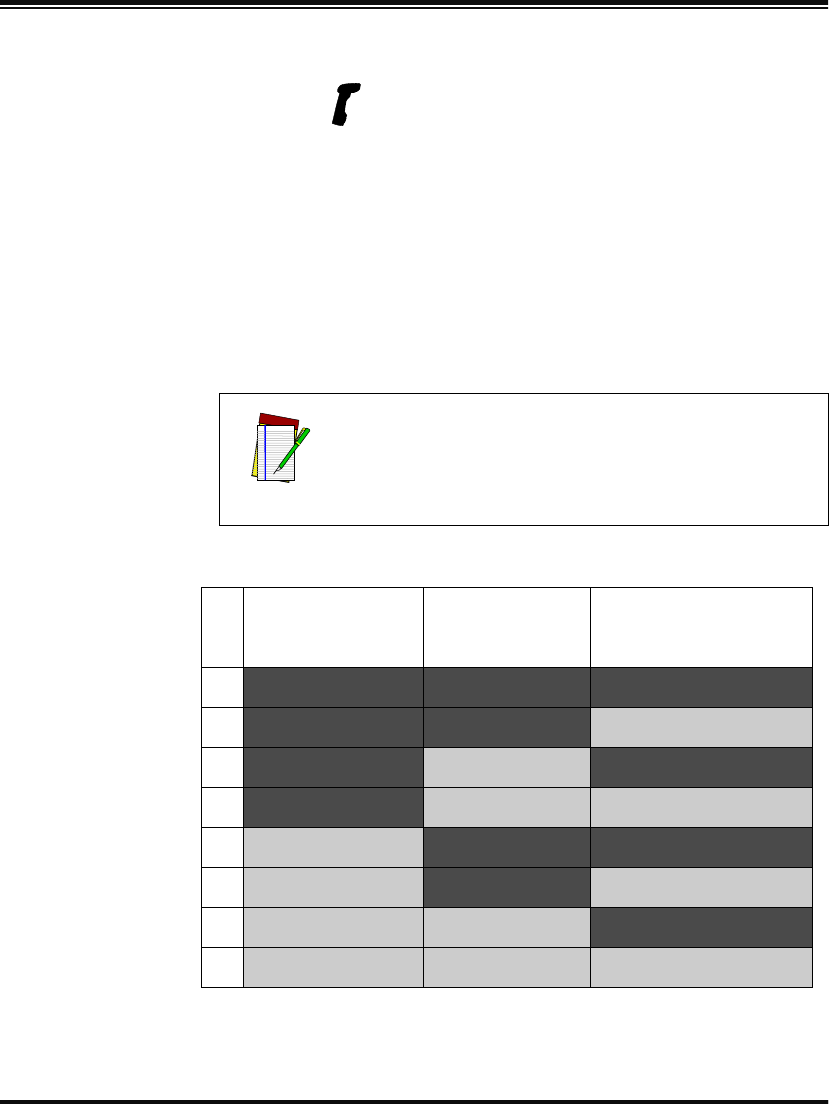
Systems Manual 45
RF When to
Beep
Several options are available to specify how the RF handheld scanner
will beep to indicate a good read. Settings are based on the enable/dis-
able status desired for three selectable beep indications:
•Good Read Beep
•Acknowledgement (ACK) Beep
•Transmission Error Beep
The available options are described and numbered in Table 7 to corre-
spond with the programming bar codes provided for this feature.
Table 7. RF When to Beep Options
Feature is specific to scanner ONLY
NOTE
These settings supersede any settings made using
the generic "When to Beep" feature listed in the
PowerScan Programming Manual.
#Good Read
Beep ACK Beep Transmission Error
Beep
0Disabled Disabled Disabled
1Disabled Disabled Enabled
2Disabled Enabled Disabled
3Disabled Enabled Enabled
4Enabled Disabled Disabled
5Enabled Disabled Enabled
6Enabled Enabled Disabled
7Enabled Enabled Enabled
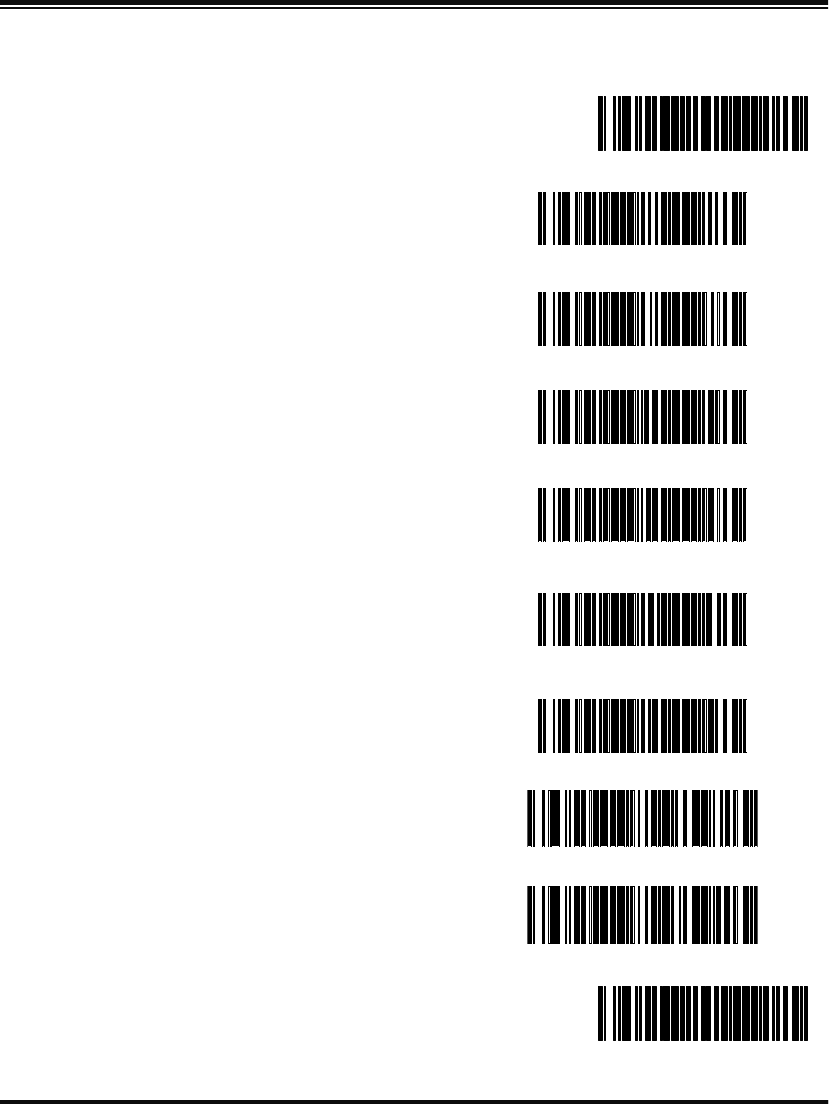
46 PowerScan™ RF Scanner
RF When to
Beep Options
(continued)
SET -------------------------------------------
When to Beep
Option #0 ---------
When to Beep
Option #1 ---------
When to Beep
Option #2 ---------
When to Beep
Option #3 ---------
When to Beep
Option #4 ---------
When to Beep
Option #5 ---------
When to Beep
Option #6 ---------
When to Beep
Option #7 ---------
END ------------------------------------------
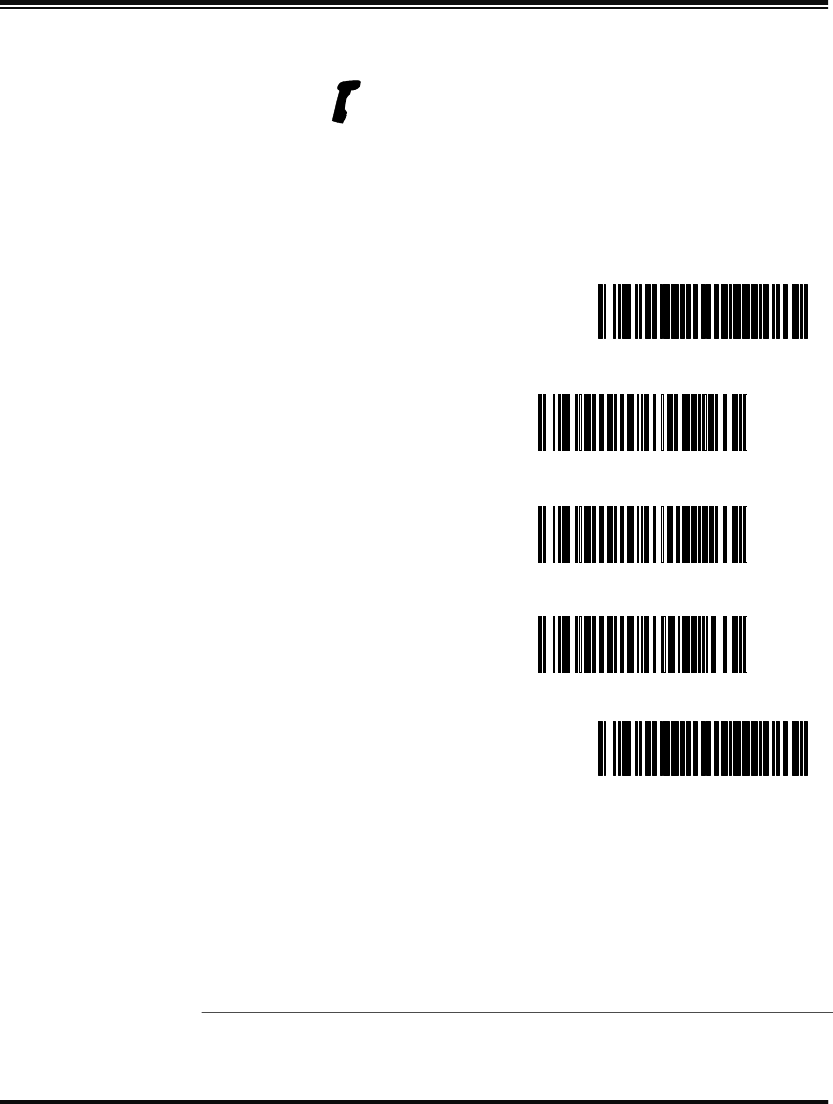
Systems Manual 47
RF Beeper
Volume
The volume at which the beeper sounds for ACK, transmission error,
link, or unlink beeps (but not the good read beep1) are all affected by
this setting. Select volume #1 (25% duty cycle), volume #2 (35% duty
cycle), or volume #3 (50% duty cycle).
Feature is specific to scanner ONLY
1. Good read beep volume is selectable via the features available in the PowerScan Programming
Manual (P/N R44-1840). See References for information about acquiring other manuals.
SET -------------------------------------------
RF Beeper Volume #1 ---------
RF Beeper Volume #2 ---------
RF Beeper Volume #3 ---------
END ------------------------------------------
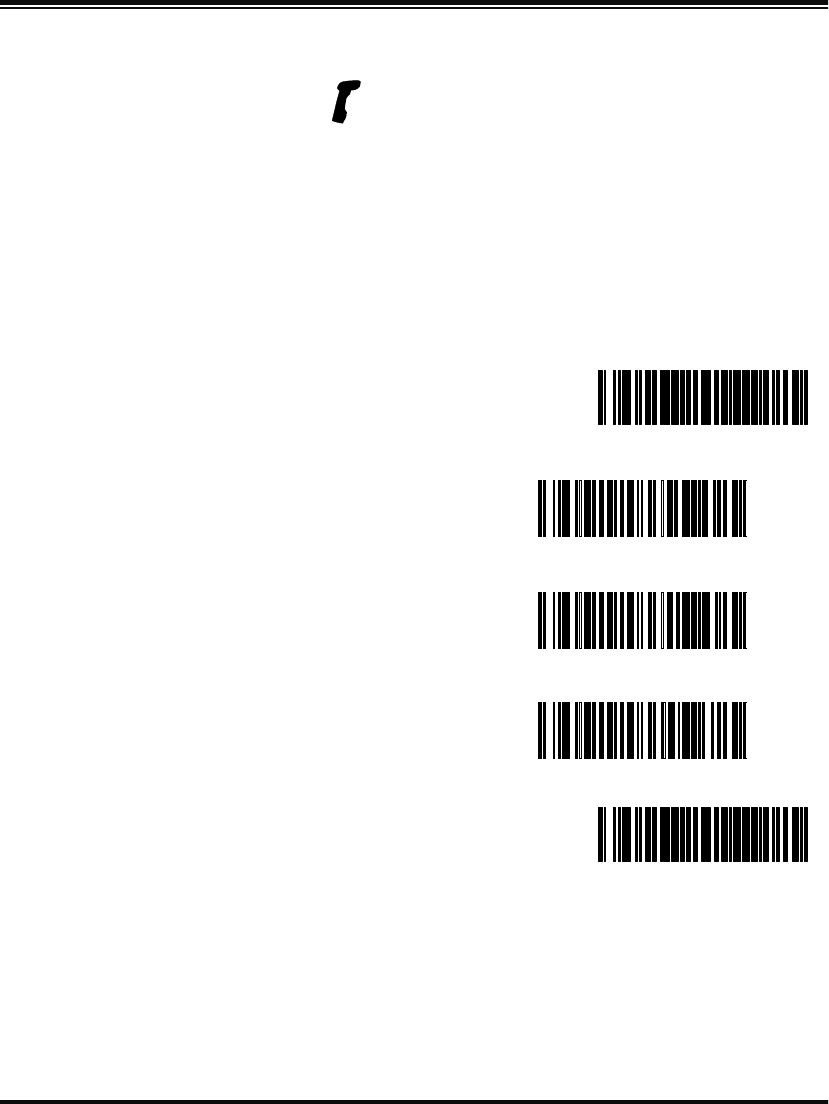
48 PowerScan™ RF Scanner
RF Beeper
Frequency
This setting affects the frequency at which the ACK beep is sounded,
and is independent of the frequency setting for the good read beep.
When the ACK beep is sounded at a different frequency than the good
read beep, this can provide a clearer distinction between the tones.
Select low frequency (760Hz), medium frequency (1250Hz), or high fre-
quency (2400Hz).
Feature is specific to scanner ONLY
SET -------------------------------------------
RF Beeper Low
Frequency ---------
RF Beeper Medium
Frequency ---------
RF Beeper High
Frequency ---------
END ------------------------------------------
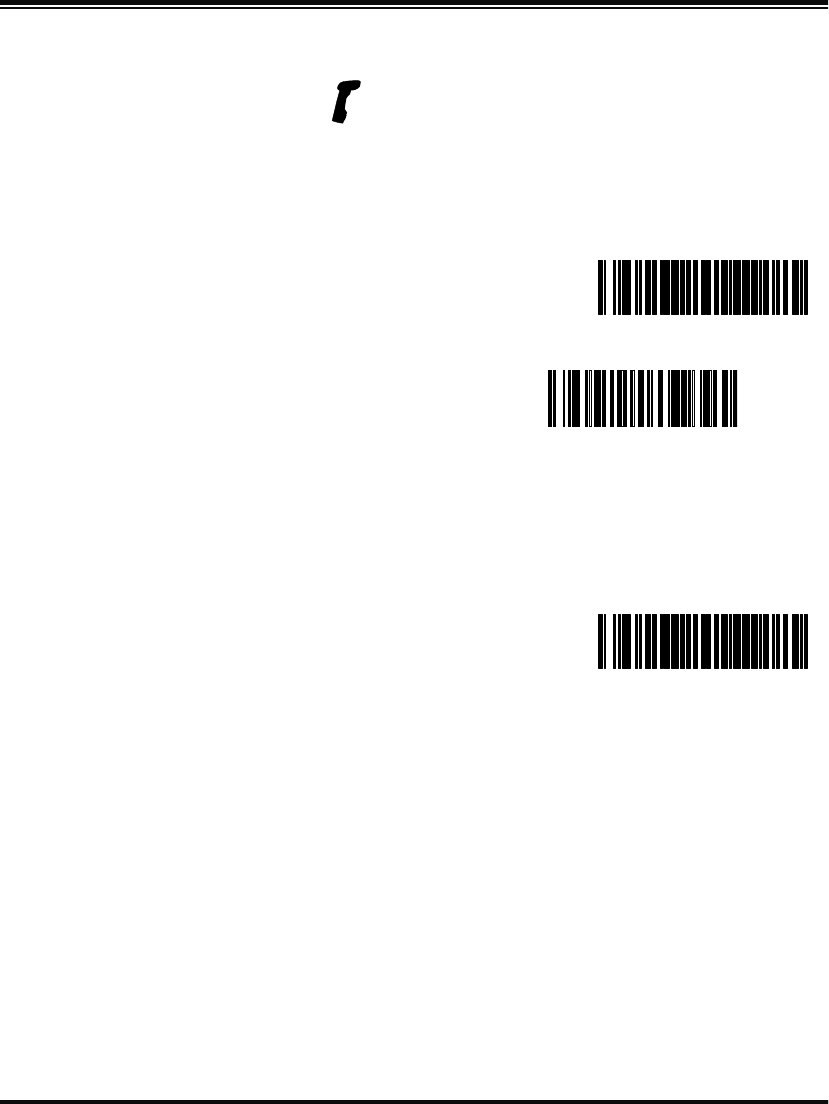
Systems Manual 49
RF Beep
Duration
The duration of time that an ACK beep is sounded is selectable using
this setting. RF beep duration can be set in increments of 10 ms (toler-
ance of +/- 10%) from 0 to 2.55 seconds.
Feature is specific to scanner ONLY
SET -------------------------------------------
Set RF Beep Duration ---------
Scan three digits representing the desired duration using the
Number Pad in Appendix B, padded with leading zeros (example:
008 = 80ms, 025 = 250ms, 100 = 1 second, etc.), then scan the
END bar code.
END ------------------------------------------
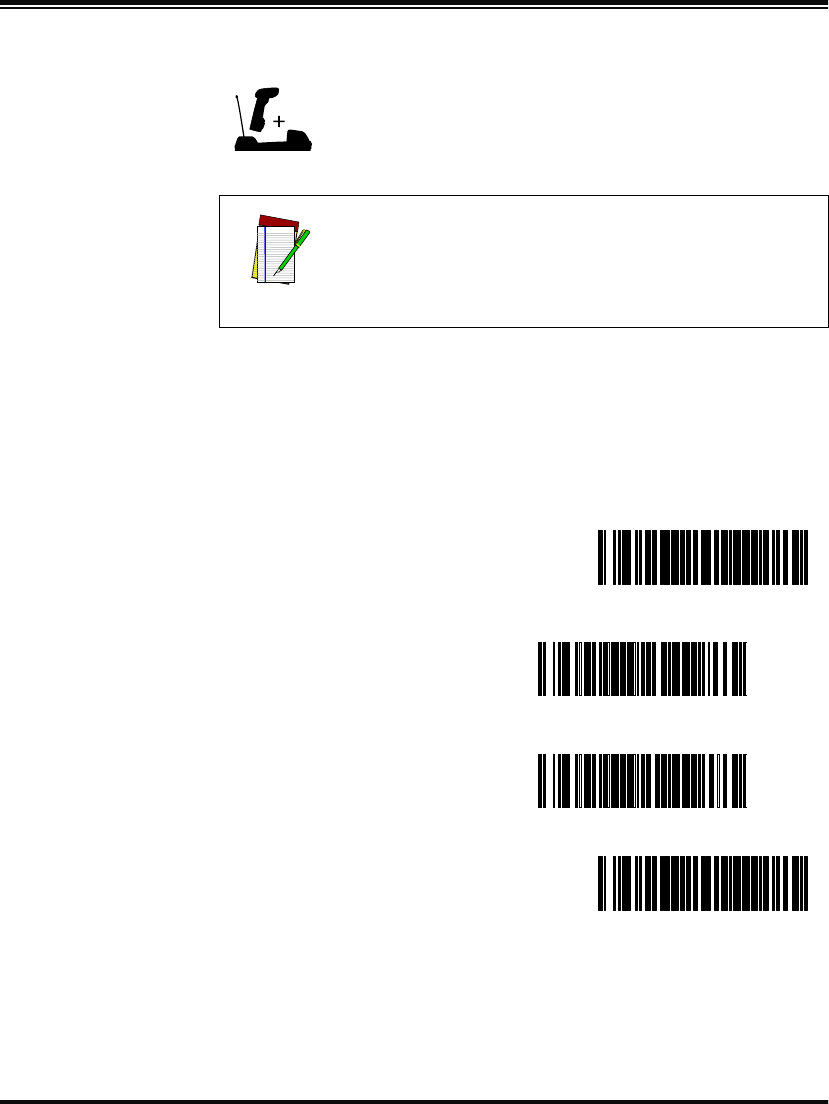
50 PowerScan™ RF Scanner
Radio Transmit
Power
The power level at which the radio signal is transmitted between the
devices is selectable to be either low or high. This setting allows adjust-
ment to a low setting to minimize potential radio interference caused
by communication between the devices, or provides a high setting to
increase the signal power which would enable clearer communication
over longer distances.
Feature is applicable to scanner and Base Station.
NOTE
Remember, programming changes to the Base Sta-
tion have no effect until the new configuration is
downloaded via the feature Transmit Scanner Con-
figuration to Base Station on page 33.
SET -------------------------------------------
Radio Transmit Power =
Low ---------
Radio Transmit Power =
High ---------
END ------------------------------------------
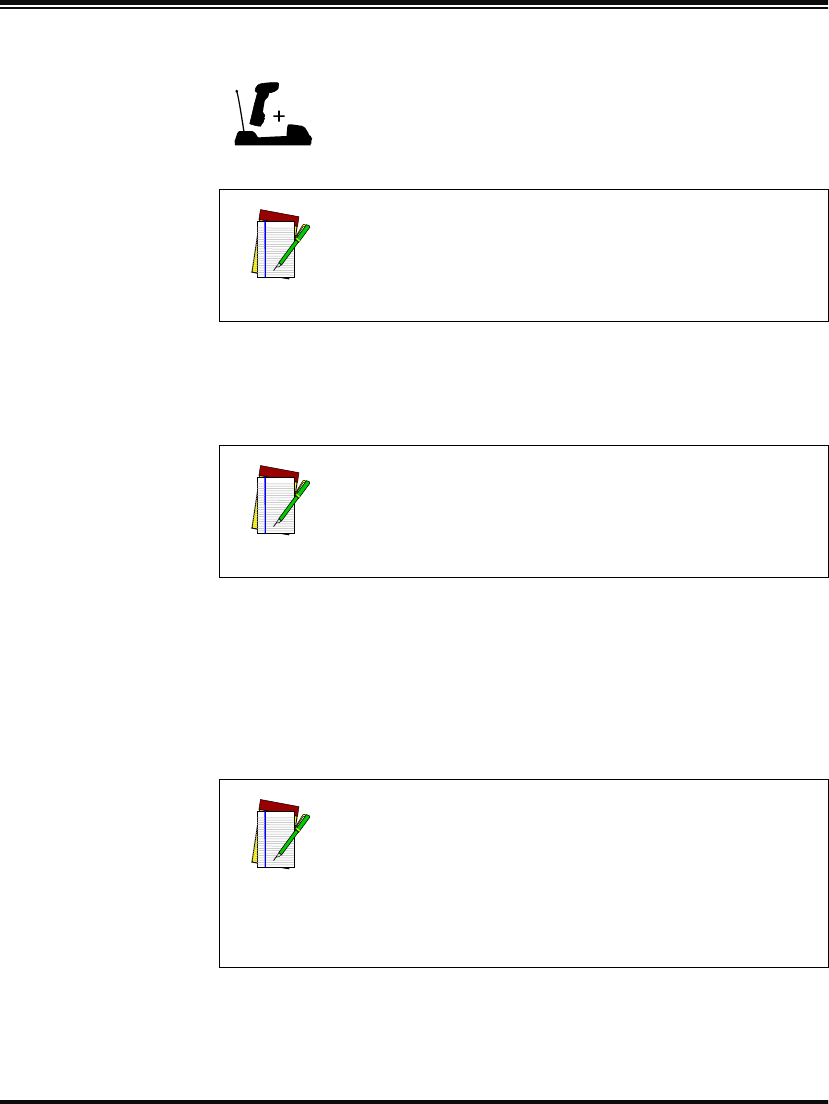
Systems Manual 51
RF Channel
Selection
Radio communications between the handheld scanner and its linked
Base Station can be carried over one of ten different allowable frequen-
cies (channels). Select alternate channels to improve communications
between devices in noisy RF environments.
When a new channel is selected, the scanner sends a change-of-channel
message to the Base Station. After the Base Station has acknowledged
receipt of the message, both the scanner and the Base Station switch
their radio channels to the new channel (reference LED and Beeper Indi-
cations for information regarding scanner and Base Station acknowl-
edgement signals at this point). All further communication is done on
the new channel.
Feature is applicable to scanner and Base Station.
NOTE
Channel selection bar codes are of the type C pro-
gramming sequence category (see Programming
Sequence on page 36), and do not require you to
scan accompanying SET or END bar codes.
NOTE
Available channel frequencies will vary according to
the country/model of the scanner.
NOTE
Any other scanner that happens to be linked to that
Base Station will be unable to communicate with
the Base Station until it has switched to the new
channel. To accomplish this, scan the Base ID label
with each scanner you desire to be linked to the
Base Station. This action will automatically set each
scanner to the correct new channel.
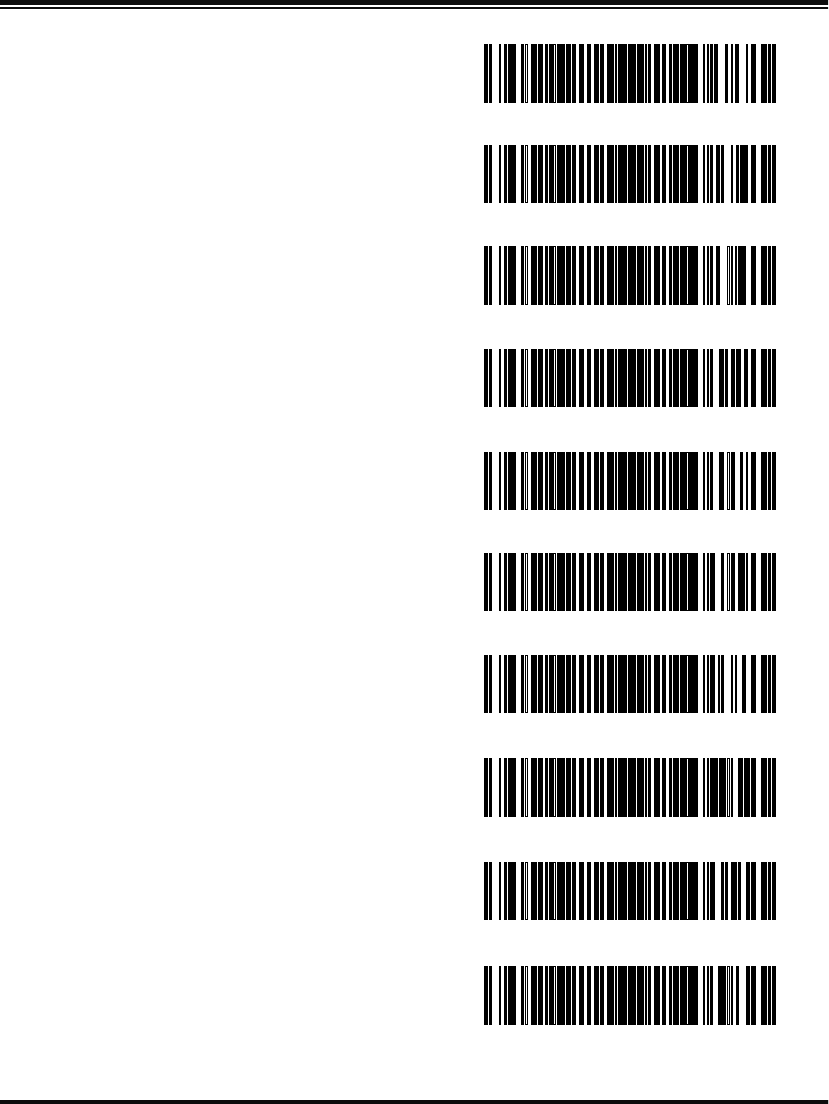
52 PowerScan™ RF Scanner
Select Radio
Channel 0 ---------
Select Radio
Channel 1 ---------
Select Radio
Channel 2 ---------
Select Radio
Channel 3 ---------
Select Radio
Channel 4 ---------
Select Radio
Channel 5 ---------
Select Radio
Channel 6 ---------
Select Radio
Channel 7 ---------
Select Radio
Channel 8 ---------
Select Radio
Channel 9 ---------
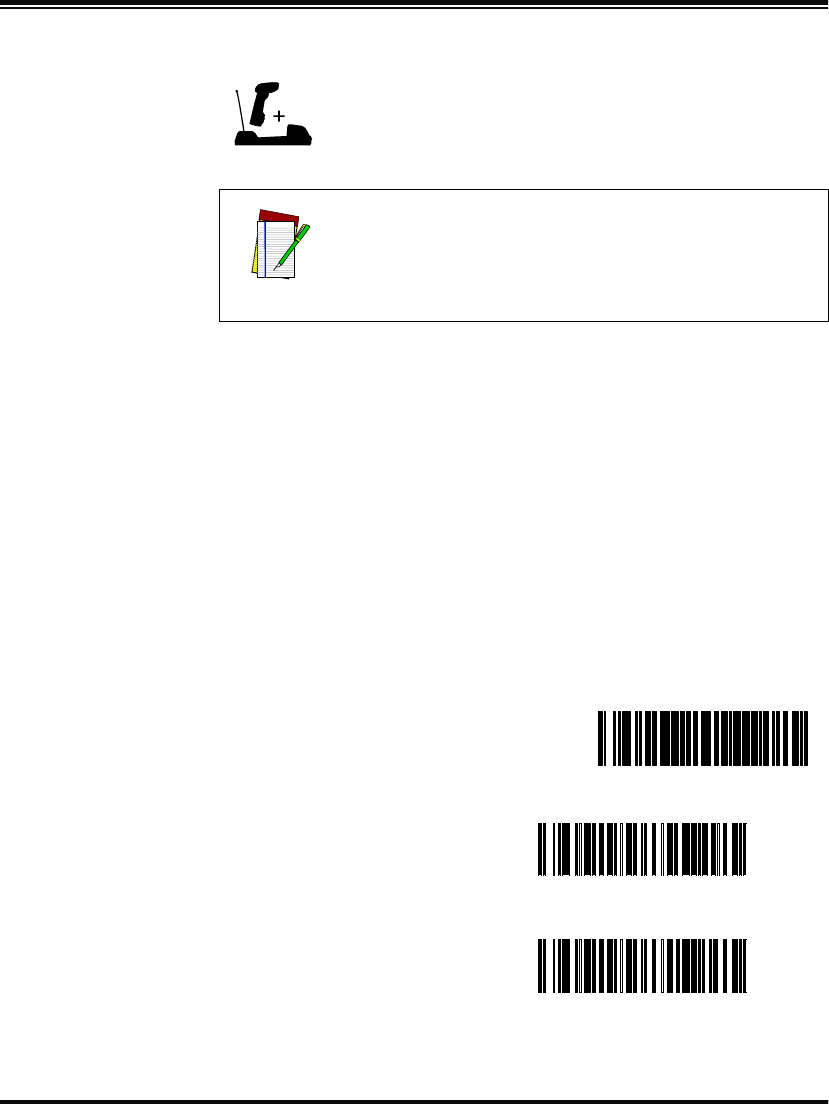
Systems Manual 53
Transmission
Retries Before
Message Time-
out
When the scanner attempts to transmit data to the Base Station, com-
munication may not always occur on the first try due to interference,
signals from other scanners in the queue, etc.. This setting defines the
number of transmission retries the scanner/Base Station will attempt
before the message gives up tryng to successfully resend/transmit the
message (times out). If the specified retry count is exceeded, the scan-
ner will sound a transmission error beep (when transmission error
beep is enabled).
In a noisy RF environment, a large number of retries may allow a trans-
mission to get through to the Base Station, but at the cost of increased
time-out (should the transmission fail). To maximize battery life, set
this feature to the lowest optimal number of retries.
Selectable range for this setting is 0-15 retries.
Feature is applicable to scanner and Base Station.
NOTE
Remember, programming changes to the Base Sta-
tion have no effect until the new configuration is
downloaded via the feature Transmit Scanner Con-
figuration to Base Station on page 33.
SET -------------------------------------------
0 Retries ---------
1 Retry ---------
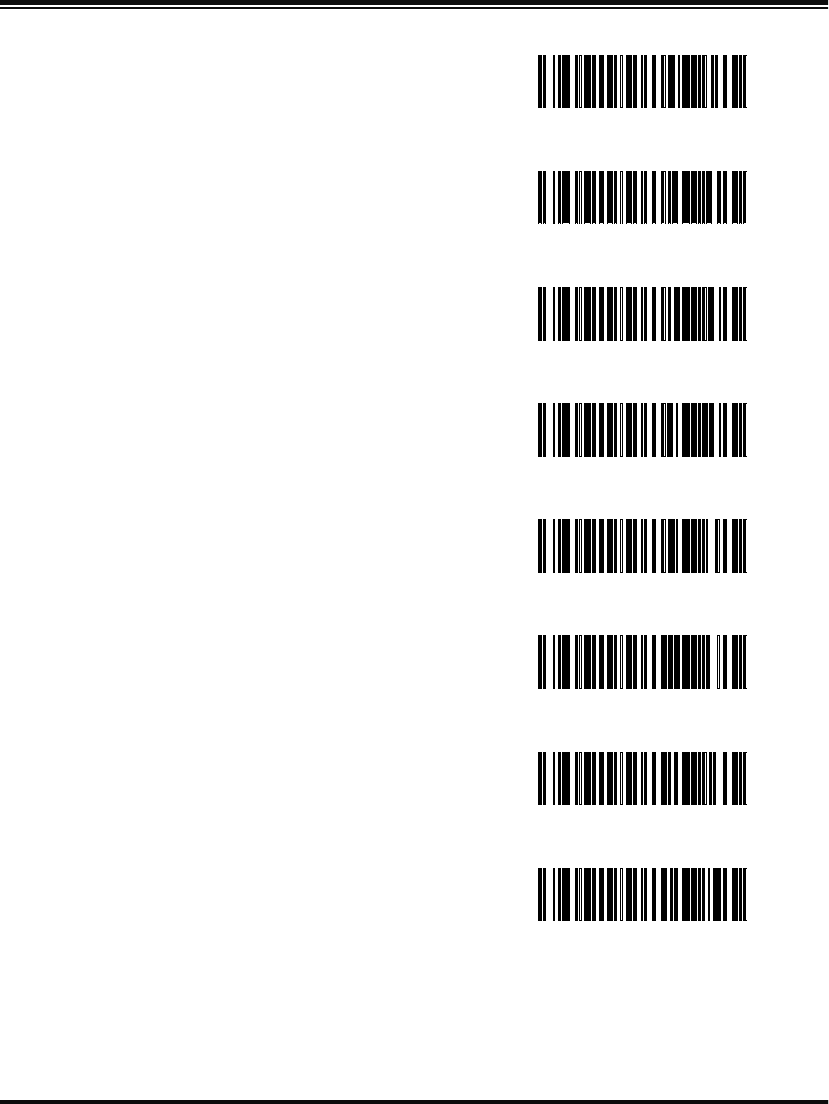
54 PowerScan™ RF Scanner
2 Retries ---------
3 Retries
(recommended) ---------
4 Retries ---------
5 Retries ---------
6 Retries ---------
7 Retries ---------
8 Retries ---------
9 Retries ---------
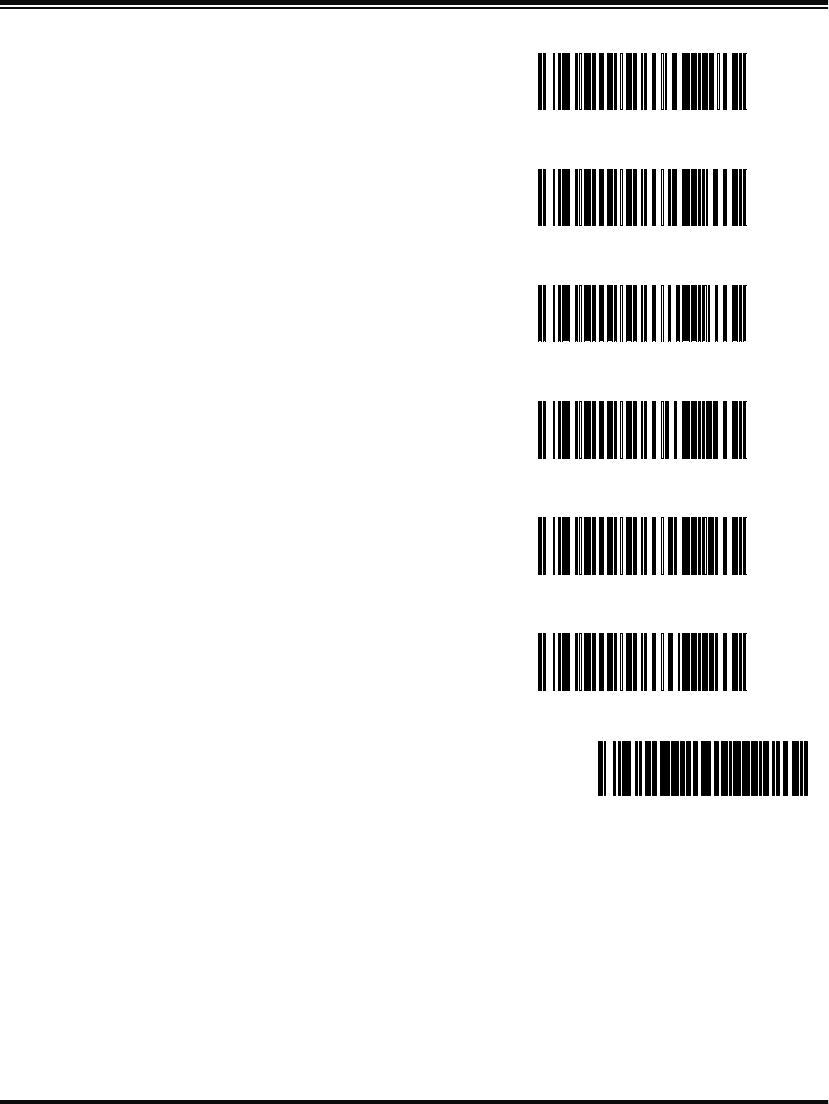
Systems Manual 55
10 Retries ---------
11 Retries ---------
12 Retries ---------
13 Retries ---------
14 Retries ---------
15 Retries ---------
END ------------------------------------------
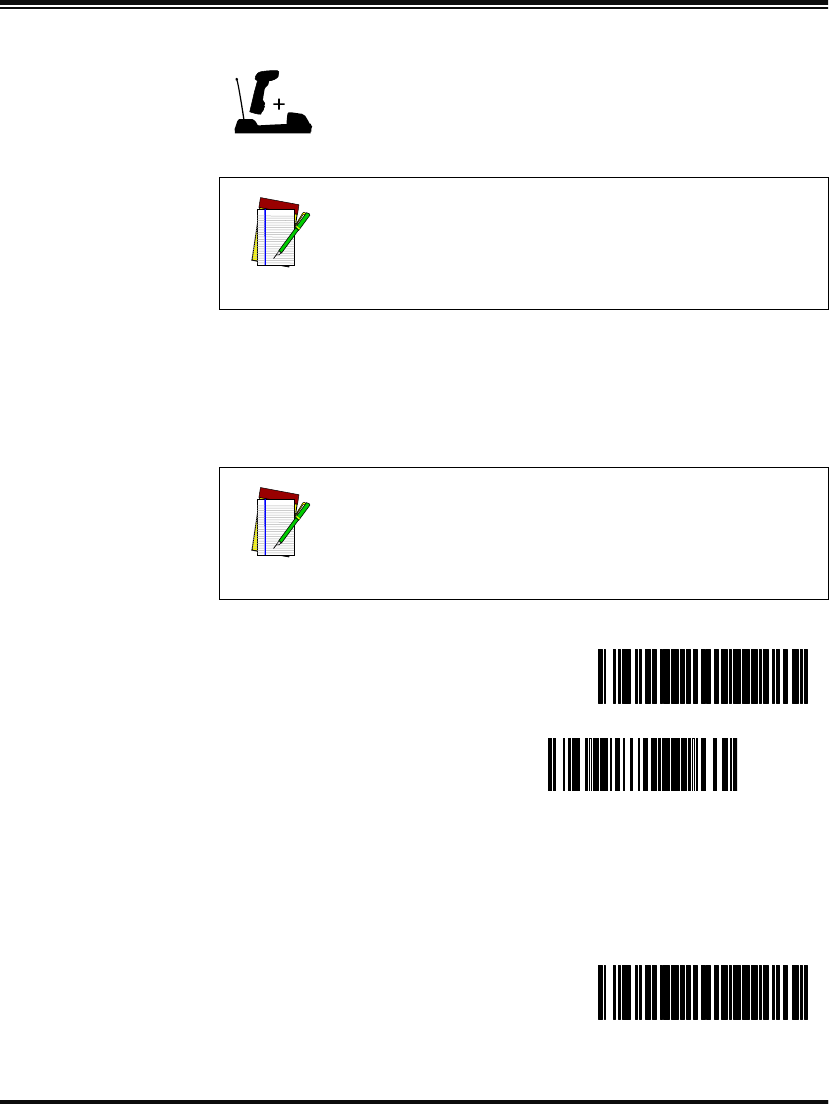
56 PowerScan™ RF Scanner
Wait Time for
ACK
This setting defines a time period allowed once the scanner has sent
data to the Base Station for that Base Station to send an acknowledge-
ment (ACK) back to the scanner, signalling receipt of the data. This fea-
ture is used to streamline the scanning speed of your system.
The range for this delay is 0.08 - 2.55 seconds in 10ms increments.
Feature is applicable to scanner and Base Station.
NOTE
Remember, programming changes to the Base Sta-
tion have no effect until the new configuration is
downloaded via the feature Transmit Scanner Con-
figuration to Base Station on page 33.
NOTE
Selecting longer values for this feature will
decrease the battery life between charges.
SET -------------------------------------------
Set Wait Time for ACK ---------
Scan three digits representing the desired delay using the Num-
ber Pad in Appendix B. Be sure the number is padded with lead-
ing zeros (example: 008 = 80ms, 025 = 250ms, 100 = 1 second,
etc.), then scan the END bar code.
END ------------------------------------------
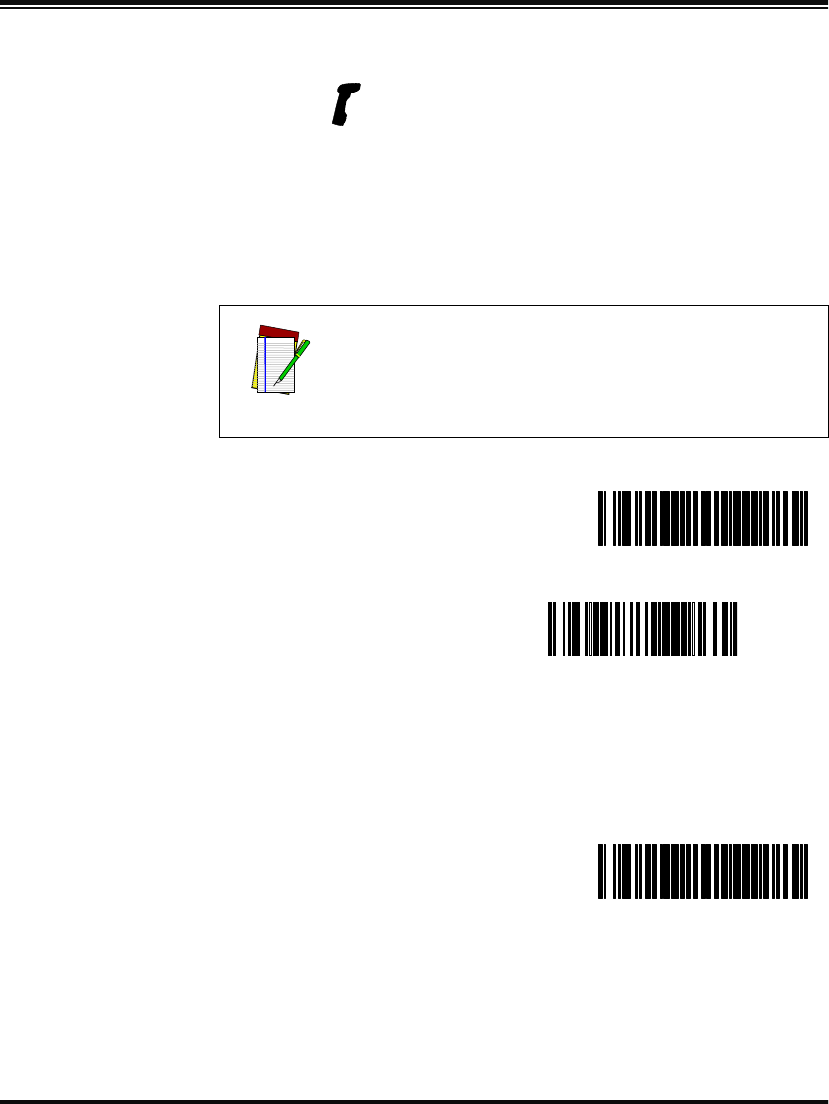
Systems Manual 57
Wait Time For
Scanner Power
Shutdown
To conserve battery life, the handheld scanner can be automatically
shut down when it has not been in use for a given period. A trigger
pull or other stimulus will then be required to reactivate the scanner.
The idle duration determines how long the scanner stays on/active
after each use. Range for this feature is a setting of 1 to 120 seconds in
one-second increments. A setting of one second is recommended.
Feature is specific to scanner ONLY
NOTE
Selecting higher values for this feature will effect
the length of battery life.
SET -------------------------------------------
Set Wait Time for Scanner
Power Shutdown ---------
Scan three digits representing the desired delay using the Num-
ber Pad in Appendix B. Be sure the number is padded with lead-
ing zeros (example: 001 = 1 second, 025 = 25 seconds, 100 = 100
seconds, etc.), then scan the END bar code.
END ------------------------------------------
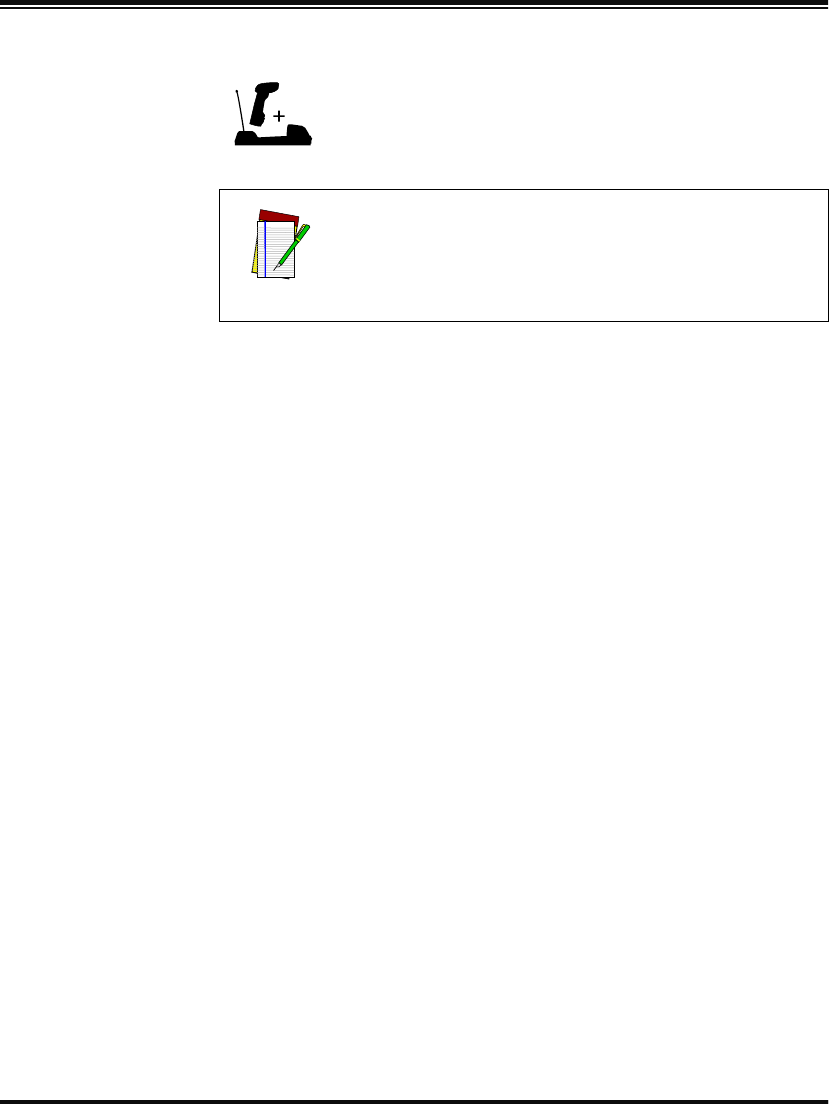
58 PowerScan™ RF Scanner
Wait Time
Between
Retries of
Failed
Transmission
In conjunction with the previous feature, TRANSMISSION RETRIES
BEFORE MESSAGE TIME-OUT, this feature defines the duration of
time the system must wait before re-trying a transmission of data
between the scanner and the Base Station. Consideration for this set-
ting would be to ensure that enough time elapses between tries to
avoid encountering the source of the original transmission conflict,
while being short enough to avoid causing a substantial increase in the
time required to successfully transmit the message.
Wait range can be set from 5ms to 255ms in one-millisecond incre-
ments, and is multiplied by the amount of retries selected via the fea-
ture, TRANSMISSION RETRIES BEFORE MESSAGE TIME-OUT
(TRBMTO) to determine the total duration. For example if this feature
(WAIT TIME BETWEEN RETRIES OF FAILED TRANSMISSION) is
selected to be 80 ms, and TRBMTO feature is selected to be 3, the result-
ing total duration between retries would be 80 x 3, or 240ms total.
Feature is applicable to scanner and Base Station.
NOTE
Remember, programming changes to the Base Sta-
tion have no effect until the new configuration is
downloaded via the feature Transmit Scanner Con-
figuration to Base Station on page 33.
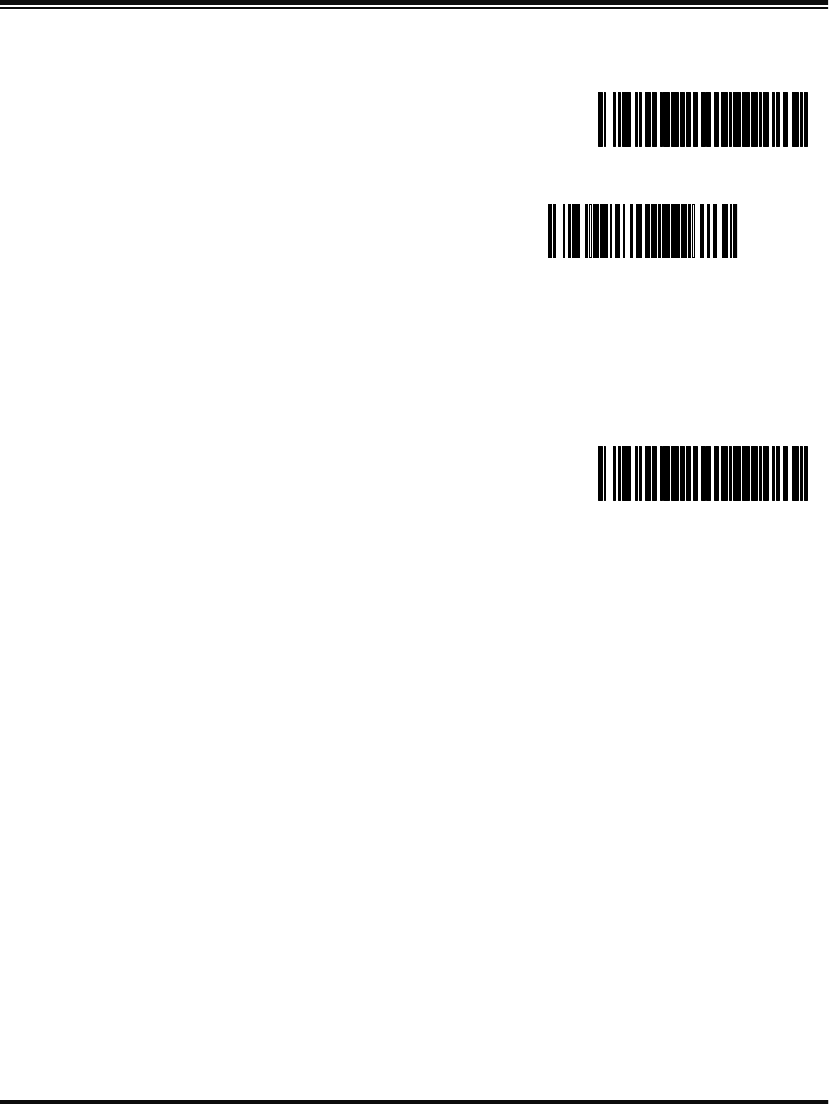
Systems Manual 59
SET -------------------------------------------
Set Wait Time Between Retries
of Failed Transmission ---------
Scan three digits representing the desired delay using the Num-
ber Pad in Appendix B. Be sure the number is padded with lead-
ing zeros (example: 005 = 5ms, 065 = 65ms, 250 = 250ms, etc.),
then scan the END bar code.
END ------------------------------------------
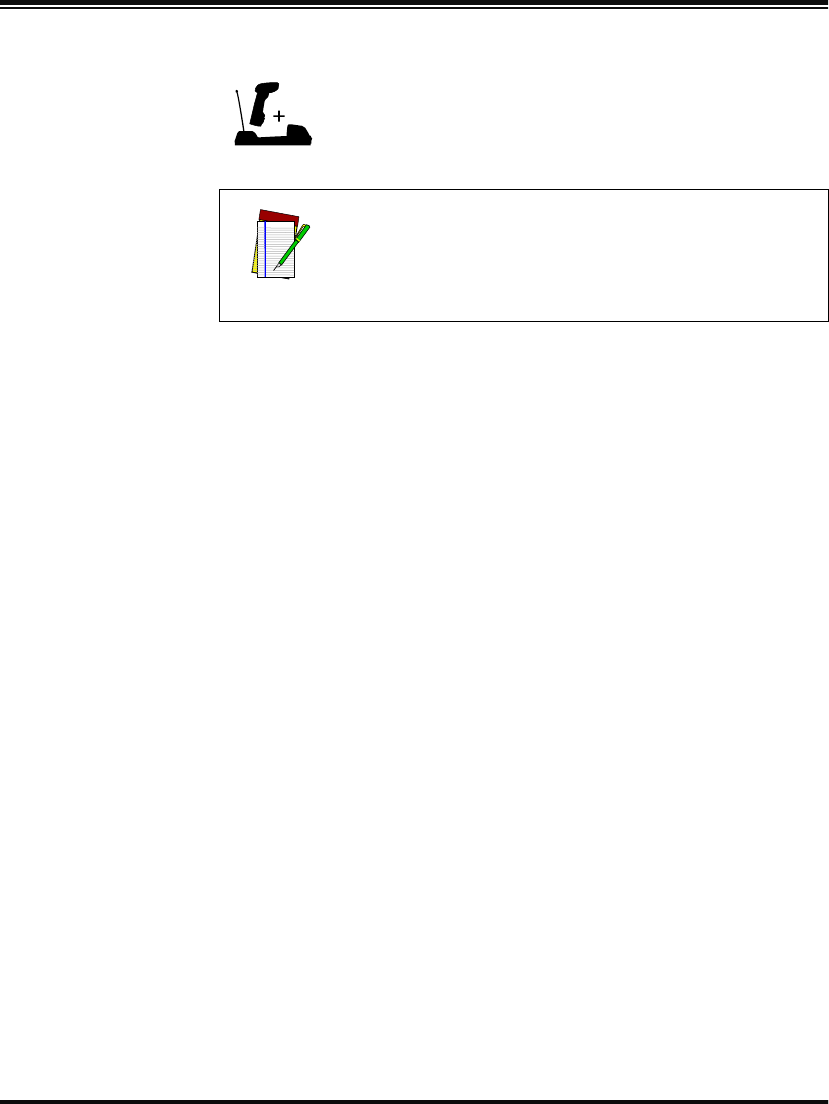
60 PowerScan™ RF Scanner
HACK Transmit
Options
A Host Acknowledgement (HACK) message is a signal sent to the
scanner via the Base Station indicating the host has received bar code
data previously transmitted by that scanner. This feature determines
when the Base Station should send the HACK to the scanner. Choices
are:
•Send HACK as soon as the Base Station receives the scanner’s
transmission. This option is recommended for installations
where multiple scanners are linked to one Base Station.
•Send HACK as soon as the Base Station completes transmis-
sion to the host. This option is recommended for installations
where only a single scanner is linked to one Base Station.
•Send HACK after the host transitions the CTS line from inac-
tive to activate (using CTS scan control). RS-232 ONLY.
•Send HACK after host returns ACK to Base Station. RS-232
with ACK/NAK turned on ONLY.
Feature is applicable to scanner and Base Station.
NOTE
Remember, programming changes to the Base Sta-
tion have no effect until the new configuration is
downloaded via the feature Transmit Scanner Con-
figuration to Base Station on page 33.
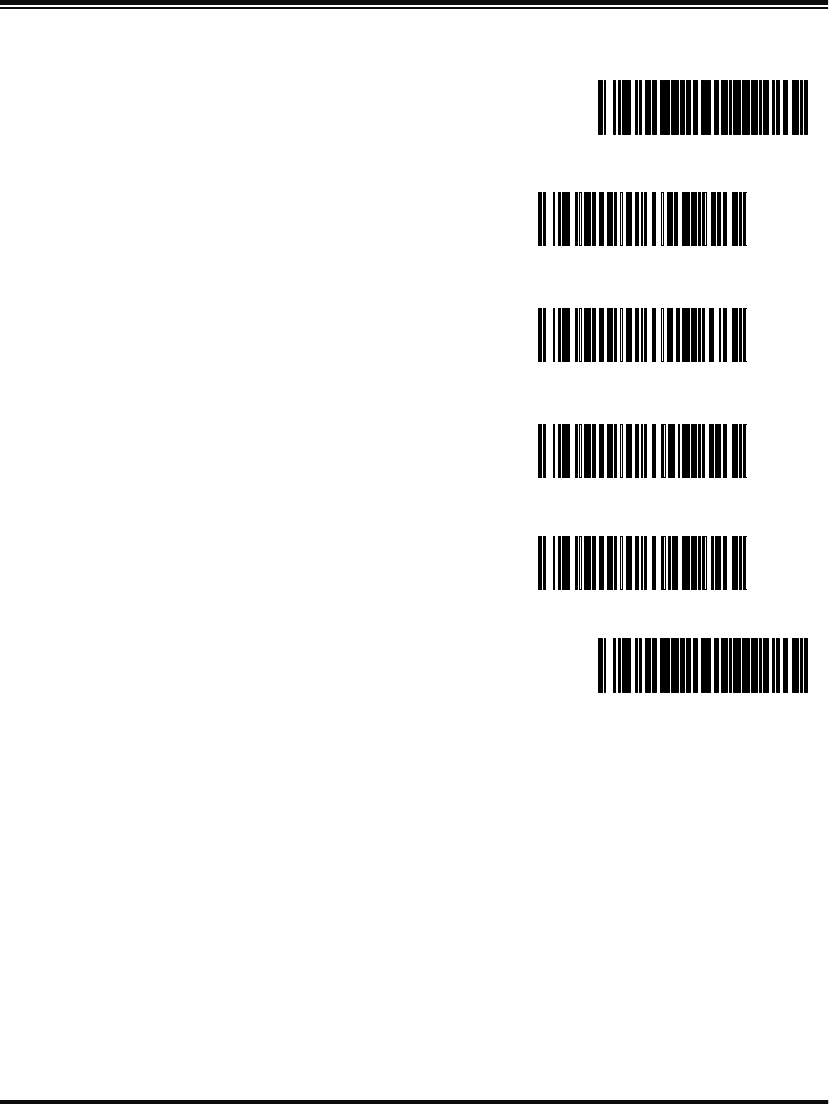
Systems Manual 61
SET -------------------------------------------
HACK upon receipt of scanner
transmission ---------
HACK upon Base Station
transmission to the host ---------
HACK after host transitions
CTS line (RS-232 ONLY) ---------
HACK after host returns ACK
(RS-232 ONLY) ---------
END ------------------------------------------
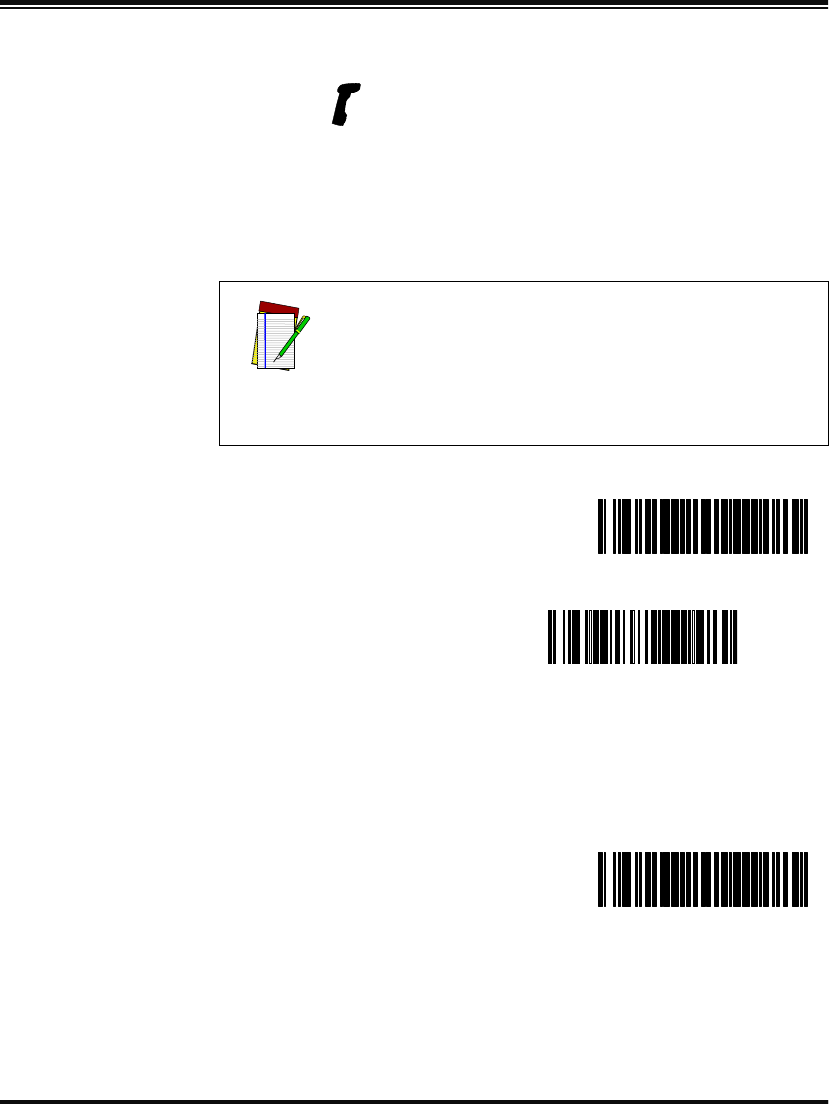
62 PowerScan™ RF Scanner
Wait Time For
HACK From
Host
This setting specifies the time the scanner must wait to receive a HACK
message back from the host before giving up and registering a trans-
mission error. Selectable range for this wait time is 20ms to 5.1 seconds
in 20ms increments. It is recommended that this value be set at no less
than one second.
Feature is specific to scanner ONLY
NOTE
Host turnaround (ACK) time is variable. This item
(HACK) should be set based on settings for the fea-
tures Wait Time for ACK and Transmission Retries
Before Message Time-out. For example if ACK is set
to one second and retries are set to three, HACK
should be set at three seconds.
SET -------------------------------------------
Set Wait Time For
HACK ---------
Scan three digits representing the desired delay using the Num-
ber Pad in Appendix B. Be sure the number is padded with lead-
ing zeros (example: 001 = 20ms, 100 = 1 second, 255 = 5.1
seconds, etc.), then scan the END bar code.
END ------------------------------------------
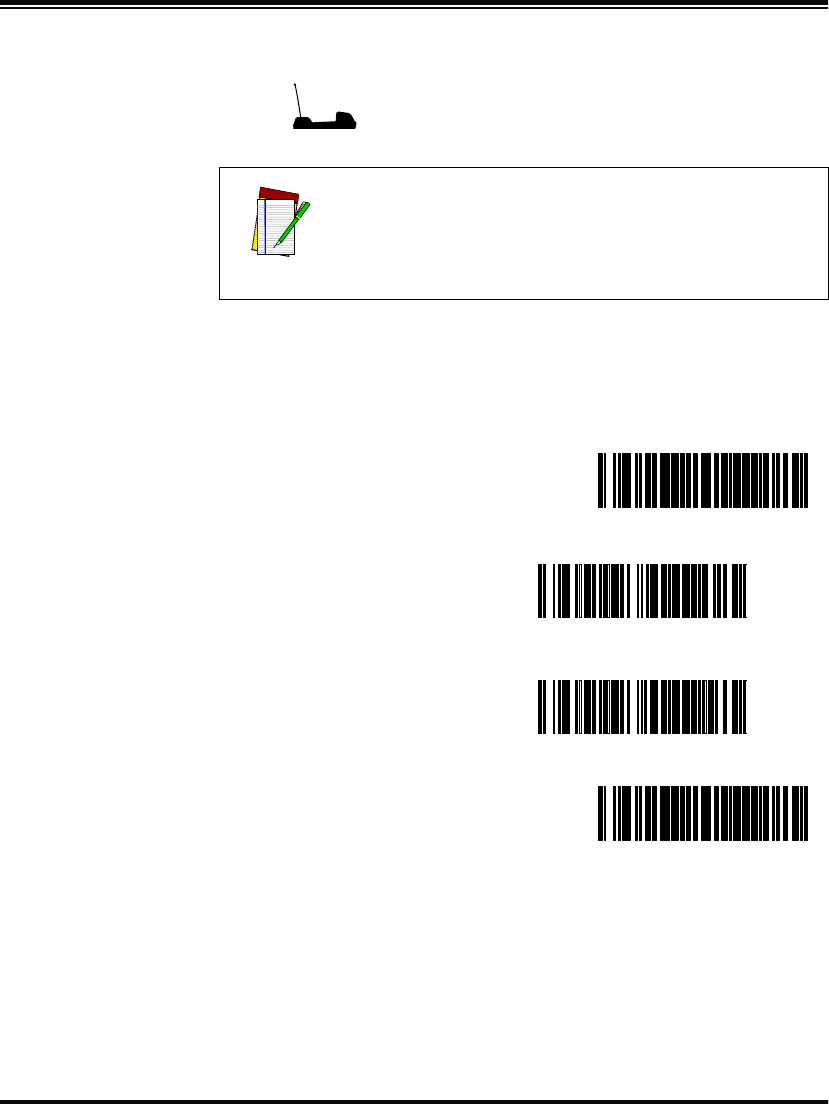
Systems Manual 63
Drop Links on
Reset Option
When enabled, this option causes the Base Station to drop its links to
any and all scanners whenever power is reset/cycled. This provides a
simple way to ensure that when reconfiguring a system, scanners do
not need to be located and individually unlinked.
Feature is specific to Base Station ONLY
NOTE
Remember, programming changes to the Base Sta-
tion have no effect until the new configuration is
downloaded via the feature Transmit Scanner Con-
figuration to Base Station on page 33.
SET -------------------------------------------
Drop all links on reset
(ENABLE) ---------
Do not drop all links on reset
(DISABLE) ---------
END ------------------------------------------
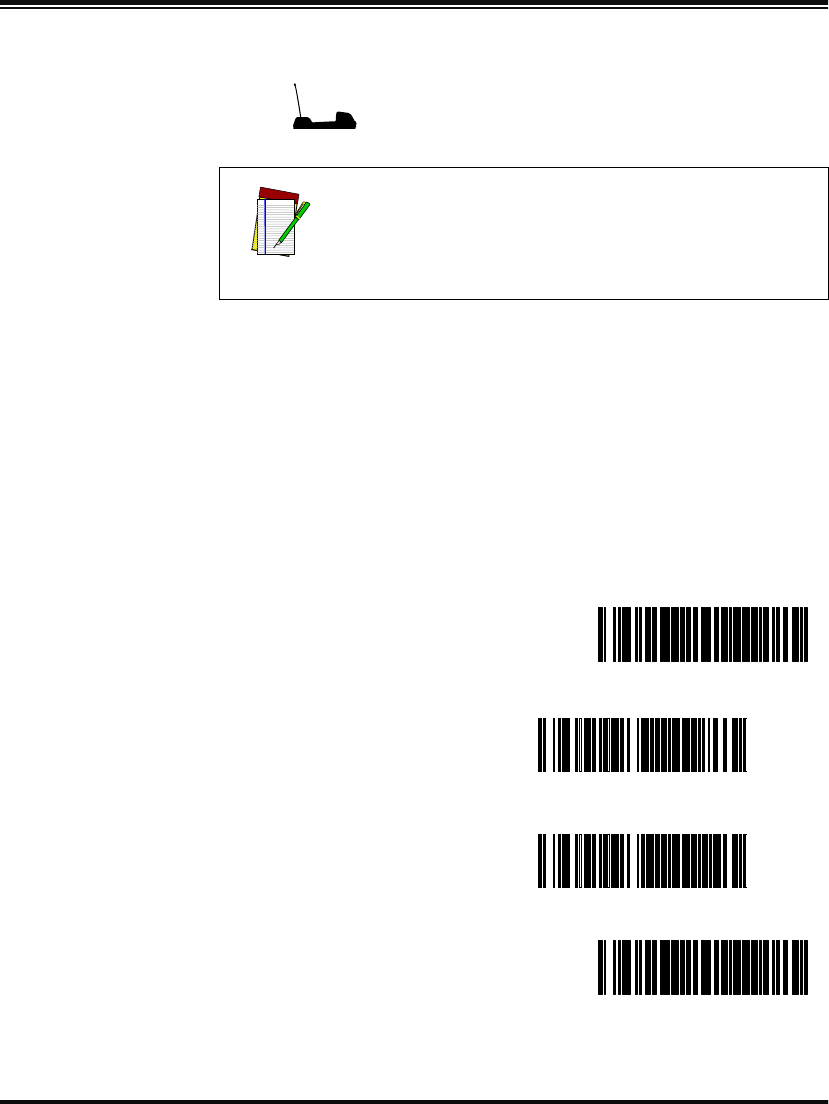
64 PowerScan™ RF Scanner
Drop Oldest
Links Option
This feature can be enabled to better manage the linking of new scan-
ners to a multi-point system. Here’s how it works: When a new scanner
is linked to a Base Station that is already linked to its maximum
amount of scanners, an earlier-linked scanner that has been inactive for
the longest period of time will be automatically unlinked from the sys-
tem to make room for the new scanner.
When this feature is disabled, scanners can be linked up to the maxi-
mum number set via the programming feature, Set Maximum Linked
Scanners, or the default maximum, which is eight scanners. Attempts to
link additional scanners beyond these limits will fail.
Feature is specific to Base Station ONLY
NOTE
Remember, programming changes to the Base Sta-
tion have no effect until the new configuration is
downloaded via the feature Transmit Scanner Con-
figuration to Base Station on page 33.
SET -------------------------------------------
Drop oldest links
(ENABLE) ---------
Do not drop oldest links
(DISABLE) ---------
END ------------------------------------------
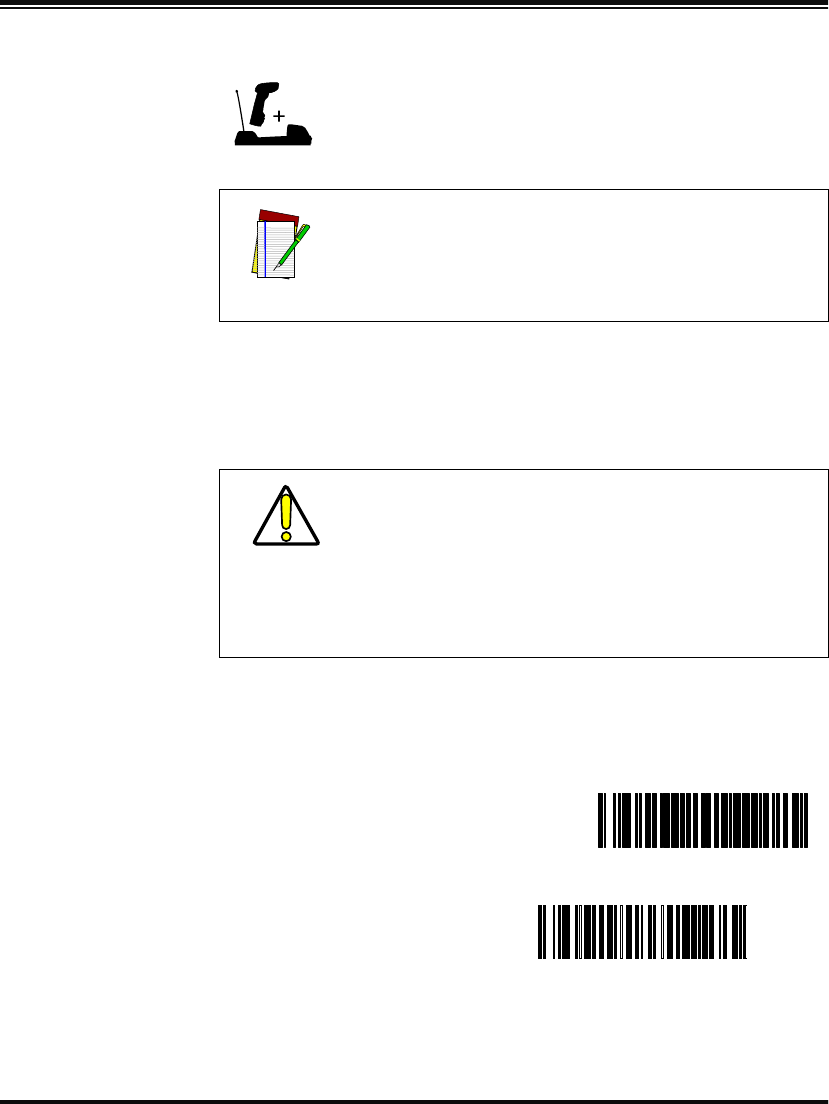
Systems Manual 65
Common
Configuration
When this option is enabled, the Base Station attempts to share its con-
figuration with a scanner as that scanner links to the Base Station. If,
during linking, a scanner’s configuration file does not match the Base
Station’s current settings, the Base Station attempts to transmit to the
scanner and overwrite the configuration file with its own.
If the need is to share the scanner’s configuration files to the Base Sta-
tion, use the Transmit Scanner Configuration to Base Station bar code.
Base Station on page 33.
Feature is applicable to scanner and Base Station.
NOTE
Remember, programming changes to the Base Sta-
tion have no effect until the new configuration is
downloaded via the feature Transmit Scanner Con-
figuration to Base Station on page 33.
CAUTION
Since a new/replacement scanner may have been
shipped with a custom configuration or may have
been modified with other special programming, it
may not be desirable to download a potentially
older configuration from an existing Base Station.
In this case, consider uploading the scanner’s
newer configuration to the Base Station instead.
SET -------------------------------------------
ENABLE Common
Configuration ---------
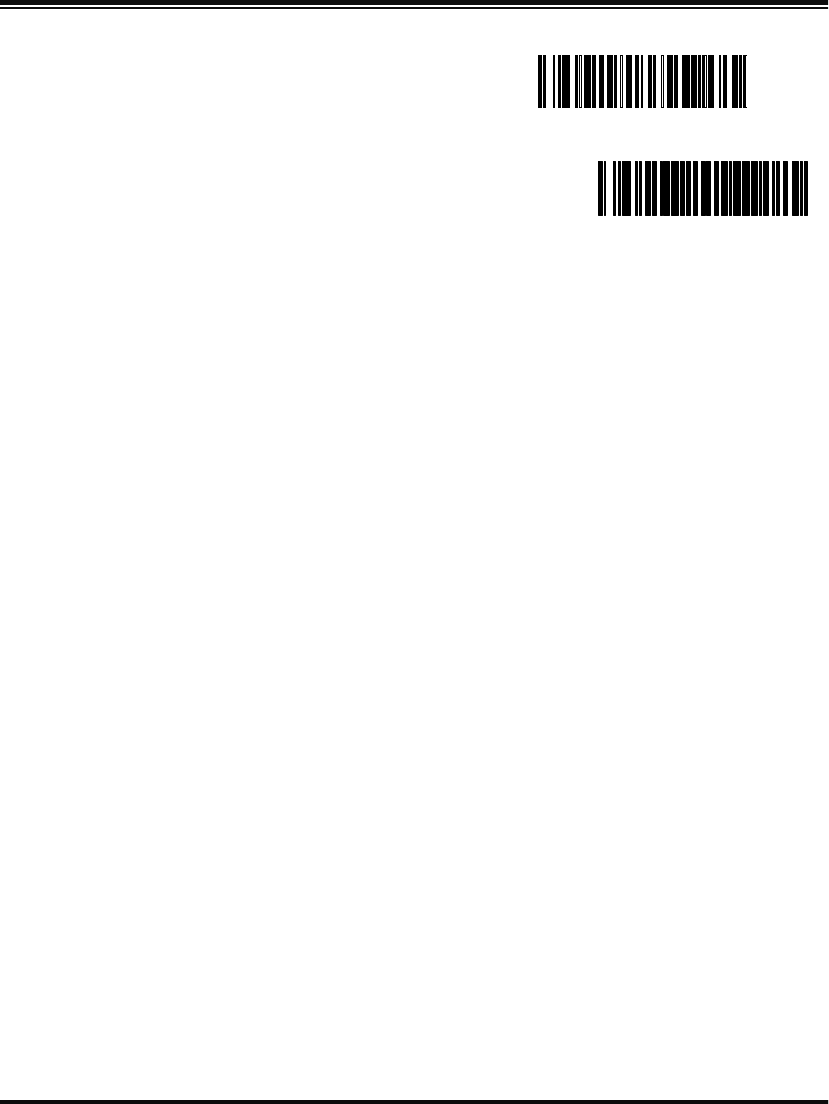
66 PowerScan™ RF Scanner
DISABLE Common
Configuration ---------
END ------------------------------------------
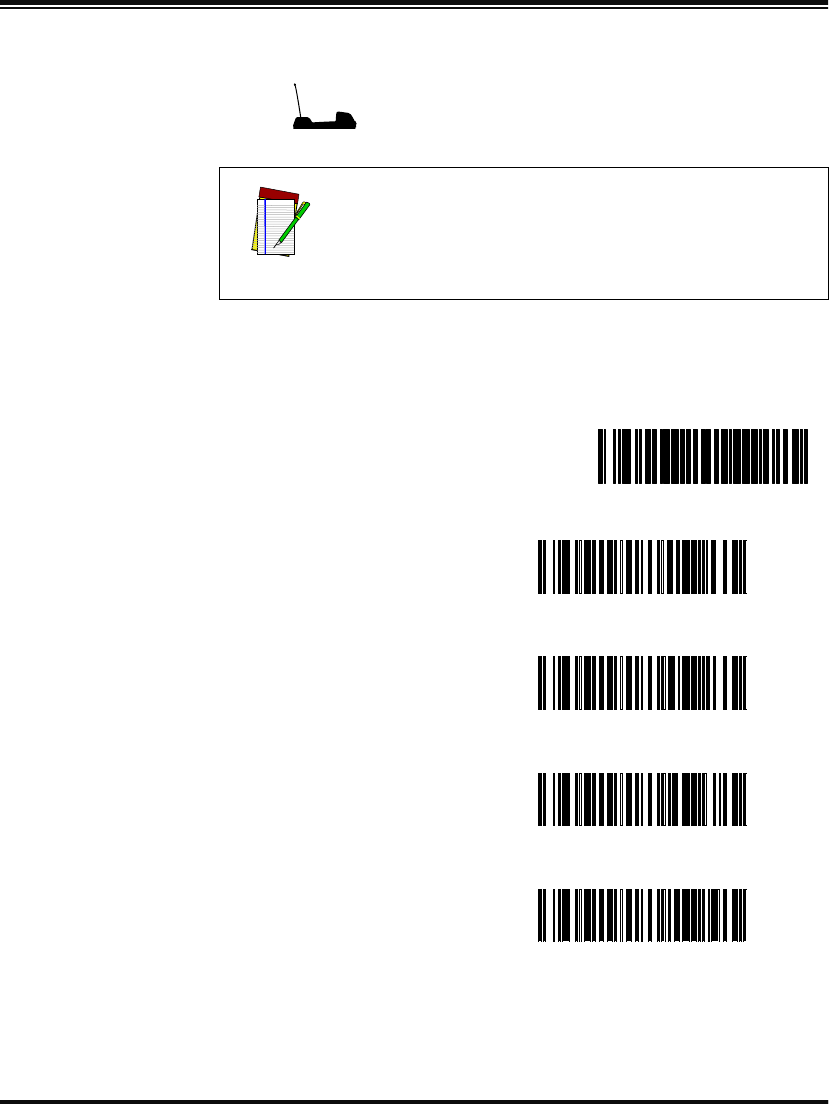
Systems Manual 67
Set Maximum
Linked
Scanners
By default, as many as eight scanners can be linked to one Base Station.
This feature allows you to further limit allowable linked scanners. Des-
ignate a number of scanners that can link from one to eight.
Feature is specific to Base Station ONLY
NOTE
Remember, programming changes to the Base Sta-
tion have no effect until the new configuration is
downloaded via the feature Transmit Scanner Con-
figuration to Base Station on page 33.
SET -------------------------------------------
Maximum Linked
Scanners = 1 ---------
Maximum Linked
Scanners = 2 ---------
Maximum Linked
Scanners = 3 ---------
Maximum Linked
Scanners = 4 ---------
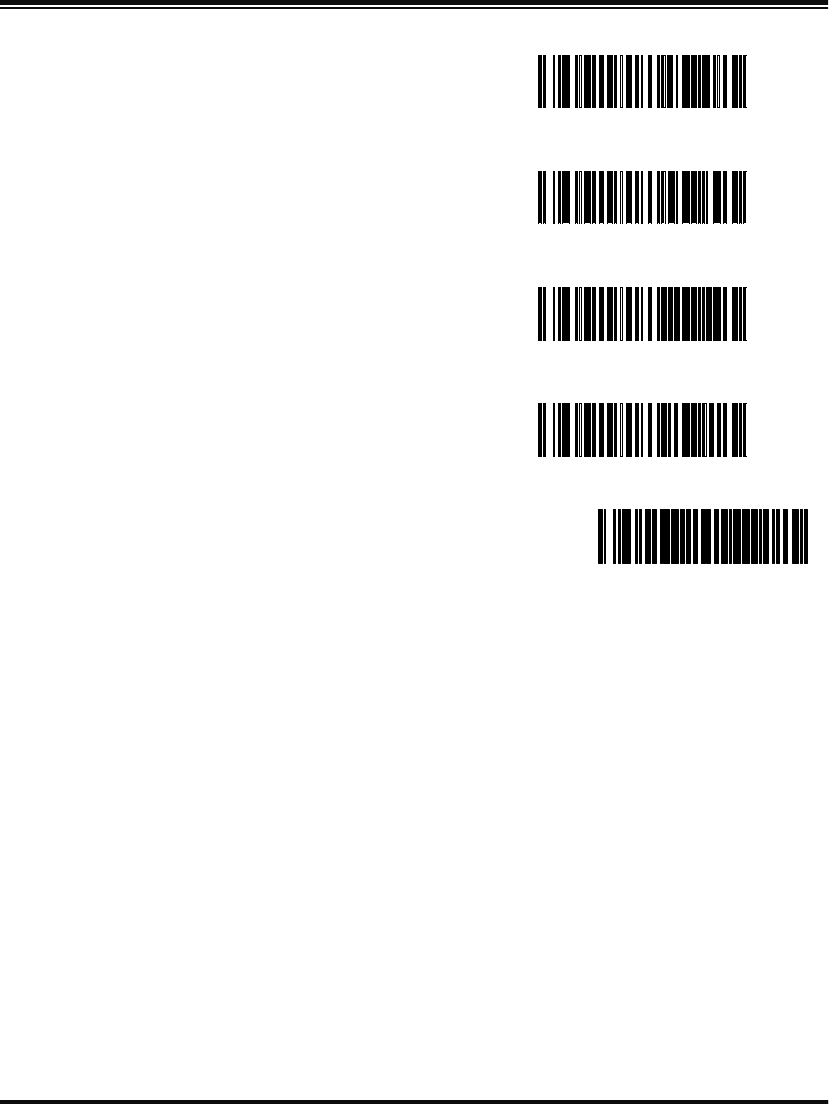
68 PowerScan™ RF Scanner
Maximum Linked
Scanners = 5 ---------
Maximum Linked
Scanners = 6 ---------
Maximum Linked
Scanners = 7 ---------
Maximum Linked
Scanners = 8 ---------
END ------------------------------------------
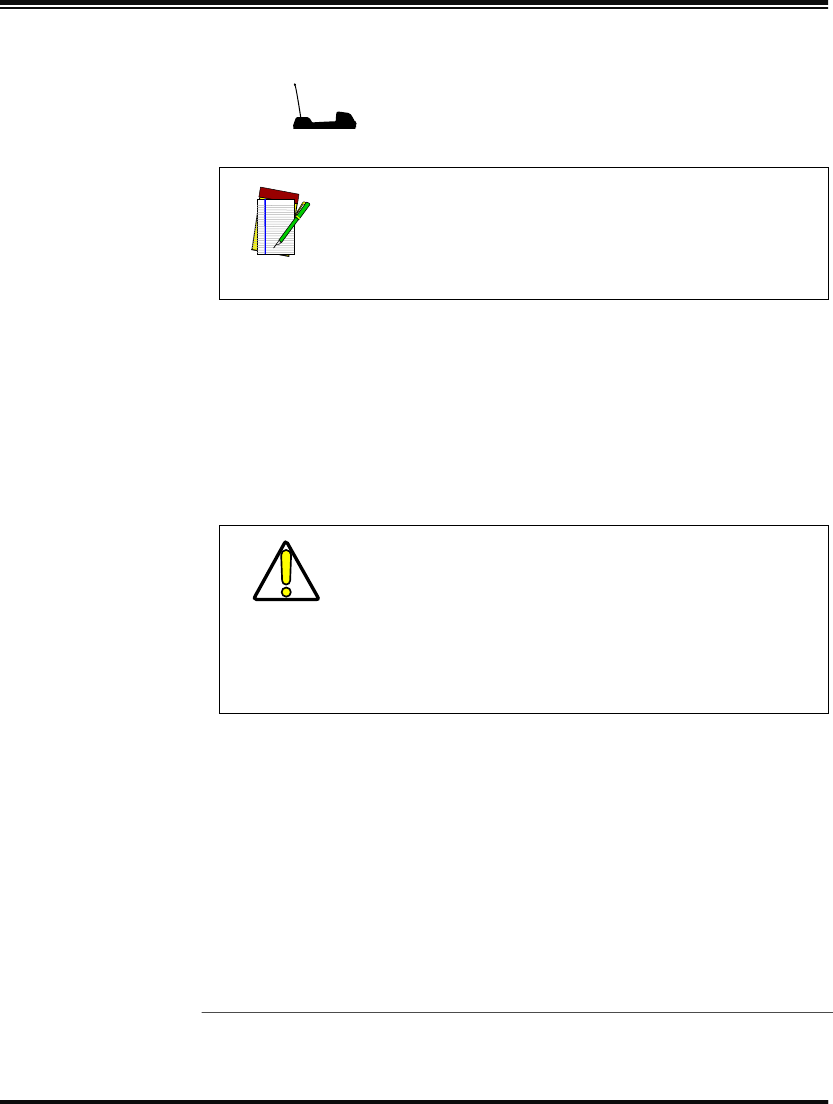
Systems Manual 69
Source-Radio
Identification
(ID)
This feature allows you to include source-radio identification1 (repre-
sented by six ASCII bytes) along with bar code data transmitted to the
host. Enable this feature to identify the individual scanner sending a
given data transmission. Options for this feature are:
•Do not include source-radio ID
•Include source-radio ID as prefix
•Include source-radio ID as suffix
Feature is specific to Base Station ONLY
NOTE
Remember, programming changes to the Base Sta-
tion have no effect until the new configuration is
downloaded via the feature Transmit Scanner Con-
figuration to Base Station on page 33.
1. Each scanner has been pre-configured at the factory with its own unique six-character identifica-
tion (source-radio ID).
CAUTION
When included as a prefix or suffix, the source-
radio ID is displayed immediately adjacent to the
bar code data. If an additional prefix or suffix is
included (e.g., other global prefix or suffixes are
included), any source-radio ID prefix or suffix
remains adjacent to (and is considered part of) the
bar code data.
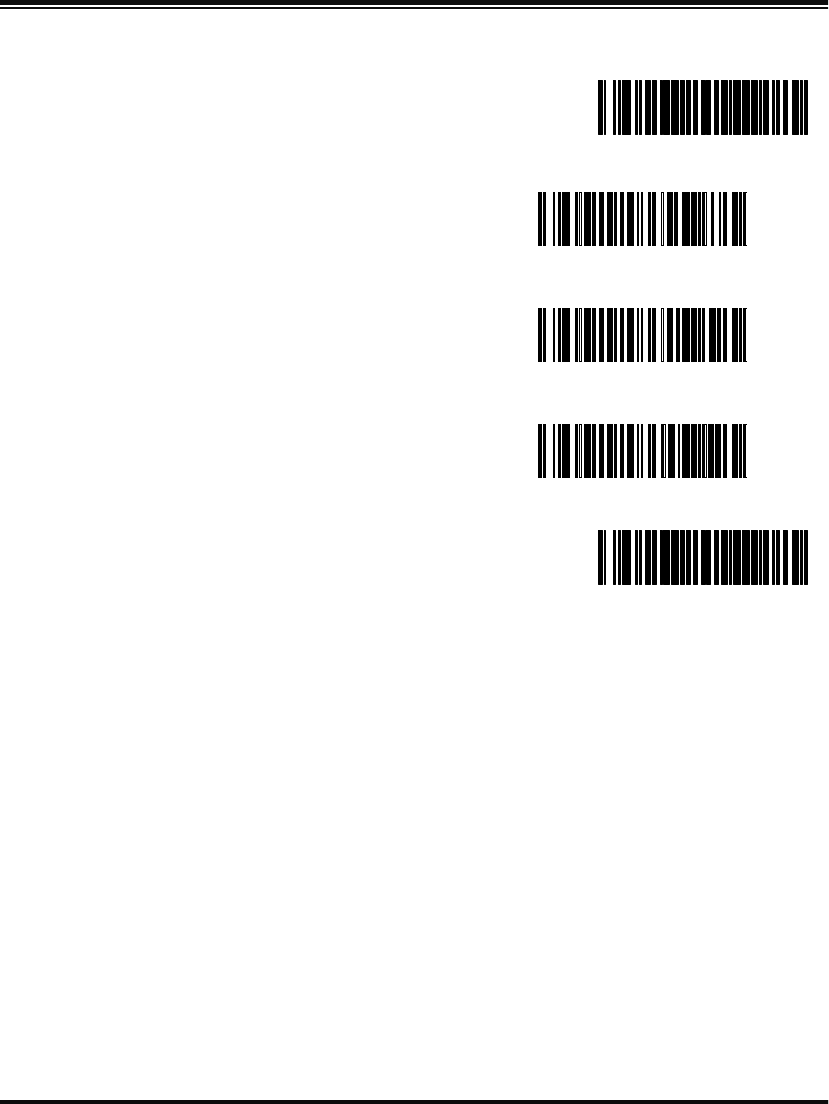
70 PowerScan™ RF Scanner
SET -------------------------------------------
Do not include source-
radio ID ---------
Include source-radio as
prefix ---------
Include source-radio as
suffix ---------
END ------------------------------------------
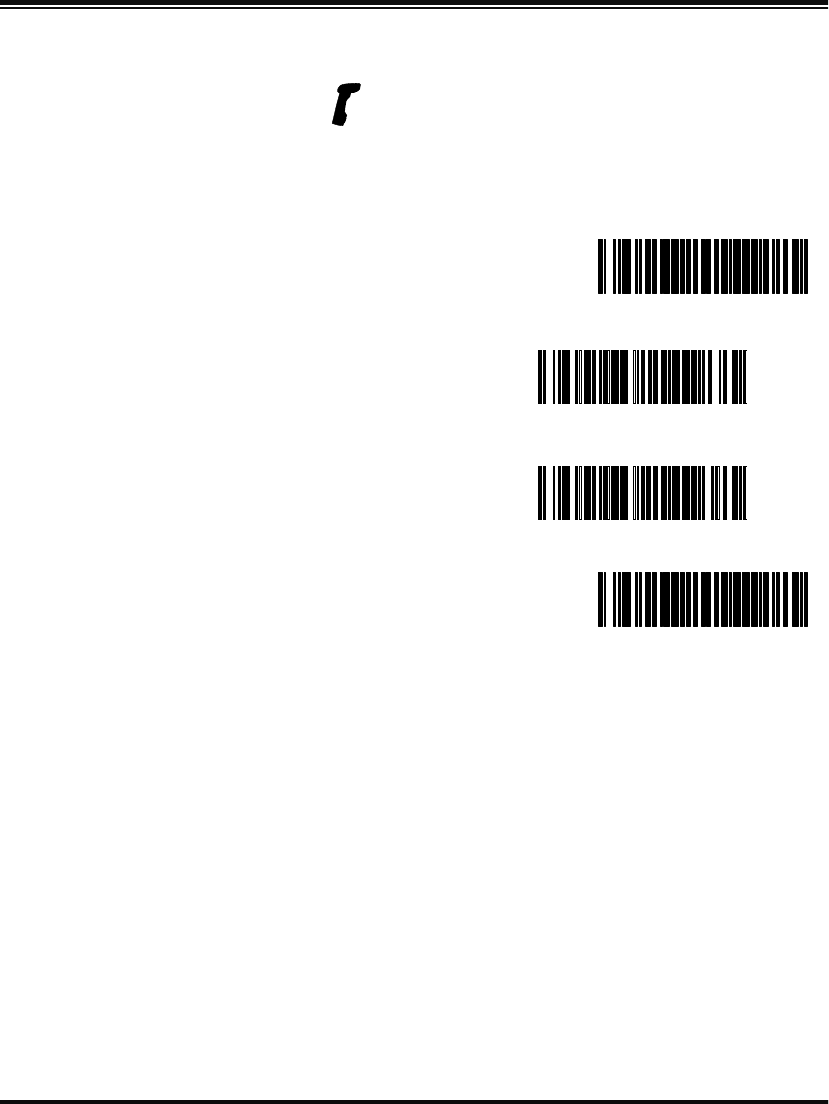
Systems Manual 71
Low Battery
LED Indication
If this feature is enabled and the battery power in the scanner is low,
the scanner’s green LED flashes twice every time the trigger is pulled.
Feature is specific to scanner ONLY
SET -------------------------------------------
ENABLE Low Battery LED
Indication ---------
DISABLE Low Battery LED
Indication ---------
END ------------------------------------------
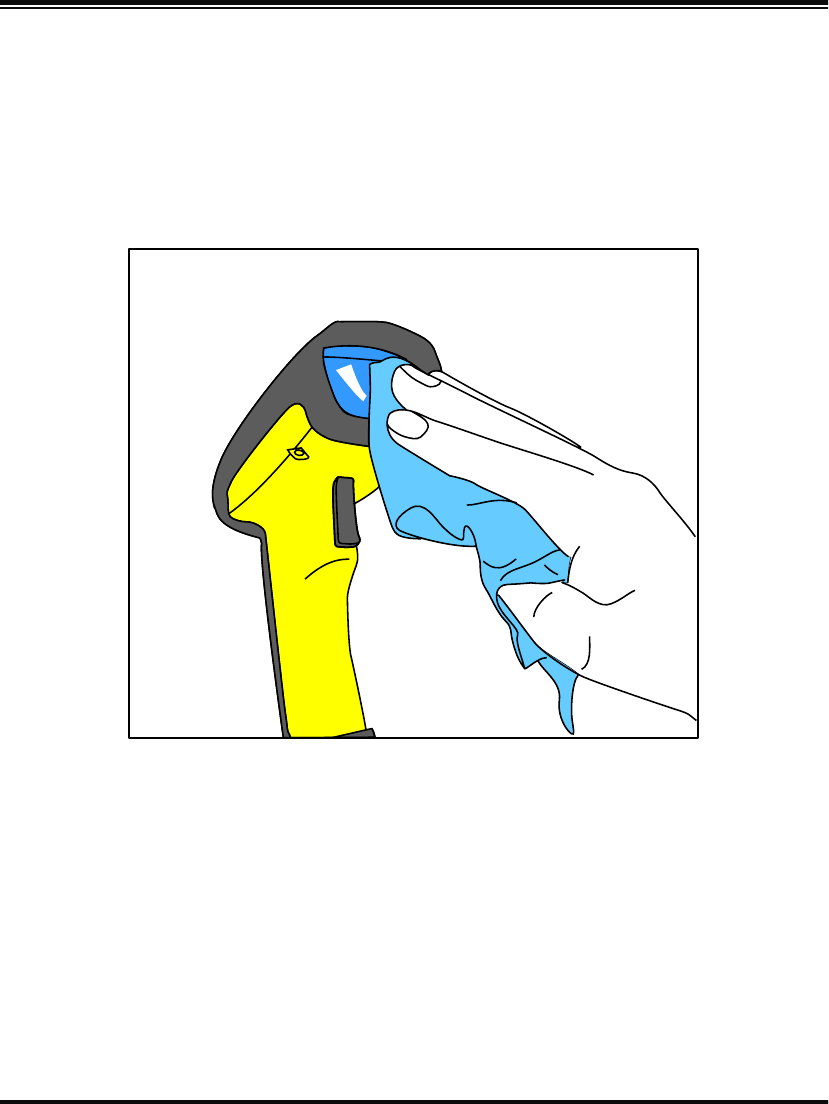
72 PowerScan™ RF Scanner
Maintenance and Troubleshooting
Scanner
Maintenance
The scan window will require occasional cleaning to remove smudges,
dust and other debris. To ensure optimal performance, clean the Scan
Window using a soft cloth or lens tissue dampened with isopropyl
alcohol (or equivalent). See Figure 17. The scanner body can also be
cleaned using this method.
Figure 17. Cleaning the Scan Window
Base Station
Maintenance
The Base Station requires no routine maintenance. If the antenna
becomes damaged, a kit is available for its replacement. Use only PSC
replacement antenna kits, since use of other antennas can adversely
affect performance. Repair or replacement of other items such as charg-
ing contact pins, internal components, etc. must be performed by an
authorized repair center.
Four Station
Charger
Maintenance
Four Station Charger battery contact replacement kits are available. See
the section, References, for information about attaining replacement kits.

Systems Manual 73
Troubleshooting
Troubleshoot your RF scanning system by performing the following
checks:
For the RF system, ensure that...
•the battery is charged. See Battery Charging and Maintenance on
page 12.
•the battery is properly installed. See Installing the Battery on
page 7.
•the scanner is linked to the desired Base Station. See Linking the
Scanner to a Base Station on page 10.
•the scanner is within reasonable operating range of the Base
Station, with no major obstructions between the radio units
such as thick walls or heavy machinery. (At the time of this
writing, maximum line-of-sight range is specified at 100 feet.)
•there is no local signal interference with other radio-operated
equipment. Consult RF Channel Selection on page 51 concern-
ing selection of alternate channels.
•the Base Station is powered-on. You can verify the Base Sta-
tion’s AC Adapter by using a known-good AC Adapter.
•the Base Station interface cable is securely attached to the host.
Consult your technical support manager or refer to your host
system manual to identify the proper cable connection for the
scanner. If necessary, verify interface cable function by using a
known-good interface cable.
If the problem is specific to scanning, verify that...
•the bar codes you are trying to scan are of satisfactory quality.
Bar code label verifiers are available from your dealer if you
need precise reporting of label details. Bar codes that are dam-
aged (wrinkled, smudged, or torn) may cause the scanner to
read poorly or not at all. If bar code quality seems to be the
problem, check to see if the scanner will read a barcode from
Appendix A.
•the programmable setting for advanced Quadralogic™ decod-
ing is set optimally for your system. (See Enhanced Scanning for
Hard-to-Read Bar Codes on page 20.)
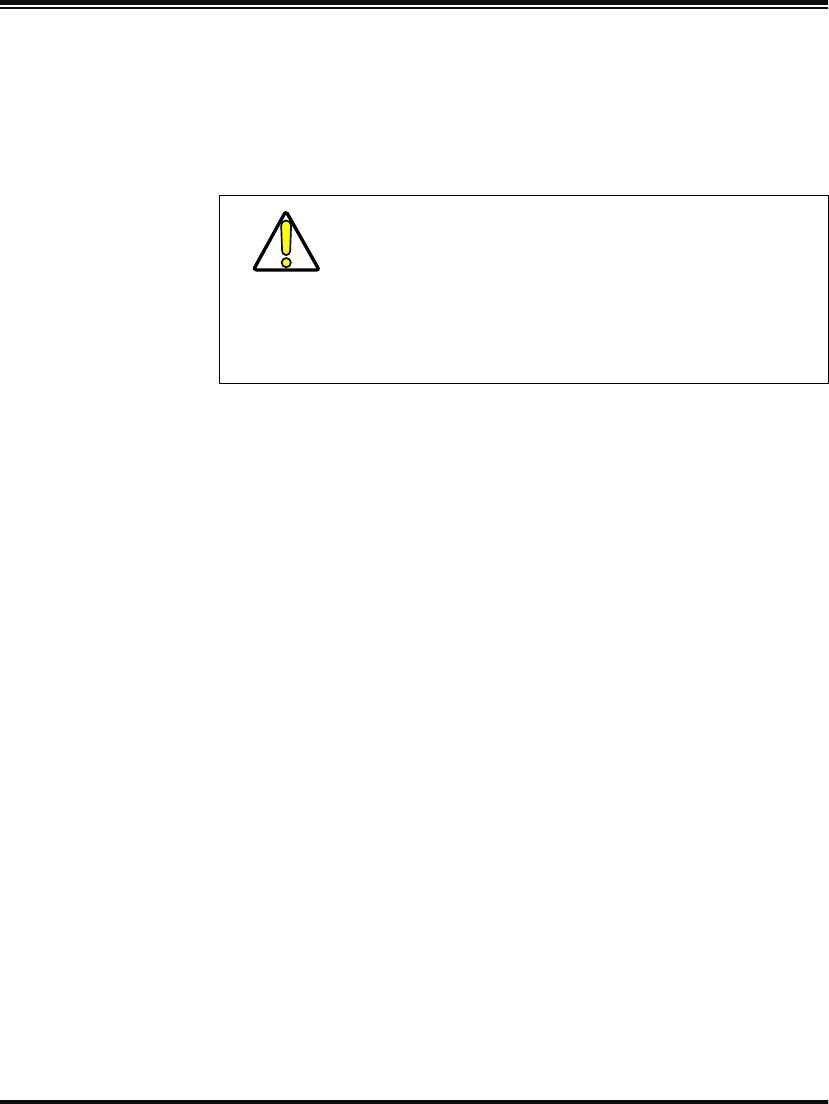
74 PowerScan™ RF Scanner
If the Scanner
Fails to Link
with the Base
Station
Here are reasons why your scanner may not be linked with the Base
Station:
•There may be too many scanners attempting a link with the
same Base Station. A maximum of eight scanners may link
with one Base Station at a given time. Reference the section, Set
Maximum Linked Scanners for more information..
•Links may be dropped by the Base Station if it has been reset
(power cycled). It may be necessary to relink all scanners upon
system reset. See also, Drop Links on Reset Option.
CAUTION
The limit imposed for linked scanners is selectable
to either: 1) disallow any new, additional scanner to
be linked beyond the set limit (this is the default), or
2) drop the link with the scanner least recently used.
Be aware that in linking additional scanners to a
single Base Station, you may inadvertently unlink
another scanner from the Base Station.

Systems Manual 75
NOTES

76 PowerScan™ RF Scanner
NOTES

Systems Manual 77
NOTES

78 PowerScan™ RF Scanner
Standard Warranty
PSC warrants to Customer that PSC’s products will be free from defects in materials and workmanship for a
period of two years from product shipment.
In order to obtain service under this Warranty, Customer must notify PSC of the claimed defect before the
expiration of the Warranty period and obtain from PSC a return authorization number for return of the product
to designated PSC service center. If PSC determines Customer’s claim is valid, PSC will repair or replace
product without additional charge for parts and labor. Customer shall be responsible for packaging and
shipping the product to the designated PSC service center, with shipping charges prepaid. PSC shall pay for
the return of the product to Customer if the shipment is to a location within the country in which the PSC
service center is located. Customer shall be responsible for paying all shipping charges, duties, taxes, and
any other charges for products returned to any other locations.
Warranty is subject to the limitations and exclusions set forth below. Warranty set forth above is in lieu of any
other warranties, expressed or implied, including merchantability and fitness.
Exclusions
Warranty coverage shall not apply to any claimed defect, failure or damage which PSC determines was
caused by: improper use of product; failure to provide product maintenance, including but not limited to
cleaning of the scan windows in accordance with product manual; installation or service of product by other
than PSC representatives; use of product with any other instrument, equipment or apparatus; modification or
alteration of product. External cables and replacement of scan windows due to scratching, stains or other
degradation will not be covered under the Warranty. Products returned for service must be accompanied by
the original external power supplies for performance of service.
Limitations of Liability
PSC repair or replacement of defective product as set forth above is the customer's sole and exclusive
remedy on account of claims of breach of warranty or product defect. Under no circumstances will PSC be
liable to customer or any third party for any lost profits, or any incidental, consequential indirect, special or
contingent damages regardless of whether PSC had advance notice of the possibility of such damages.
Assignment
Customer may not assign or otherwise transfer its rights or obligations under Warranty except to a purchaser
or transferee of product. No attempted assignment or transfer in violation of this provision shall be valid or
binding upon PSC.
Risk of Loss
Customer shall bear risk of loss or damage for product in transit to PSC. PSC shall assume risk of loss or
damage for product in PSC’s possession or product being returned to Customer by PSC, except such loss or
damage as may be caused by the negligence of Customer, its agents or employees. In the absence of
specific written instructions for the return of product to Customer, PSC will select the carrier, but PSC shall
not thereby assume any liability in connection with the return shipment.
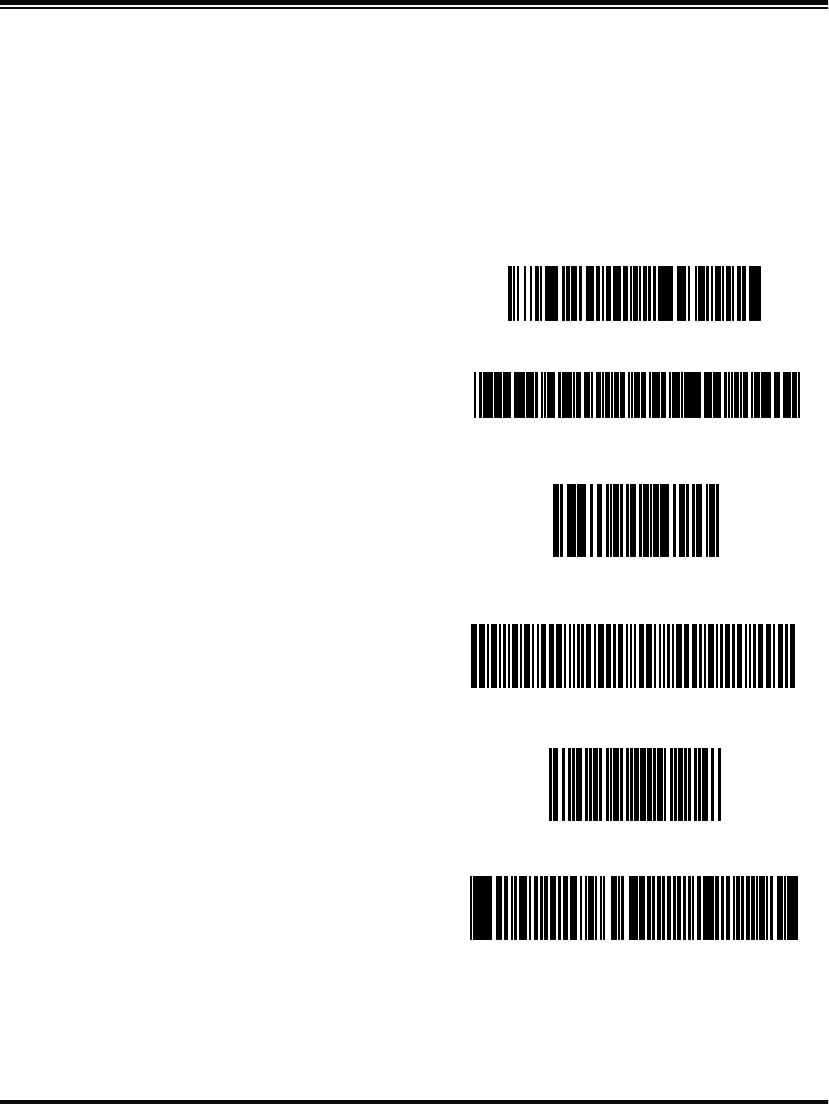
Systems Manual A-1
Appendix A
Sample Bar Codes
Use these test bar codes to check the scanner’s ability to read the vari-
ous symbologies represented.
Code 128
Code 39
Interleaved 2 of 5
Standard 2 of 5
Codabar
Code 93
Code 128 . Tes t
CODE 3 9 . TE ST
0123456789
1 2 3 4 5 6 7 8 9 0
A$99 . 95A
Code 93 . Tes t
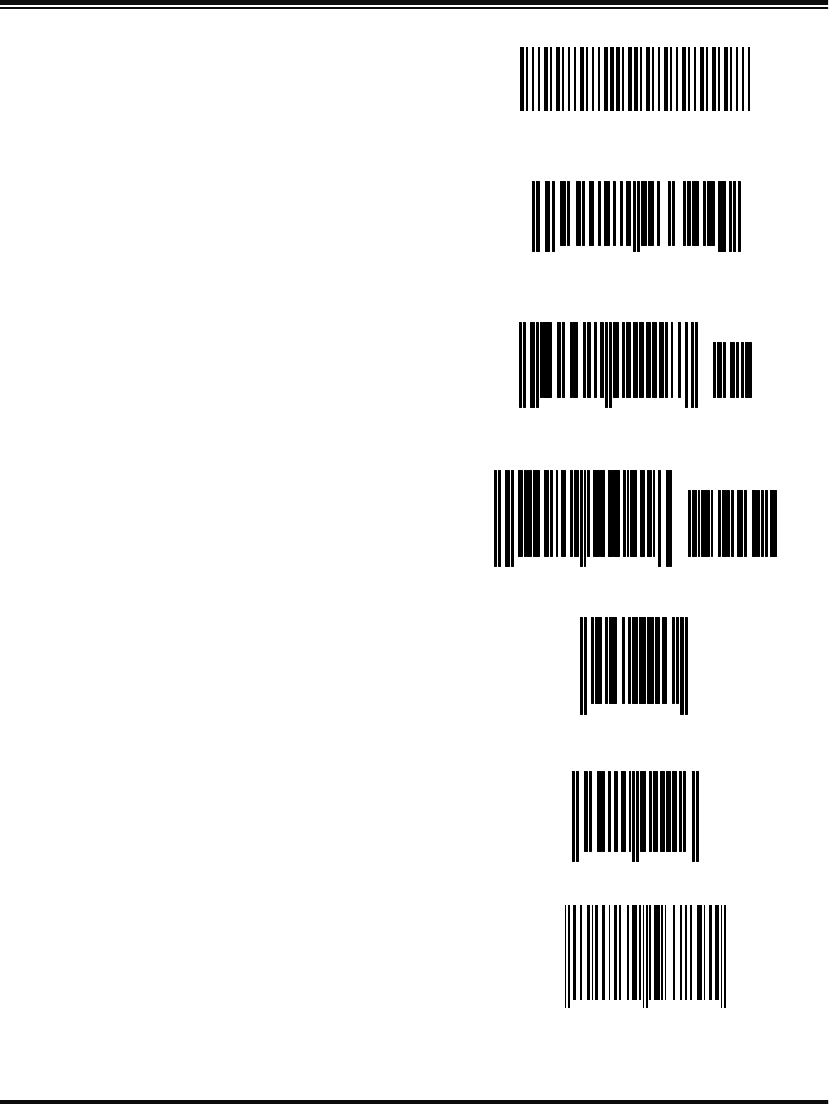
A-2 PowerScan™ RF Scanner
MSI/Plessey
UPC-A
UPC-A with 2 digit Add-on
UPC-A with 5 digit Add-on
UPC-E
EAN-8
EAN-13
14476925 4
0
00112 23344
0
49
0
60992 01118
7
69000
0
08029 51041
8
0 998875 0
0021 0126
1 101234 567891
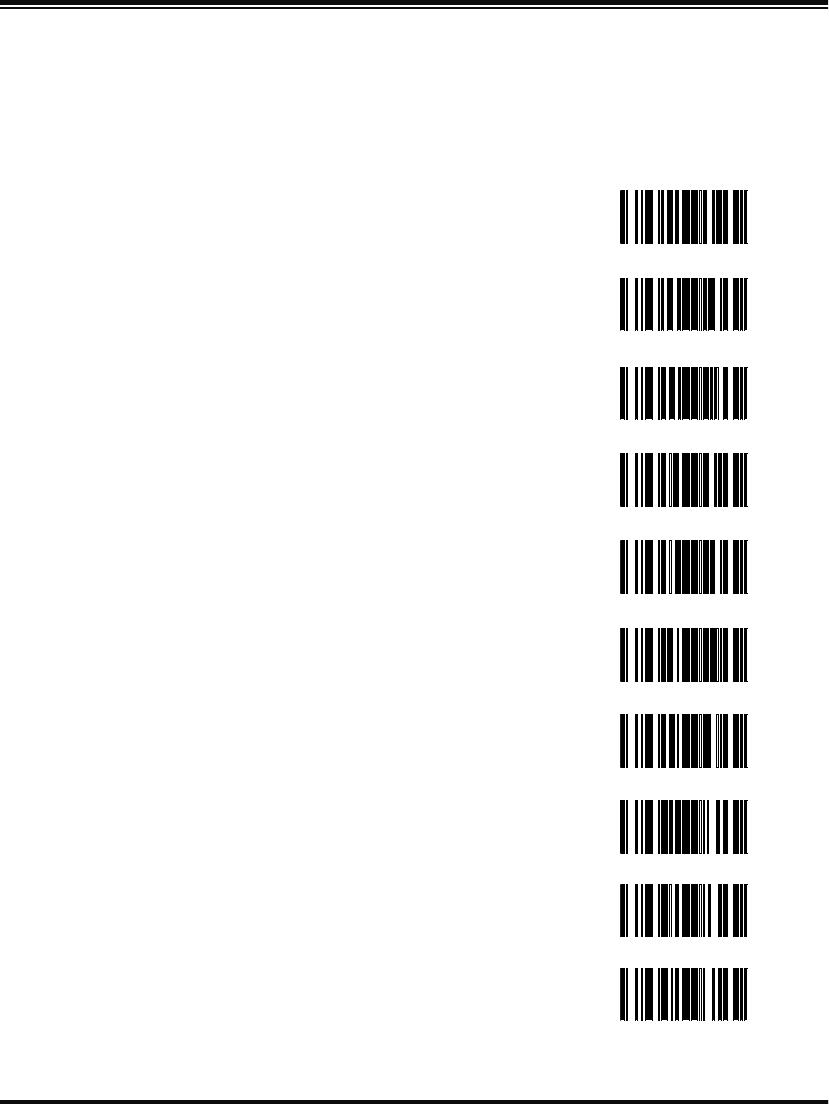
Systems Manual B-1
Appendix B
Number Pad
0 →
1 →
2 →
3 →
4 →
5 →
6 →
7 →
8 →
9 →

B-2 PowerScan™ RF Scanner
NOTES
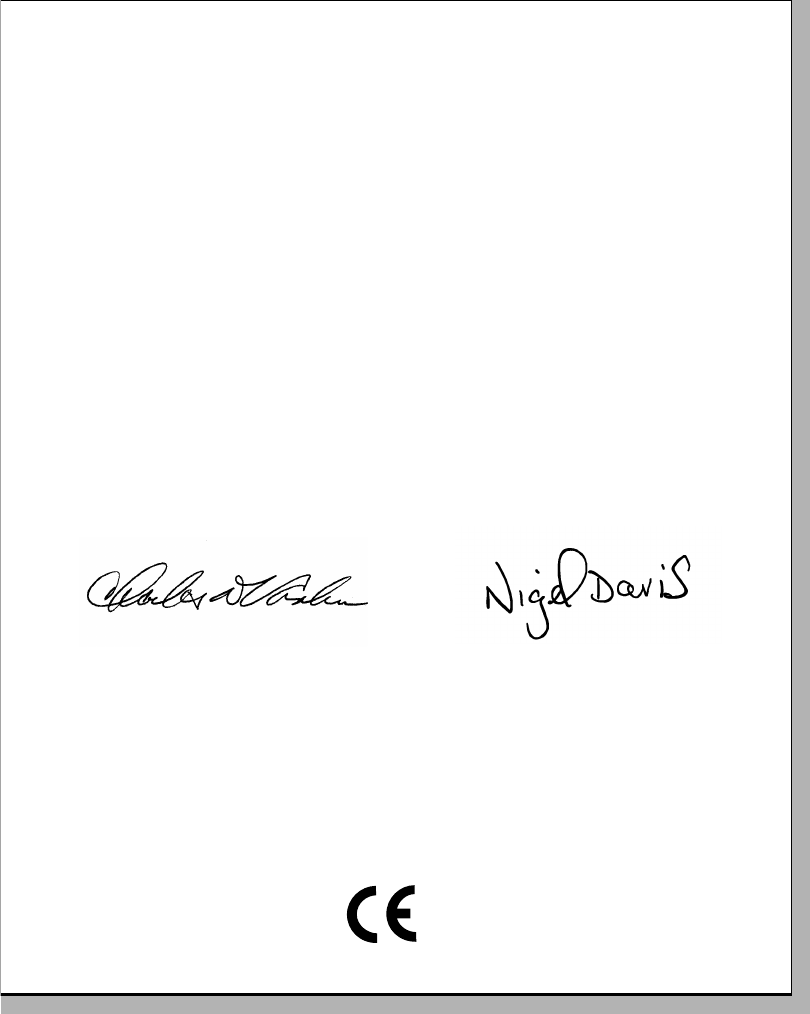
DECLARATION OF CONFORMITY
PSC hereby declares that the Equipment specified below has been tested and
found compliant to the following Directives and Standards:
Directives: EMC 89/336/EEC
Low Voltage 73/23/EEC
Standards: ETS 300 683 ETS 300 220-1
EN60825 EN50082-1 EN60950
Equipment
Type: Bar Code Scanning Equipment
Product: PowerScan™ RF Bar Code Scanner
Nigel Davis
Vice President
Europe, Middle East & Africa
PSC Bar Code Ltd.
Axis 3, Rhodes Way
Watford, England
WD24YW
UK
Charles W. Vanlue
Director, Corporate Quality
PSC, Inc.
959 Terry Street
Eugene, OR 97402
U.S.A.
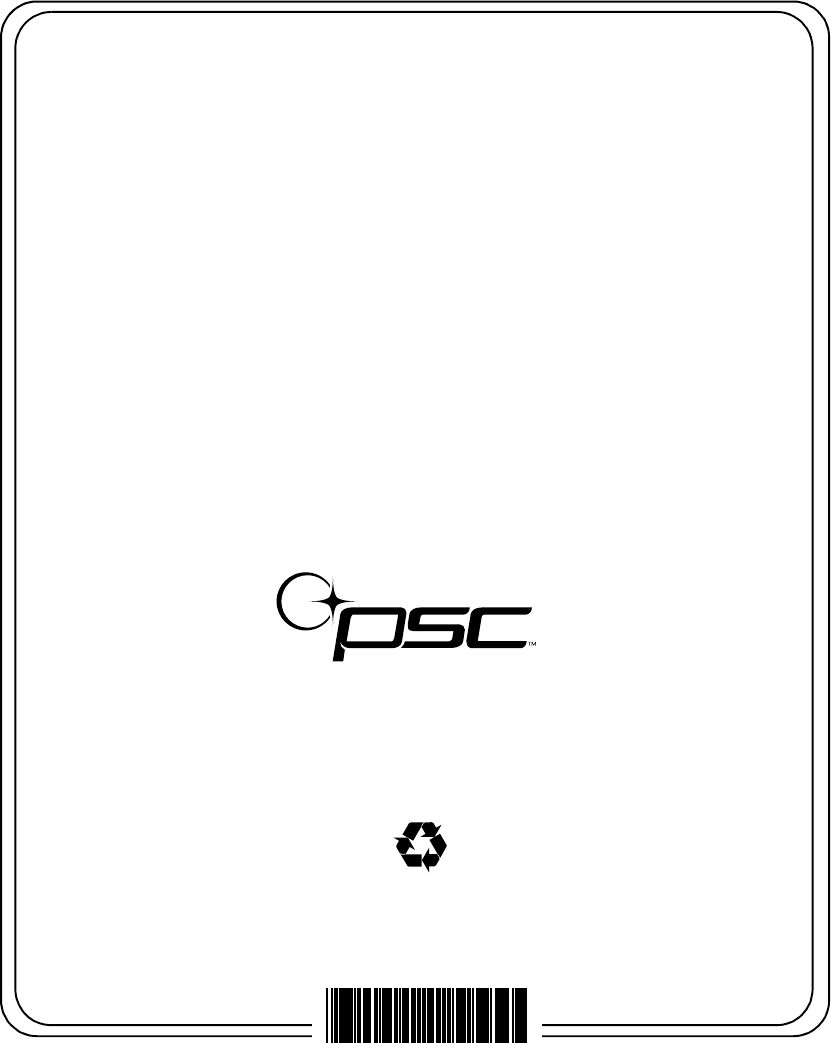
Asia Pacific
PSC Hong Kong
Hong Kong
Telephone: [852]-2-584-6210
Fax: [852]-2-521-0291
Australia
PSC Asia Pacific Pty Ltd.
North Ryde, Australia
Telephone: [61] 0 (2) 9878 8999
Fax: [61] 0 (2) 9878 8688
France
PSC Sarl
LES ULIS Cedex, France
Telephone: [33].01.64.86.71.00
Fax: [33].01.64 46.72.44
Germany
PSC GmbH
Darmstadt, Germany
Telephone: + 49 (0) 61 51/93 58-0
Fax: + 49 (0) 61 51/93 58 58
Italy
PSC S.r.l.
Vimercate (MI), Italy
Telephone: [39] (0) 39/62903.1
Fax: [39] (0) 39/685496
Japan
PSC Japan K.K.
Shinagawa-ku, Tokyo, Japan
Telephone: 81 (0)3 3491 6761
Fax: 81 (0)3 3491 6656
Latin America
PSC S.A., INC.
Miami, Florida, USA
Telephone: (305) 539-0111
Fax: (305) 539-0206
United Kingdom
PSC Bar Code Ltd.
Watford, England
Telephone: 44 (0) 1923 809500
Fax: 44 (0) 1923 809 505
Corporate Headquarters
675 Basket Road
Webster, NY 14580-9787
Telephone: (716) 265-1600
Fax: (716) 265-6400
PSC Scanning, Inc.
959 Terry Street
Eugene, OR 97402-9150
Telephone: (541) 683-5700
Fax: (541) 686-1702
Printed on recycled paper
www.pscnet.com
©2000 PSC INC. R44-2114 (Rev. C) Printed in USA (11/00)